257 Lamartine Street
It was mere chance that found Jamaica Plain Historical Society member Fran Perkins on Boylston Street that November day in 2009 when she met a group of people from New York, looking a bit lost, who were trying to find a house at 257 Lamartine Street where one of them had lived in 1930. Fran’s conversation with the group led to our story “A Holocaust Survivor Returns to Jamaica Plain” in which the house at 257 Lamartine plays a prominent role.
Soon after the writing of the Holocaust story began, another coincidence emerged. We received an inquiry from a family in Connecticut seeking information about one of their ancestors, a German immigrant, who lived and died in Jamaica Plain in the 1920s. The ancestor, Jacob C. Becker (aka Carl Becker), a veteran of the Spanish American War, lived at 267 Lamartine Street in 1920. His daughter, Emily, married a Lawrence R. Grove and they lived, of all places, across the street at 257 Lamartine Street, which became the home of our Holocaust survivor some ten years later! We tried, but failed to find a connection between the Groves and the Lessings, the family in the Holocaust story, other than they lived in the same house, 10 years apart. The Groves, of 257 Lamartine, had a daughter Lorna, who was the mother of our Connecticut respondent.
Moving from Lamartine Street, the family tradition says that Carl Becker lived in the Chelsea Soldiers’ Home. Sadly, after he moved to the Soldiers’ Home, the tradition says that during a visit back to 267 Lamartine in the late summer of 1924, a tenant there provided Carl with more homemade beer than he could handle and he wandered to Jamaica Pond, fell in, and drowned. 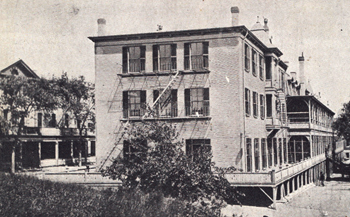 Chelsea Soldiers Home. Photograph courtesy of actonmemoriallibrary.orgThere is a Becker family plot at Forest Hills Cemetery with a headstone listing Carl along with his wife Paulina but the Cemetery has very little information about Carl. As the Becker descendants continued their search for information about Carl’s death they learned that their original belief that Carl lived in a Sailor’s Home near Egleston Square was incorrect. We had found no record of any such institution in Jamaica Plain, nor did the Naval History Library in Washington whom we queried about it. We suggested to the descendants that it might have been the Home for Aged Couples, near Egleston Square, that the Becker’s oldest living descendant (92) remembered as Carl’s residence after leaving Lamartine Street. We eventually learned that Carl did indeed live at the Chelsea Soldiers’ Home which was probably reached by public transportation from Egleston Square, which established the Egleston connection in the elderly descendant’s memory.
Chelsea Soldiers Home. Photograph courtesy of actonmemoriallibrary.orgThere is a Becker family plot at Forest Hills Cemetery with a headstone listing Carl along with his wife Paulina but the Cemetery has very little information about Carl. As the Becker descendants continued their search for information about Carl’s death they learned that their original belief that Carl lived in a Sailor’s Home near Egleston Square was incorrect. We had found no record of any such institution in Jamaica Plain, nor did the Naval History Library in Washington whom we queried about it. We suggested to the descendants that it might have been the Home for Aged Couples, near Egleston Square, that the Becker’s oldest living descendant (92) remembered as Carl’s residence after leaving Lamartine Street. We eventually learned that Carl did indeed live at the Chelsea Soldiers’ Home which was probably reached by public transportation from Egleston Square, which established the Egleston connection in the elderly descendant’s memory.
The coincidence of the house at 257 Lamartine playing a part in two family’s lives 80 years ago and then their stories coming to light almost simultaneously is, we think, very interesting, to say the least.
Peter O’Brien
April 15, 2010
90-year-old Cobbler Still Going Strong
By Peter O’Brien, April, 2010
What does a 1940’s type shoe repair shop, a fleet of World War Two B-17 Bombers, the Building 19 discount store in Norwood, Arthur Fiedler of Boston Pops fame and Jazz Maffie, the late Brinks bandit, have in common? And the answer is: 90 year-old cobbler Guy Perito, formerly of Sedgwick Street, Jamaica Plain!
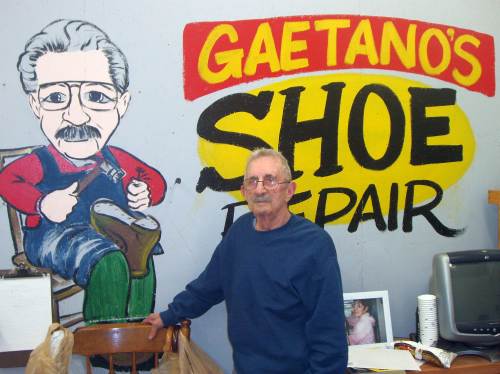 Guy Perito stands in front of a sign in his shop at Building #19
Guy Perito stands in front of a sign in his shop at Building #19
Guy Perito was born August 23, 1920 at Ritchie Street in Jackson Square, Roxbury. Jackson Square’s intersection of Centre Street and Columbus Avenue, under the watchtower on Fort Avenue, was then a busy gateway to Roxbury Crossing on Columbus Avenue and a shortcut to Dudley Street via Centre Street. Guy knew the Square and its diverse 1930s small businesses well.
His parents were Valentino of Naples and Grace of Sicily, Italy.
His younger siblings were Johnny, Mary, Rita and Leo. Leo fought at Anzio in World War II and has passed away.
Leaving Ritchie Street the Perito family moved to a three-decker with gaslights and an oil-fired black kitchen stove that heated the flat and cooked their meals at 9 Albert Street, Roxbury. Albert Street ran from Heath to Tremont Street alongside the old raised NYNH&H railroad track bed which was later depressed below grade as part of the aborted Southwest Corridor Project.
Guy went to the Blessed Sacrament grammar school and then on to Boston Trade School where he took the popular Auto Mechanic’s course, graduating in 1939. He then took Machine Shop courses at Wentworth Institute, learning the various machine shop tools and processes. His favorite subjects in school were math, history and of course, shop. Due to his mother’s vigilant oversight of his schoolwork he was a pretty good student and was determined to never bring home an unsatisfactory report card for her signature… and he never did. Guy goes to his Trade School reunions, but notices the attendance is dwindling now. (Not many make their 70th year class reunion!)
His school years’ activities included singing in the Blessed Sacrament choir and many hours in the gym. He was an avid member of the Roxbury Boy’s Club and remembers swimming there and playing table-pool at the younger kids’ tables which featured thick wooden discs instead of ivory balls, played on a bare wood table without felt covering. He also played sandlot football for the “Pirates” and frequently enjoyed the matinees at the famous “spit box” (the Madison Theatre on Centre Street was known by many different names, depending on your neighborhood.)
Guy discovered a love of the drums and played in the Trade School drum and bugle corps as it marched in the annual Boston Schoolboy Parade. He was good enough to earn an audition for the All American Youth Orchestra. The Massachusetts’ auditions were handled at the time by Arthur Fiedler of Boston Pops fame. Guy didn’t make the cut but he certainly enjoyed meeting the famous conductor.
Guy’s father, Valentino, was a skilled shoemaker making hand crafted shoes in a shop in Needham for the affluent professionals in that town. He had learned the trade in Italy and was never out of work, even during the Great Depression. Notwithstanding his relatively secure circumstances, Guy remembers writing to the Boston Post (newspaper) Santa with a list of wanted toys, which he thinks Santa fulfilled. Thanks to Valentino’s skill however, the family weathered the Depression’s worst years in modest comfort.
Valentino commuted to Needham by public transportation until Guy bought his first car, a ‘32 Chevvie for $15 at a Jackson Square gas station. Repairing its broken axle himself, he was able to drive his dad to work much of the time. Guy has been driving since he was 16, and continues driving as he nears his 90th birthday.
Valentino eventually bought the shoe shop in Needham from its owner, Rocco Perrara, with money Guy had saved. Guy then learned the shoe-making and repair business from his father, never dreaming that one day he’d enter the declining field of shoe repair.
Guy’s working life started very young, as was the case for most youngsters in the 30s and 40s. He remembers selling the Daily Record for three cents, or a 100% markup on the penny and half he paid the distributor. In those days the paperboys could ride the El, streetcars and busses free with a Newsboy’s pass to sell papers to the commuters. The second of the two daily editions of the Record, called the “Payoff Edition,” was the more popular because it contained the daily “number” that yielded a 600 to 1 payoff on a bet with the local bookie.
Despite possessing a solid auto mechanic’s training from Boston Trade School, Guy thought he wanted to be a fireman. So, with an uncle’s encouragement, he enrolled in the Firefighter’s course at MIT and he did well in it. However, when the Boston Fireman’s test day came, Guy, upon reaching the front door at Fire Headquarters, decided he didn’t want it after all.
During his growing up years, Guy had developed a love of airplanes and built many models, starting with the simple penny balsa gliders and moving on to the more complex paper covered kit models of the famous World War One Spads, Sopworth Camels, Fokkers and other “double wingers” of that era. The fascination with airplanes grew and was fully realized when he entered the Army Air Force and became a World War Two B-17 bomber mechanic. The B-17 was one of the toughest war planes ever built and Guy loved every moment working on them from 1942-46 in Selma, Alabama. Selma then was just a small southern city, pop. 20,000, and the site of a famous Civil War battle. Twenty years later it was a major battlefield in the Civil Rights Movement of the 60s.
After the war Guy went to work for a series of auto repair shops in the Roxbury, Jamaica Plain and West Roxbury areas. Between automotive jobs he tried machine shop work and he even tried plastering for a while. His uncle Angelo owned the barbershop next to the Jamaica Theatre, above the bowling alleys, where Mayor Curley regularly had his hair cut and Guy considered that line of work also (i.e. barbering, not mayoring.) As the post war boom continued and he was getting steady work, he met Shirley (Tibbetts) of Lowell at the Clarke and White auto dealership on Commonwealth Avenue in Boston where she was working as an assistant to the Service Manager. They were married and in 1953 they moved to a three-decker on Sedgwick Street, directly across from the Jamaica Plain Branch Library. Guy knew Sammy Klass’ shoe repair shop around the corner on South Street. Sammy had a very busy shop because in those days shoes saw several reincarnations before a trip to Ed Hanlon’s for a new pair.
The Peritos had three children and three grandchildren. All of the children have advanced degrees and are working in responsible careers, making their dad very proud. In the mid-fifties Guy and Shirley moved to Needham where they live now.
After nearly 45 years in the automotive world, Guy grew tired of it and decided to try a new career. With his Dad’s training many decades earlier, Guy found a job in a shoe repair shop in Stoughton. He discovered that he liked it very much, especially the customer interaction, as he loves to talk and make new friends. The owner of that shop retired and Guy bought the tools and equipment. In the late eighties, Paul London, the shoe buyer for the Building 19 discount store chain, asked Guy if he’d be interested in opening a shoe repair shop in Building 19¾ on Route 1 in Norwood. Guy agreed and moved his newly acquired equipment in and he has been fixing shoes and meeting new friends there ever since as “Shoe Repair by Gaetano.” (Guy in Italian = Gaetano.) Over the intervening years he’s met the inimitable Jerry Ellis, one of the founders of the Building 19 organization and many other locally prominent people.
Nearing 90 now, Guy has no intention of stopping what he loves to do. His weekly “club” meeting, which he presides over, meets each Saturday in Shoe Repair by Gaetano’s at Building 19¾. The group includes friends from as far back as his Jackson Square days and newer friends he’s met in his Building 19 shop. The diverse group makes for lively and fun talk with much reminiscing and a challenge or two about a date or a place or a long-past event or person of note. The discussions, with frequent interruptions by customers picking up and dropping off shoes, range from the finer points of the 1940s pizza at Napoli Café on Columbus Avenue to where one could get a pint on a Sunday morning to the appropriateness of Jazz Maffie’s (several knew him) 18 year prison sentence at Walpole and just where did that Brinks money really go and what was the name of that restaurant on Broadway in Southie (Amrhreins?)
Guy knew Jazz Maffie and his family very well when the Maffie’s were living at the foot of Parker Hill near Heath Street. He and the others all said Jazz was a very well-liked and friendly fellow.
Some of the weekly “club” attendees are Catherine “Kay” Desimone, Emmet Tynan, John Tighe, Chester Wallace, and Rick Sidorowicz aka Mr. Sid, the former Dedham clothier. The whole scene is like a modern version of the old-time paintings of weathered, pipe smoking oldtimers sitting around the pot-belly stove in a country store, whittling and chewing the fat.
As he looks back, Guy’s fondest memory of Jamaica Plain is the 4th of July festivities at Jamaica Pond. He thinks the computer, television and the cell phone are the major innovations he’s seen in his lifetime and he’s conversant with all three. He attributes his long life and excellent health to a good wife, a healthy diet (with very little meat,) swimming and plenty of walking before he had both hips and a knee replaced. He is encouraged by the fact that some people still want to learn the shoe repair trade and he will be training a new hire very soon.
Guy and Shirley were big fans of the Julia Child and Jacques Pepin cooking duo and they like to cook and bake bread for each other, although more modestly than Julia and Jacques. They’ve slowed their social life down a bit, but being crazy about each other, they enjoy each other’s company and the slower pace is comfortable for them.
Guy Perito is a happy man and he looks forward each day to the challenges, chit-chat and drop-in visitors at Shoe Repair by Gaetano’s.
[Editor’s note: Guy Perito passed away on June 6, 2014. He was 93. ]
A 1941 Ford in Jamaica Plain
In 1952, I was making 50 cents an hour at C.B. Rogers’ drugstore and had saved some money. I bought a used 1941 Ford. It was dark blue. It was one of the last models that Ford made before WWII ended all American car production during those years. I paid $60 for it.
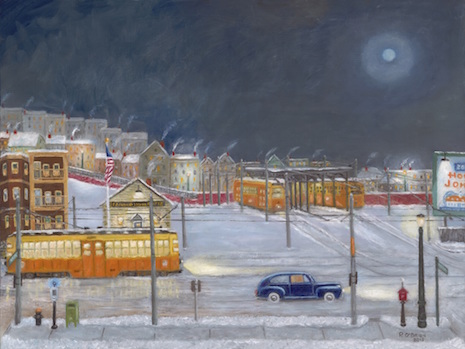 Painting by Peter O’Brien Copyright © 2015, All Rights Reserved. Click on the image to see it larger.
Painting by Peter O’Brien Copyright © 2015, All Rights Reserved. Click on the image to see it larger.
The dashboard was rusty so I painted it maroon and grey with house paint from Yumont’s Hardware store in Jamaica Plain. Yumont’s is still there. The passenger-side window was missing, so dates at the Dedham Drive-In movie theater were interesting. During snowfalls I put cardboard in the opening.
I learned that you could start a car by pushing it and letting the clutch out at the right moment. I did that a lot. Used cars were advertised in those days with, or without, R&H (radio and heater). I had the H but no R. A man at work sold me a radio from a 1936 Buick for $3 and I rigged it up under the dashboard and installed a coat-hanger antenna. It blew a lot of fuses though.
I put a rebuilt engine in the car after a year or so of breakdowns, black smoke pouring from the exhaust, and grinding noises. Precision Motor Rebuilders in Somerville did the work. I think it cost $295 plus my old engine. I don’t remember where I got the money.
The Ford became a communal car. Anyone in the gang could use it if they had gas money. Gas in those days cost 19 cents a gallon.
One day, several of us packed in and we went to Atlantic City. We barely had enough money for a ten-cent hot dog when we got there. Perhaps it was at Nathan’s. I don’t remember. We stayed overnight and slept under the boardwalk. The next day we came home on the Merritt Parkway in Connecticut and we had a flat. The State Police stopped to ask if we needed help. I said no. (I had changed a flat tire once before on the night I bought the car.) We nearly tipped the car over using the bumper jack on the steeply sloped embankment of Merritt Parkway. It was a fun trip though.
Before I had a car I went everywhere by streetcar. Some streetcars were parked in a terminal on South Street, up at the end of our McBride Street. McBride enters South on the right in the picture. The side-entrance streetcar on the far left is coming from the Arborway Terminal, heading into Boston. The two streetcars in the South Street Terminal went back and forth to Dudley Street in Roxbury. The streetcar cost five cents for students, and ten cents for others.
We called the South Street Terminal the “Car Barns,” because fifty years earlier a big barn housed the streetcars behind the billboard. However, its official name was the “Jamaica Plain Loop.” A carnival came every year to the former car barn lot. There’s a housing project there now. The Jamaica Plain Loop is long gone and the American Legion Post No. 76 and its flagpole have moved away too.
I joined the Army in 1954 and never saw the car again, until now.
Peter O’Brien
Copyright © 2015, All Rights Reserved
A German Tourist in 1916 Jamaica Plain
This is the story of a personally conducted tour through Jamaica Plain. It began about 6:45 last evening, and it lasted for about two and one half hours. And if there were any streets that escaped, it wasn’t the fault of patrolman Joseph Cunningham of Station 13, the conductor, or Mrs Louisa Cline of 16 Dixville St., South Boston, the conducted.
The tour began in this wise: Patrolman Cunningham was walking along Burroughs St. a few minutes before 7 o’clock when a woman rushed up. "Aber, wo ist das? —" and she trailed off into the mysteries of German. Patrolman Cunningham had left his German at home on the piano. After a desperate attempt he gathered that she was looking for 8 Amory St.
As she seemed at a loss, he decided to take her to the address. And just here the tour began. When the tourists got to 8 Amory St. they found that it was the wrong place. Patrolman Cunningham asked her who the people were she was to meet. She didn’t know. Then she had an inspiration. It wasn’t Amory St. after all. It was Burroughs St.
Back the party went. They hunted up 8 Burroughs St. No use; they were wrong again. Cunningham strove again to get the name of the person sought by Mrs. Cline. She couldn’t remember it. But she thought that the street might be Parkman St. The tour now turned to that highway, but there was no one at No 8. Certainly that wasn’t the place.
The next inspiration of the conducted was South St. By this time Patrolman Cunningham was getting his stride. The preliminary had been mere play. He decided that they would begin at the car barn and "do" every street in the vicinity. They did. And when it was all over, although the conductor was a willing guide, he decided that he had done his share of walking for about a month, so the tourists turned toward the police station.
Lt. Riordan was flabbergasted when the party arrived. Mrs. Cline overwhelmed him with a torrent of German. He hurried to the desk and rang for the sole German policeman in the station. But that gentleman was floored by Mrs. Cline as easily as the others.
Finally, after nearly 15 minutes questioning, Lt. Riordan managed to inform the conducted that she was not under arrest. He only wished to know where she lived. And as soon as he extracted that bit of information, he got busy with the telephone.
Twenty minutes later a man and woman entered the station. They were Mr. and Mrs. W. Heinmann of 8 Enfield St, Jamaica Plain. They were in a great to do. They had arranged to meet - "Ach, ya! Aber es ist das Enfield St." came an excited voice from the seat near the wall where Patrolman Cunningham and the conducted were seated. And then followed an excited and heart-gladdening greeting.
After the matter had been all straightened out, and the two ladies and Mr Heinmann had closed the door behind them and walked down the steps, Patrolman Cunningham stood up and scratched his head. "Well, I’ll be darned."
A Holocaust Survivor Returns to Jamaica Plain
How a chance meeting on JP’s Boylston Street reveals a Holocaust survivor’s brief connection with Jamaica Plain 80 years ago.
By Peter O’Brien, December, 2009
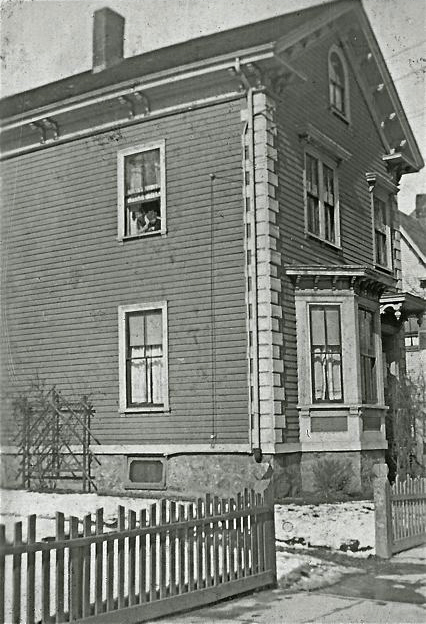 Ed looks out the window of 257 Lamartine St. in 1931A member of the Jamaica Plain Historical Society happened to be on Boylston Street in early November 2009 and, by chance, met a couple from Hastings on Hudson, New York, who were looking for a certain house on Lamartine Street. The couple, Edward Lessing and his wife Carla, were looking for the house at 257 Lamartine where Ed had lived in the early 1930s. After a short residence there, Ed Lessing’s story took many turns with several unplanned surprises including life-threatening experiences with the Nazis and his mother’s internment in a notorious concentration camp during World War II. This amazing story about a Dutch family displaced by the Holocaust and happily reunited after the war, might never have happened if the patriarch, a cellist, could have found work and remained in Jamaica Plain during those pre-war depression years.
Ed looks out the window of 257 Lamartine St. in 1931A member of the Jamaica Plain Historical Society happened to be on Boylston Street in early November 2009 and, by chance, met a couple from Hastings on Hudson, New York, who were looking for a certain house on Lamartine Street. The couple, Edward Lessing and his wife Carla, were looking for the house at 257 Lamartine where Ed had lived in the early 1930s. After a short residence there, Ed Lessing’s story took many turns with several unplanned surprises including life-threatening experiences with the Nazis and his mother’s internment in a notorious concentration camp during World War II. This amazing story about a Dutch family displaced by the Holocaust and happily reunited after the war, might never have happened if the patriarch, a cellist, could have found work and remained in Jamaica Plain during those pre-war depression years.
The Lessings Leave Holland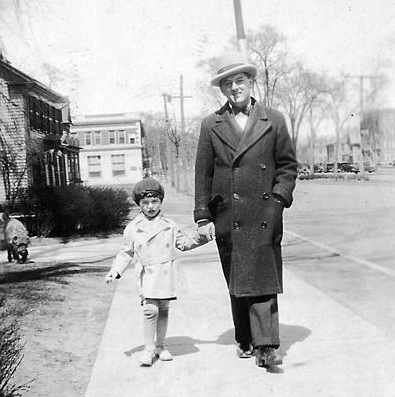 Ed with his father in BostonThe story starts in 1929 when a Dutch Jewish couple, Nathan ‘Nardus’ Lessing, his wife Engeline ‘Lien’ Elizabeth, (nee van Leer,) and their three-year old son Eddie arrived in America. They were greeted by Lien’s sister, Suze and her husband David (Cohen) van Leer who had emigrated to the United States earlier and had settled in what was then the most Catholic (97%) city in the USA; Holyoke, Massachusetts. They tried fruitlessly to rent an apartment there until a friend told them that with a name like Cohen, they would never succeed. David and Suze then changed their name, legally, to van Leer and never thereafter told anyone that they were Jewish. David van Leer worked in a typography company while Suze worked as a bookkeeper. The van Leers never left Holyoke.
Ed with his father in BostonThe story starts in 1929 when a Dutch Jewish couple, Nathan ‘Nardus’ Lessing, his wife Engeline ‘Lien’ Elizabeth, (nee van Leer,) and their three-year old son Eddie arrived in America. They were greeted by Lien’s sister, Suze and her husband David (Cohen) van Leer who had emigrated to the United States earlier and had settled in what was then the most Catholic (97%) city in the USA; Holyoke, Massachusetts. They tried fruitlessly to rent an apartment there until a friend told them that with a name like Cohen, they would never succeed. David and Suze then changed their name, legally, to van Leer and never thereafter told anyone that they were Jewish. David van Leer worked in a typography company while Suze worked as a bookkeeper. The van Leers never left Holyoke.
A New Friend Tries To Help
Nardus Lessing, an accomplished cellist, had studied at the Music Conservatory in The Hague, Netherlands, until his father told him that he had had enough education and he should now find a job in music somewhere. He was soon hired as a member of a musical trio on a ship that sailed for Cuba. He also made several working trips to New York on ships of the Holland-America Line. A few times he visited his sister-in-law Suze and husband David van Leer in Holyoke during his New York layovers.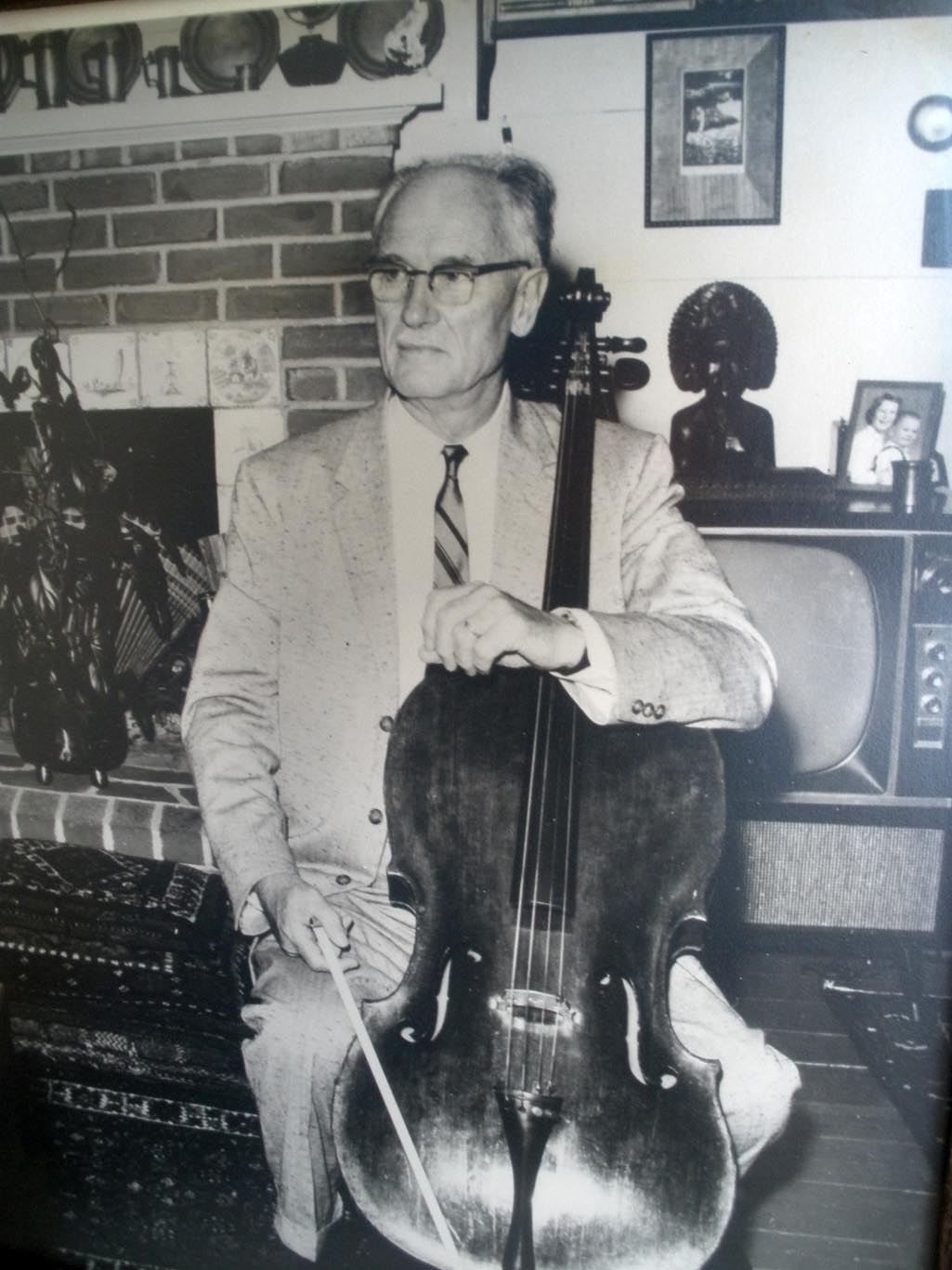 Jacobus Langendoen with celloWhen the family emigrated, Nardus had hoped to find steady work in America through Jacobus ‘Jaap’ Langendoen, a Dutch cellist with the Boston Symphony Orchestra (BSO), which was then under the direction of Serge Koussevitzky (1924-1949). The family tradition is that Nardus may have met Jaap through his sister-in-law, Suze van Leer, of Holyoke. Langendoen at that time lived at 17 Pearl Street in Dorchester. Jaap’s granddaughter, Heidi Langendoen, of Wakefield, Massachusetts, fondly recalls her grandfather as someone who would try very hard to help another musician and that he mentored many young musicians over his long career. She remembers hearing about his summer work playing at the Wentworth Hotel in the town of New Castle, New Hampshire. Later, the Langendoen’s bought a house and resided there for many years.
Jacobus Langendoen with celloWhen the family emigrated, Nardus had hoped to find steady work in America through Jacobus ‘Jaap’ Langendoen, a Dutch cellist with the Boston Symphony Orchestra (BSO), which was then under the direction of Serge Koussevitzky (1924-1949). The family tradition is that Nardus may have met Jaap through his sister-in-law, Suze van Leer, of Holyoke. Langendoen at that time lived at 17 Pearl Street in Dorchester. Jaap’s granddaughter, Heidi Langendoen, of Wakefield, Massachusetts, fondly recalls her grandfather as someone who would try very hard to help another musician and that he mentored many young musicians over his long career. She remembers hearing about his summer work playing at the Wentworth Hotel in the town of New Castle, New Hampshire. Later, the Langendoen’s bought a house and resided there for many years.
The kindly Jaap Langendoen will appear again after the war to help another member of the Lessing family.
Untimely Illness
Unfortunately, Jaap Langendoen’s helping hand could not be accepted because Nardus contracted tuberculosis and was hospitalized in Holyoke. There was a small 50-bed Holyoke City Sanatorium on Cherry Street, Holyoke, which had been under the direction of Dr. Carl Rosenbloom. The 1930 census lists Nathan Lessing and several other patients and staff as residents at the Holyoke City Sanatorium. In those days before effective TB drug therapy was developed in the early 50’s, patients’ recovery rates were not good.
Following this health disaster, Nardus’ wife, Lien, and their son Eddie, found themselves living in a two-family house at 257 Lamartine Street, Jamaica Plain.
Only in America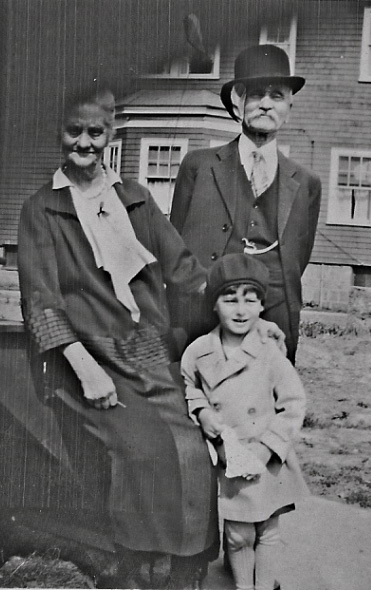 Ed’s ‘adopted’ grandparentsLien, a very enterprising former telegraph operator, first of all searched for and found an elderly couple to take care of Eddie during the daytime. Eddie fondly remembers them only as Grandma and Grandpa, a kindly couple whose surname cannot be recalled.
Ed’s ‘adopted’ grandparentsLien, a very enterprising former telegraph operator, first of all searched for and found an elderly couple to take care of Eddie during the daytime. Eddie fondly remembers them only as Grandma and Grandpa, a kindly couple whose surname cannot be recalled.
Lien then found employment with Mr. Ben Franklin Allen who owned a small travel bureau called “Allen Tours” on the second floor at 154-156 Boylston Street, Boston, a six-story building located across from Boston Common between Tremont and Charles Streets, in what is now the Piano Row Historic District. The first floor at 156 Boylston Street was occupied by the New England Piano Company. Ben Franklin Allen lived at 12 Commonwealth Avenue, Boston.
Ed Lessing clearly remembers Allen’s name because of an incident his mother related much later. It seems a former travel client sent a letter addressed to Mr. Allen at “Allen Tours.” Lien opened it and it read: “Dear Mr. Allen, - I do not know anyone whom I hate enough to let him suffer one of your tours! Sincerely etc.” Lien, torn between duty and fear of an executive outburst finally got up the courage to hand the offending letter to Mr. Allen. As she said years later, “I could not believe what happened. Mr. Allen read the letter twice, then burst out in uncontrollable laughter and shouted, ‘The best letter I ever received. Let’s frame it!’ And so it was done, and Mr. Allen proudly hung it over his own desk.” Eddie always remembered this story as proof that there was no country in the world like America where such a thing could happen!
Health Restored
In 1931, in what was a very lucky outcome for the period, Nardus recovered. He then found summer work through Jaap Langendoen, as a cellist with 11 other members of the BSO, at the grand Wentworth Hotel in New Castle, New Hampshire. 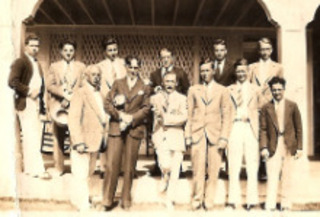 BSO group at Wentworth in 1931The family moved to New Hampshire and enjoyed a happy summer there while that music engagement lasted, remaining hopeful that a more permanent job in music could be found. Ed Lessing’s photographs from that memorable summer show him playing in the water with his mom. Nearly 80 years later, on their way to a conference in Boston, Ed and Carla Lessing stayed at the same Wentworth Hotel and presented them with a picture of those summer of ‘31 musicians, which included Ed’s dad, Nardus Lessing.
BSO group at Wentworth in 1931The family moved to New Hampshire and enjoyed a happy summer there while that music engagement lasted, remaining hopeful that a more permanent job in music could be found. Ed Lessing’s photographs from that memorable summer show him playing in the water with his mom. Nearly 80 years later, on their way to a conference in Boston, Ed and Carla Lessing stayed at the same Wentworth Hotel and presented them with a picture of those summer of ‘31 musicians, which included Ed’s dad, Nardus Lessing.
As the depression deepened permanent work could not be found, and in 1932, three years after their arrival, and with only the summer work at Wentworth Hotel and Lien’s job at Allen Tours having sustained them, the Lessings had to return to the Netherlands.
Back Home in Holland
After their return, the Lessings finally settled in the small historical town of Delft, located near Rotterdam. Delft is noted as a most typical Dutch town with a canal passing right through the town center. It was the home of the noted painter, Johannes Vermeer and the world-famous Delft pottery.
The Lessings, struggling through the depression at whatever work that could be found, had three more sons, one of whom died at nine months.
World War II Arrives in Holland
By May 1940, the Lessing family of Nardus, Lien, Eddie (14), Arthur ‘At’ (6) and Alfred ‘Fred’ (4) had become part of the community living on the canal in Delft. At that time Hitler’s troops overran Holland’s little democracy and installed a Nazi government there led by a friend of the Führer, The Reichskommissar for the Occupied Dutch Territories, Dr. Seyss Inquart, who was hanged after the war as a war criminal.
As a non-religious, though, nevertheless, a Jewish family, the Lessings found themselves in immediate danger. It took the Nazis just three years in Holland to accomplish what they did in their own country in six years, i.e. to destroy the age-old Jewish communities by murdering its members, irrespective of age or gender, in death camps located in Nazi-occupied Poland.
Nardus and Lien saw that the only way to survive with their three boys was to go into hiding from the Gestapo, the Secret German Police. Thus, on October 22, 1942, the Lessings dispersed and disappeared. 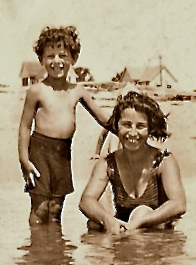 Ed with his mother in New Hampshire in 1931At that point, Eddie’s mother, Engeline Elizabeth Lessing/van Leer changed from housewife to heroine, fighting to save the lives of her entire family. First, she secured a false ID card with a new name from the Dutch Resistance. She then began to travel through Holland with the false ID on the extremely dangerous, constantly Gestapo-patrolled trains to find hiding places for her sons, her husband and herself.
Ed with his mother in New Hampshire in 1931At that point, Eddie’s mother, Engeline Elizabeth Lessing/van Leer changed from housewife to heroine, fighting to save the lives of her entire family. First, she secured a false ID card with a new name from the Dutch Resistance. She then began to travel through Holland with the false ID on the extremely dangerous, constantly Gestapo-patrolled trains to find hiding places for her sons, her husband and herself.
At great personal risk, she succeeded in placing all in fairly secure locations with trusted Dutch families. Lien and Nardus were taken in by a brave gentile family who hid them for two years. As the war wore on, however, Lien had to find new safe houses for her younger sons Fred, aged six, and At, aged eight.
Rescued From the Nazis
Her eldest son, Eddie, 17, wound up with a group of Dutch Resistance men in their headquarters hut in the woods in the center of Holland, near the tiny village of De Lage Vuursche, in the Dutch province of Utrecht. At dawn on December 29, 1943, German forces arrived to arrest and/or kill the Resistance group. Eddie was standing watch at the time and he and his partner barely had time to warn the six men sleeping in the hut and save themselves. The men quickly dressed and scattered into the forest.
As part of a contingency plan in the event of such a raid, at eight o’clock that evening, Eddie and his partner went to a designated meeting place in the woods, about seven miles from the hut, where they hoped to meet any survivors of that morning’s raid. At the meeting place they were armed with 9mm Mauser pistols in case of a surprise German attack. Soon, in the pitch-black darkness, someone arrived on a bicycle. Fearing that it was a German trap, Eddie and his friend held their fire. And they were thankful they didn’t shoot when they discovered that it was neither the survivors of the raid on the hut nor German troops that had arrived, but to their astonishment, the bicyclist was found to be Eddie’s mother, Lien!
Lien explained to Eddie that as soon as she heard about the raid on the hut, she “immediately decided to try and rescue you.” She then explained that they were completely surrounded by a large circle of Wehrmacht and SS troops looking for them and that they should immediately bury their weapons to avoid being killed when arrested.
When the weapons were buried, Eddie’s partner accepted Lien’s bicycle and flashlight and left to find a hiding place leaving Eddie and Lien standing in the dark, surrounded by Germans. At this moment, Lien conceived a desperate plan to survive as they walked towards the encircling German troops waiting to capture them. They soon came to a German soldier pacing with a shouldered rifle and immediately executed Lien’s plan. Tightly hugging each other in an embrace with heads close together they began talking and laughing loudly, while making kissing sounds. As they approached the German soldier, they waved to him with a wide smile on their faces and ice-cold fear in their hearts. He stopped them with a loud HALT! - - - and they kept the grins on their faces as he made up his mind. It was at that moment a life or death decision for the two of them. Suddenly he shouted, “Nah also, gehen sie!” (Now then, get going) as he waved them on. They thanked him profusely with many loud “Danke schons” (thank you’s) and thus they walked out of that circle of death to live another day.
Bergen-Belsen Concentration Camp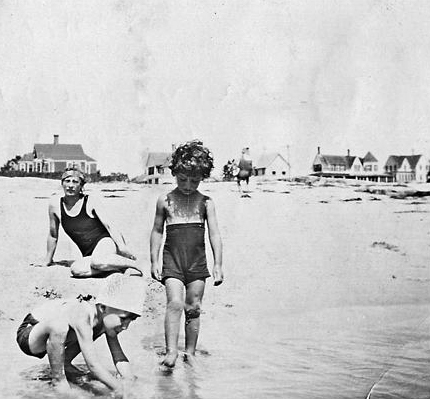 Ed (standing right) with Leni Langendoen (in the background)In May 1944, Lien was on her way to find a new hiding place for her youngest child, Fred, when she ran into a Gestapo specialist on a Dutch train. He immediately recognized her false ID card and she was arrested. She was put in a separate train compartment with a civilian Dutch police officer to guard her on her way to Gestapo Headquarters in Amsterdam. Realizing that she had all the family members’ hiding-place addresses in her handbag, she surreptitiously tore each piece of paper in shreds, chewed it up and swallowed it, to arrive in front of the Gestapo interrogators with only her false ID card.
Ed (standing right) with Leni Langendoen (in the background)In May 1944, Lien was on her way to find a new hiding place for her youngest child, Fred, when she ran into a Gestapo specialist on a Dutch train. He immediately recognized her false ID card and she was arrested. She was put in a separate train compartment with a civilian Dutch police officer to guard her on her way to Gestapo Headquarters in Amsterdam. Realizing that she had all the family members’ hiding-place addresses in her handbag, she surreptitiously tore each piece of paper in shreds, chewed it up and swallowed it, to arrive in front of the Gestapo interrogators with only her false ID card.
“Who are you?” she was asked. “I am Engeline Elizabeth van Leer”
“Do you have a husband?” “Yes, he is in the U.S. Merchant Marine.”
“Do you have children?” “No, I have no children.” And then, out of the blue, she shouted, “You have no right to keep me here. I am an American citizen!”
The Gestapo agent, having heard every Jewish excuse to prevent their imprisonment or death, asked her the next question: “Well, Mrs. van Leer, if you are, as you claim, an American citizen, you have, no doubt, no problem giving us an address where you have lived or where your husband lives in the United States?” And she, with unfailing memory of 1931, answers the Gestapo interrogators: “No, I have no problem - - 257 Lamartine Street, Jamaica Plain, Boston, Massachusetts.”
As the interrogator wrote down her response, Lien heard a German officer behind her saying, “Well, that’s no fake, she knows where she lives.” Nevertheless, she was eventually sent to the infamous Bergen-Belsen concentration camp in northern Germany where she managed to barely stay alive by getting a night job in a kitchen where she could sometimes steal half a potato.
Then, one morning in January 1945, returning at dawn to her barracks, she is told by her bunk-friend to present herself to an SS officer who is checking on people with foreign nationalities. “Why?” she asks. “You told them you are an American,” her friend answered. Lien responded, “You know, I just made it up,” but her friend nevertheless urged her on and Lien presented herself to the SS guard. He checked a list and told her that in two days she’d be on a transport out of the camp, to be exchanged for a German citizen.
Two days later, with 300 other sick and dying prisoners of Bergen-Belsen concentration camp, she was put on a train that traveled to St. Gallen, a border town in northeastern Switzerland, where they were exchanged; ironically, for Germans coming from Palestine where they had been interned as enemies by the British.
Lien chose not to go to her sister Suze in America, but rather to stay in a United Nations Rehabilitation camp, winding up in Camp Jeanne d’Arc, in Algiers on the North African coast.
When the war finally ended, Lien hitchhiked a ride on an American bomber and was reunited with Nardus, Ed, At and Fred once again in Delft.
Starting Again in America
Soon after the war, the Lessings again immigrated to America. All except 21 year old Ed, settled in Springfield, Massachusetts, where Nardus taught cello, Lien became a buyer in a hardware store, and Ed’s brothers At and Fred attended college; both becoming professors of philosophy.
Ed’s brother, At, however, had earlier considered a career in music and actually took cello lessons for a year from none other than Jaap Langendoen! At recalls that every Sunday he would take the bus to Newton Upper Falls and have his lesson from Jaap who was expert in the bowing of the cello and the instrument’s technical demands. Jaap’s wife, Leni, would then serve a hearty lunch for the three of them. Jaap would then head for his BSO matinee and drop At off at the bus station. On the way, At would ask Jaap what music was to be played that afternoon and Jaap would reply, “I’ll find out when I get there!”
Continuing his help to the Lessings, Jaap Langendoen got At a full summer scholarship in 1954 to study with the BSO at Tanglewood where Leonard Bernstein was conductor of the student orchestra. However, realizing that music was not to be his life’s work, At began a new life that fall and went on to study at Wesleyan. He never stopped playing the cello, however, and to this day uses finger warm-up techniques taught him by his respected mentor, Jaap Langendoen.
Ed Lessing pursued a career as an independent graphics designer and is now retired. He devotes much of his time to lecturing and writing about the Holocaust. He occasionally finds time to build a WWII model airplane.
Ed’s Dutch wife, Carla, also survived the Holocaust. In 1942, at age 12, she began to live as a “hidden child” in Nazi occupied Holland. The hidden children were the Jewish kids whose parents chose to place them anywhere survival was even remotely possible. These children lived for extended periods with kind (and sometimes not-so-kind) host families, in convents and churches, in barns, attics, caves, cellars and even in sewers to escape the Nazis searching for people to send to the labor and death camps. All who would rescue these terrified children and their families were themselves at risk of death or deportation for harboring them. Carla spent years moving to and from hiding places in Holland and despite several stressful close-calls she survived to meet and marry Ed Lessing and come to America with him after the war. Her memories, as with many of the hidden children, are very painful, confusing and rife with carried-over anxieties and fears. With the background of these life experiences she became a caring and effective psychotherapist and an active officer of the Hidden Children Foundation/ADL, a New York-based survivor’s group.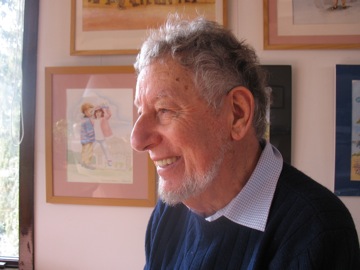 Ed Lessing, 2009Over the intervening years Eddie has often wondered what became of the men in the hut and especially his partner who rode off into the night on his mother’s bicycle. Fifty years later he was to learn that all the hut’s occupants, including two downed Royal Air Force airmen, had escaped. One of the airmen, Fred Sutherland, a full Cree Indian, was a crew member of the famous RAF Squadron 617 bomber group known as the “Dam Busters.” And, contrary to Eddie’s long-standing memory of the partner being a certain resistance fighter who was later killed by the Nazis, the actual partner was in fact alive and serving as a Catholic Bishop in New Guinea! Ed was reunited with Bishop Herman Munninghoff in Holland in 1992 where the Bishop recounted the exact same version of the terrifying night of the raid on the little hut in the woods, his own dangerous escape on Lien’s bicycle and his later calling to the priesthood … all thanks to Eddie’s mom.
Ed Lessing, 2009Over the intervening years Eddie has often wondered what became of the men in the hut and especially his partner who rode off into the night on his mother’s bicycle. Fifty years later he was to learn that all the hut’s occupants, including two downed Royal Air Force airmen, had escaped. One of the airmen, Fred Sutherland, a full Cree Indian, was a crew member of the famous RAF Squadron 617 bomber group known as the “Dam Busters.” And, contrary to Eddie’s long-standing memory of the partner being a certain resistance fighter who was later killed by the Nazis, the actual partner was in fact alive and serving as a Catholic Bishop in New Guinea! Ed was reunited with Bishop Herman Munninghoff in Holland in 1992 where the Bishop recounted the exact same version of the terrifying night of the raid on the little hut in the woods, his own dangerous escape on Lien’s bicycle and his later calling to the priesthood … all thanks to Eddie’s mom.
The Lessing’s dramatic stories of evading the Nazis and surviving the Holocaust as children, hiding alone or with host families in occupied Holland, are told in the book “The Hidden Children – The Secret Survivors of the Holocaust” by Jane Marks.
Ed and Carla live in Hastings on Hudson, New York. They have two children; Noa, born in Israel and Dan born in the United States and four grandchildren.
Epilogue 257 Lamartine, 2009While many of us were collecting paper and scrap metal, and buying war bonds and stamps to win the war, a nimble-minded Dutch mom was outwitting her Nazi captors and surviving one of the most notorious concentration camps to become an exchanged prisoner and thus live to see her family reunited after the horror called the Holocaust.
257 Lamartine, 2009While many of us were collecting paper and scrap metal, and buying war bonds and stamps to win the war, a nimble-minded Dutch mom was outwitting her Nazi captors and surviving one of the most notorious concentration camps to become an exchanged prisoner and thus live to see her family reunited after the horror called the Holocaust.
And, had a kind-hearted attempt to find music work for her husband (who never served as a Merchant Mariner except as a cruise ship musician) by Jacobus “Jaap” Langendoen succeeded back in 1930, 257 Lamartine Street might only be remembered today as just another Jamaica Plain two-decker instead of an important landmark in the world of a courageous Dutch family.
Sources and References:
Sheldon Rotenberg, retired Boston Symphony Orchestra violinist, Brookline MA
Heidi Langendoen, Jacobus Langendoen’s granddaughter,Wakefield MA
Bridget Carr, Boston Symphony Orchestra Archivist
Books:
“The Boston Symphony Orchestra, 1881-1931” by Mark Anthony DeWolfe Howe, Boston: Houghton Mifflin, 1931
“Gentlemen, More Dolce Please” by Harry Ellis Dickson, Boston: Beacon Press, 1969
“I had put all that behind me years ago” copyright monograph by Edward Lessing, 1994
“The Hidden Children – The Secret Survivors of the Holocaust” by Jane Marks, New York: Ballantine Books, 1993
Agassiz School Notes - 1922 to 1929
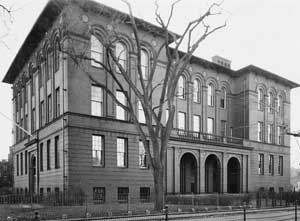 The idea of recording these memories came in a discussion with Agassiz teacher, Marilyn Walsh. She said that there seemed to be no history of the Agassiz Schools as they were before they moved from Burroughs Street down to Carolina Avenue. I decided that if I did not write these thoughts down nobody would. Actually, I took one or two copies of the School Magazine called The Agassiz Boy to the Headmaster there sometime three or four decades ago. As I recall it, it was when the School was still on Burroughs Street. I also think I gave them the third grade pictures. Perhaps they are in the library on Holbrook Street.
The idea of recording these memories came in a discussion with Agassiz teacher, Marilyn Walsh. She said that there seemed to be no history of the Agassiz Schools as they were before they moved from Burroughs Street down to Carolina Avenue. I decided that if I did not write these thoughts down nobody would. Actually, I took one or two copies of the School Magazine called The Agassiz Boy to the Headmaster there sometime three or four decades ago. As I recall it, it was when the School was still on Burroughs Street. I also think I gave them the third grade pictures. Perhaps they are in the library on Holbrook Street.
Kindergarten
On a bright day in early September, 1922, Mother took me by the hand from 6 Newsome Park, down Eliot Street to Brewer, down Brewer to Burroughs and up the granite steps into the smaller of the two brick Agassiz School buildings. She took me to put me into the kindergarten, which was in the room on the first floor on the right, as you went through the door on the Burroughs Street side of the school. I was a somewhat protected child, they having waited 5-1/2 years for me after my brother was born, and I did not like the idea of staying there all day, but there was not anything I could do about it. The ice was broken for everybody when poor little Calliope Jairis vomited. She was the daughter of the able fruit storeowner across from the bank and two or three stores from Seaverns Avenue on Centre Street. She obviously was more upset than I. Everything settled down when very large, round white haired custodian Kelley came in with a bucket of sawdust and cleaned the whole thing up.
I do not remember very much about kindergarten except that our teacher was Miss Earnshaw. If I have it correct, the Earnshaws owned and operated an old “coaching inn” on Center Street, West Roxbury, just beyond the current Unitarian Church. The inn was razed three or four decades ago to build a Stop & Shop or one of those markets. I believe it was still functioning as a tearoom during those years.
My father, having been on a championship club baseball team in the 1890’s in Boston was terribly pleased that I had Miss Earnshaw, for, if I remember correctly, her brother pitched either for the New York Yankees or New York Giants.
I do remember that we sat in a circle in that room. The circle was painted red on a maple floor. I suppose we sang all the songs and did all the things that kindergarteners do.
The Buildings
Actually there were three buildings. The use of the plural in the title was done on purpose. The Primary School contained the first three grades. It was a red brick Victorian building with a double-pitched roof, slate, as I recall it. It was very high studded. The basement had windows above the ground. In the basement were the latrines. The boy’s room had a slate barrier and trough with water running down the slate. Some small boys tried to shoot over the barrier and did occasionally, until a supervising teacher interfered. I never saw the girl’s bathroom.
The larger of the two buildings was built probably around 1880 or 1885, some twenty years later than the Primary School. There were several buildings like the Primary School around, such as the Hillside School on Elm Street on the corner of Everett Street at the end of Seaverns Avenue. It was razed for a parking lot across from the Congregational Church. I believe these schools were built shortly after the annexation of Roxbury by Boston in the1860’s.
This larger of the two schools was truly Victorian. It had a large overhang. Its main grand entrance was on Brewer Street. The Headmaster’s office was over the grand entrance looking out on Brewer Street toward Jamaica Pond. There was a protrusion on the primary school side which contained the fourth grade which I attended. I believe the architectural reason for the protrusion was to allow the hall on the third floor to take all the pupils.
Despite the fact that the main entrance was on Brewer Street, we entered and excited through the Burroughs Street side. Directly across the street from the entrance was a wonderful penny-candy store where one could buy “tootsie rolls” or other luscious items. It was in the workshop of the local house painter, Mr. Heap.
There was a third building in the back of the brick courtyard sort of between the two brick buildings, but way back toward Thomas Street. This was a gray prefabricated school building. Several prefabricated buildings were added during that period as the number of pupils increased. It was probably either a Hodgson Houses or a Brooks Skinner prefabricated school, one floor, and I believe heated by a stove.
First Grade
The first grade was on the second floor on the back side toward Thomas Street. The teacher, whom I had, was Miss Cleveland. She was a graying rather large woman who wore glasses. I have a couple of recollections of that class. That is where we started cursive writing the Palmer Method, “push and pull,” but with pencil. I think we did not get ink until the second grade, or even the third grade.
We learned to spell with a box of little green letters out of which we would pick the right letter. Once I saw the exact letter that I wanted on the desk of a fellow pupil across the aisle. As I reached over to get it, Miss Cleveland just had to say loudly “David.” She was a nice person, and all went smoothly.
I believe it was that year that we became very conscious of Miss Anna Von Groll, who was the Assistant Principal of the Primary School. One day my mother came to pick me up early for a doctor’s appointment and Mother never got over the fact Miss Van Groll pinned her up against the wall of the stair hall and scolded her, asking her what she thought she was doing breaking up the continuity of the School by picking me up for a doctor’s appointment at quarter of twelve when school did not close until twelve. Much more on this Miss Van Groll later.
Second Grade
For the second grade we went up to the top floor on the back toward Thomas Street. The class was broken in two and someone else had the room on the Burroughs Street side. My teacher was Miss Bertsch. She happened to be the sister of the stenographer in my father’s office in Roxbury. I do not know whether that helped or hurt. She was very tall, probably 5’11”. Had a somewhat large nose, was graying by this time. As I remember it, second grade was a serene year except for the fire escape.
Naturally, we had to have fire drills. These came unannounced. We would go out a door directly from the room onto the grill of the fire escape. Unfortunately, instead of looking down at the step, one looked right through to the brick courtyard below.
Perhaps it is well that we had practiced, because one morning about eleven o’clock the fire alarm went off and we all thought it was a false alarm. When we got down to the ground and out the gate on the other side, there was Engine 28 and the other pumpers. We were told by all the authorities to get out of there and go home.
My father was something of a “spark” having witnessed the Roxbury fire as a little boy in the 1880’s, which burned down the old Walpole Street American League baseball grounds on the site of where Northeastern exists today. He also witnessed the Chelsea fire a few years later. When he heard that the School was on fire, when I got home, as he happened to be there, he got into the car and took us to see what was happening. It actually was a fire and the firemen were on the roof taking the slates off and chopping through the roof. I believe we went back to school the next day.
Third Grade
Third grade under Miss Van Groll was really something. She probably stood all of 4’10” or 11”. She was a little round. She had brown hair and wore pince-nez glasses, as I recall. She was a little autocrat, as is indicated in the episode with Mother and the doctor’s appointment.
When she would sit at her upright piano and play back to the class, she would announce that she could see everything that was going on in the polished mahogany of the piano, so we must behave.
One of her finest moments was probably in 1926, the day after Malcolm Nichols was elected as the Mayor of the City of Boston. His son, Clark Nichols, was in my grade. The new Mayor came and visited us the day after he was elected. I can still see him now in a black Chesterfield, a gray suit, black shoes and a derby. Miss Von Groll was thrilled that he had come to her class.
The Nichols’ lived on Centre Street on the corner of Hathaway Street. There was a younger brother and sister. Mayor Nichols was a widower at the time, I believe.
I do not remember the names of too many people of that grade, but I can say that Dorothy Neale was very bright and may have been the brightest in the class. Another very bright boy was Hugh Gray. I remember also Pricilla Picket, who was the daughter of the eminent carpenter in Jamaica Plain, who lived off Centre Street near Dunster Road. Jane Ohler lived on Orchard Street and we often walked to school together and became good friends as grownups. One of the Bowditches, I think Hoel, came down from their place on top of Moss Hill. Philip Rasmussen, later a Navel Flier hero, lived as far away as Winchester Road. The school at the end of Louder’s Lane had not been built yet. Henry Schmidt lived right at the entrance of Louder’s Lane. Those were the people I saw because of growing up on Prince Street walking to school.
However, most of the children came from the other side of Centre Street from Lamartine Street and Chestnut Avenue and down Centre Street toward St. Thomas Aquinas and Carolina Avenue, Custer Street and so forth.
I think the second section of the third grade was in the portable building. I do not know how they divided us, whether it was by grades or just arbitrarily. I believe the other second grade teacher was a Miss McReady.
Then in the fall of 1926 we split. The girls went to the Bowditch School and the boys went next door to the larger Agassiz School building.
Fourth Grade
My fourth grade teacher was Mrs. Holland. She was a lovely lady with white hair. She was kind and soft spoken and everybody took to her. My friend Nathaniel J. Young, who still lives on Pond Street, Jamaica Plain, tells me that at that time a married person could not be a teacher. His mother had been a teacher in the Boston School system until she married Mr. Young. I believe Mrs. Holland was a widow and lived on Willow Street, West Roxbury. She was a nice enough so that my parents sought her out one afternoon and that is why I have the Willow Street recollections.
Later, according to Joan Scolponeti whose father was Corporate Council at City Hall and who grew up on May Street, Jamaica Plain across the street from the Gargans, with whom she played, told me that she also had Mrs. Holland. So sometime in the years after I left, the fourth through eighth grade building apparently started to accommodate girls as well as boys.
The Ruling Hierarchy
We have already noted that Miss Anna Von Groll, who proudly lived at the Fritz Carlton Hotel on Boylston Street near Fire Department Headquarters, was the Assistant Principal of the Primary School.
The Headmaster of the whole Agassiz School system was Joshua Q. Litchfield. “Q.” stood for “Quincy.” Mr. Litchfield was extremely proud of his Yankee ancestry and of that Quincy name which, after all, was related to the famous Adams family in Quincy. He looked like a typical Yankee, bald, with a large nose. He seemed completely competent to handle the job.
Under him the Assistant Headmaster, who was a receding-chin gentleman by the name of James Nolan. Everybody thought “Jimmy” Nolan as tough. It was he who gave the rattan to the worst offenders (more on this later). In case Mr. Nolan was out, Miss West, who was also somewhat chinless, had the authority. She was an eighth grade teacher.
Fifth Grade
My fifth grade teacher was a round somewhat red faced, brown haired 35-year-old called Miss McGowan. She was a very good teacher. She was a very good disciplinarian. It was there that the rattan first appeared. Luckily I escaped it. It was fearsome to see these tough little boys asked to go into the coat room to get their hands whacked with a rattan and come back with tears running down their faces and all defiance gone.
For a short time that year Miss McGowan was sick. She was replaced by a younger woman by the name of Miss Butler. She must have had a boy friend at Boston College, because all she could talk about was the Philomatheia Club. I looked in the Newton phone book but the Philomatheia does not show. I have seen it in a Swiss Chalet style building over there. I suspect that Miss Butler attended dances or parties at the club there in the 1920’s.
It was in the fifth grade that we started woodworking. I got good grades at Agassiz, all “1”s in everything except woodworking. The more dexterous boys were sent down to Eliot School on Eliot Street, which had been taken over by the Public School System sometime in the 19th century. There they really got good woodworking training. I think our woodworking teacher’s name was Mr. Maguire. He was very patient with clumsy people like me, and in spite of not getting a good mark, I enjoyed it and still tinker with things.
Sixth Grade
For sixth grade we went upstairs to the second floor of the big building. The teacher was Miss Childs. The other sixth grade teacher I do not remember. The School did go on through the eighth grade at that time. After age 11 I had more confidence. I would stay after school and play with John Malone, who lived on Brewer Street, in the schoolyard until thrown out. Malone’s father had the Arborway garage on Centre Street near Forest Hills. Originally before automobiles, it was Malone & Keene with horses and buggies. Or I even went down to the Carolina playground and tried playing baseball, but I was not any good, so gave it up.
The next year I went off to Roxbury Latin.
Movies
Once a month or so we would go upstairs to the third floor where Mr. Litchfield would give us a treat of movies. Of course, these were silent movies and captioned. This was supposed to be a treat, however, getting two or three hundred little unclean boys in a hot hall is not the pleasantest for the olfactory senses.
The Children’s Museum
At that time the Children’s Museum was located on the Pine Bank of Jamaica Pond in the Victorian mansion of Thomas Handasyd Perkins, which is still there, although it is falling apart. We would walk from the school down approximately to Mayor Curley’s mansion and there would be a policeman there who would get us across the traffic. These visits went completely over my head, but I guess some of the children got something out of it. The Children’s Museum moved to the old Mitton Mansion on the corner of Burroughs Street and the Jamaica Way before it moved downtown a few years ago.
The Pet Show
In the spring of my sixth grade year, it was announced that there would be a pet show on the lawn across the street from Mayor Curley’s house on a given Saturday. Our family had a thoroughbred wire-haired fox terrier. I bathed her, and primped her, and brushed her, and put a ribbon on her and walked down there to the site of the show. I looked around and it did not look to me as though I had much competition. There were two or three cats, a couple of not very beautiful dogs. Perhaps there was a canary, a parrot.
Just when the teacher said, “We will now have the judging,” the door of Mayor Curley’s Mansion opened and young Francis came out. The policeman stopped the traffic, led him across the street and with his not-very-well-groomed mongrel dog. This was just in time for the judging.
The teacher called him by name and told him to come and we could now have the judging.
My recollection is that I did get the Blue Ribbon, and Francis Curley got second prize, a Red Ribbon.
Summation
This was a very good school, the Agassiz School. These teachers were good. They devoted their lives to teaching small children. All of them were unmarried except Mrs. Holland, who was a widow, as I said. Most of them had been trained at Boston Normal School on Huntington Avenue. Discipline was strong.
There was a great mixture of people in the Agassiz School. As I described before, most of the pupils came from the south side of Centre Street. This was not an affluent area. One little boy needed a bath so badly that one of the teachers sat him in the back of the room so that the odor would not bother the other children (or the teacher).
Joe Graham was a genial, smiling, blonde policeman, who got those two to three hundred children across Centre Street safely every day. He was a character. He was there long after I left school.
On a balance, it was a good and fulfilling experience.
Written by David A. Mittell.
David A. Mittell grew up on Prince Street in Jamaica Plain. He attended the Agassiz School and Roxbury Latin. He is a 1939 graduate of Harvard University. Mr. Mittell is a retired executive of Davenport Peters, the oldest American continually operating lumber wholesaler. He is a member of the board of trustees of the Plimoth Plantation and Roxbury Latin High School.
—
Comment by George B. Stebbins, Jr. (geosteb at juno.com):
A friendly amendment: I believe the policeman who covered Centre Street was Joe Graham, not Jimmy. Jim Graham, who lived in the castle on the Arborway, was president of the Forest Hills Cooperative Bank. I also attended the Seeger School where the Mittell and Salisbury names were important; I spent four years at Agassiz, two at J. P. Manning, and then went to Roxbury Latin School.
Copyright © Jamaica Plain Historical Society.
Alleged Wagon Thieves Arrested
Find Booty at Jamaica Plain.
Shoemaker is Charged with Receiving Stolen Goods.
Driver Escapes from 11 Headquarters Men.
A revolver shot, fired in the air by Inspector Lynch in front of 3110 Washington St., Jamaica Plain, yesterday afternoon, drew ten other inspectors of Police Headquarters from hiding places and gave the signal for the arrest of three men.
The men arrested are charged by the police with being responsible for the disappearance of two wagons filled with leather, satin and shoes. The moveable part of the alleged booty was brought to Police Headquarters last evening where it now occupies the entire floor space of a good-sized room.
Patrick J. Culhane, aged 22, no home, who was released from State Prison only a few months ago, after serving a sentence for larceny of a similar nature, was one of the men. He and Charles Sidney are charged by the police with larceny. Sidney is 20 years old. He also disclaims a place of resi-dence.
Samuel Stone, aged 41, a Jamaica Plain shoemaker, who lives at 8 School St. and has a place of business at 3140 Washington St., Jamaica Plain, was the third man arrested. He is charged with receiving stolen goods.
In the mix up attendant upon the rush of the arresting officers following the revolver signal, a fourth man, driver of a wagon upon which the two alleged thieves rode to the scene of their cap-ture, escaped.
According to the police, Culhane and Sidney would stroll along the streets until they came across a well-laden wagon, the driver of which was not nearby. They would jump upon the wagon and drive off. The police charge that Stone, the shoemaker, received the goods thus stolen.
For several days and nights a headquarters inspector has been in hiding near the shoemaker’s shop, watching and listening. Yesterday morning a tip reached Police Headquarters, and the eleven in-spectors were sent out to Jamaica Plain.
It was arranged that Inspector Lynch should remain on the street and fire the revolver as a signal, while the other offices, to avoid suspicion, should hide themselves nearby. Inspectors Smith, Sheehan, Laughlan, Dennissey, Burke, Morrissey, Egan, Dorsey, Concannon and Kilday, whom Chief Inspector McGarr had assigned to the case, accordingly got out of sight.
Very soon a wagon drove down Washington St. and stopped before 3140. Culhane and Sidney, according to the police, were on the wagon. As the wagon came to a stop they were having a bit of horse play between themselves. Incidentally the police say they changed caps.
It is said that when the wagon stopped, Stone came from his shop and placed a bundle of leather on the wagon. Then Inspector Lynch fired his revolver and the ten inspectors appeared.
Inspectors Sheehan and Dorsey grabbed Stone before he could move. Culhane and Sidney started to run away, but Inspectors Smith and Morrisey gave chase. Inspector Smith caught Sidney and Inspector Morrisey got Culhane.
They were brought to Headquarters, when it is said Culhane was identified by Inspector Michael H. Cronin as the man he arrested about six years ago by overturning the wagon upon which he and another man was riding. At that time it was alleged that Culhane attempted to kill Inspector Cronin by firing a revolver at him. Culhane was tried for this. He was sent to state prison.
The inspectors also brought to Headquarters a couple of wagon loads of stuff said to have been stolen by Culhane and Sidney. Great cases of shoes formed the best part of the alleged loot, but there were numerous other things as well, including mops, paper and satin.
Culhane and Sidney are officially charged by the police with the larceny on September 9, from Whipple & Co., of 311 South St., of a horse and wagon, six bundles of leather, 1 bundle of satin, 314 pairs of shoes, five gross of shoe laces and one roll of paper, all valued at $1700. They are al-so charged with the larceny from A. Towle and Co. of 41 Matthews St., of a horse and wagon and seven bundles of leather valued at $1000.
Awakened by the Joyous Sound of Bells
 The coal was in the cellar, a barrel of flour in the pantry, preserves and piccalilli stored away, plenty of beans for baking, a good supply of winter vegetables and you were all set for the winter.
The coal was in the cellar, a barrel of flour in the pantry, preserves and piccalilli stored away, plenty of beans for baking, a good supply of winter vegetables and you were all set for the winter.
Then one morning you would be awakened by the joyous sound of bells. To children this meant one thing - IT SNOWED! The pungs were out! (a pung is a low one-horse sleigh) First to announce the good news were the milkmen who started their deliveries before five o’clock in the morning. The horses had special shoes for the winter, which had, caulks driven into them - sharp pieces of steel which would give a gripping power in the snow and ice. Each night after the days work the horses hooves were checked to see if the caulks had become dull. If so, they had to be replaced.
At the first storm of the year, if it were accompanied by severe cold or wind, the horse would be sporting his winter shoes, a warm woolen blanket and the bells, which would announce his coming. He was “rarin’ to go” with half the schoolchildren of the neighborhood running alongside him. Hopping the pungs on the way to school was a way of life for children in Jamaica Plain, It annoyed some of the drivers but most of them, remembering their own childhood, either closed their eyes or just made sure you were on safely. It was great fun!
All was great for the horses as long as they were on level ground, but there were hills, which were difficult to go up, and, when they were iced, were more difficult to come down. Vividly I remember an icy day when a horse fell on Newbern Street, broke his leg and had to be shot. Also, if there was a thaw the main streets would become bare in spots and it would be a very difficult drag for the horses. However, the milkmen know the angles and would use the side streets as much as possible. The Public Works Department in Jamaica Plain was located on Child and South Streets where the Farnsworth House and equipment needed to carry on public works. Snow removal, as we know it today was not a problem. Mother Nature would take care of it in time. Huge weighted drums six feet in diameter and eight to ten feet in width were drawn by teams of horses through the streets after a storm. The roller left the street hard packed with snow over which teams of horses pulled pungs on snow runners.
A horse and small V plough with a driver took care of the sidewalks and made them passable for pedestrians. Children who had no fear of horses whatsoever found them a formidable sight when they invaded the sidewalk. They were given the right of way as the children watched from the safety of their yards.
After the First World War, the automobile and the truck came into their own, and the days of the horse, wagon and sleigh were almost gone. Snow removal then became a problem and the people were required by law to shovel the snow from their sidewalks. This applied to both property owners and tenants as well. If there was a delay in clearing your sidewalk the police would be at your door to read the law to you. As a general rule those who were fortunate enough to have a car would put it into the barn or garage for the months of January, February and March until the roads were usable for tires again. This continued until the 1940’s when a car became a must for the year round.
For children there was much to do in the winter. There were great hills that were safe for coasting; skating on Jamaica Pond, and the playground at Child and Carolina Avenue was flooded for skating as well. The girls built snowmen and women and dressed them up in whatever they could come up with. The boys built snow forts and piled up a heap of snowballs, and from the safety of the fort went to war with their adversary. There was, indeed, great fun in the simple things of life in those days!
Sources: Gerry McCarthy, McCarthy Brothers Milk Company; B. Tafty, 1001 Questions Answered About Storms.
Written By Mary Glynn. Reprinted from From the Archives, Winter 1989, a newsletter once published by the Archive Committee of the Jamaica Plain Historical Society. Copyright © 1989-2003 Jamaica Plain Historical Society. Photograph courtesy of Chicago Historical Society, Chicago Daily News negatives collection, DN-0090242.
Blessed Sacrament Corner Stone Laid
This article originally appeared in the September 29, 1913 edition of the Boston Daily Globe. Production assistance provided by Kate Markopoulos.
Cardinal O’Connell at noon yesterday laid the cornerstone of the new Church of the Blessed Sacrament in process of construction on Center near Creighton St., Jamaica Plain. Nearly 5000 present and past parishioners, many of whom had assembled early in the forenoon, attended the interesting ceremony which followed the last mass of the day in the present church.
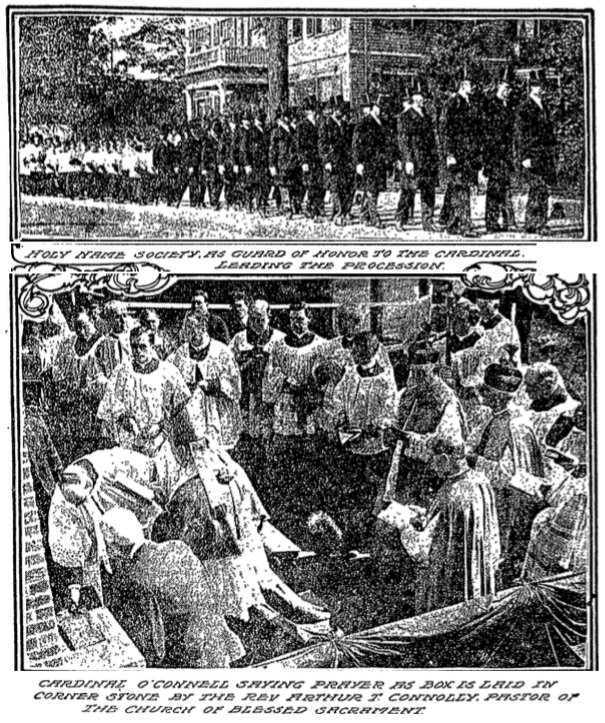
His Eminence brought up the rear of an impressive procession of monsignori, clergy, and laymen from the rectory to the church, including about 500 of the parish Holy Name Society, Captain Joseph Dugan, and about 300 of the Knights of the Blessed Sacrament. They were followed by Rev. Frederick J. Allchin of St Paul’s Church, Dorchester, as crossbearer, leading the following monsignori and parish priests: Mgr. M. J. Splaine of the Cathedral, Mgr. Edward J. Moriarty, PR, of St Thomas’ Church, Jamaica Plain; Mgr. P. J. Supple of St John’s Church, Roxbury; Rt. Rev. Denis J. O’Farrell of St. Francis de Sales’ Church, Roxbury; President Thomas I. Gasson, SJ, of Boston College; Rev. Dr. Edmund T. Shanahan of the Catholic University, Washington; Rev. M. T. McManus of Brookline, Rev. James B. Troy of St Vincent’s Church, South Boston; Rev. James J. O’Brien of Somerville, Rev. James Lee of Revere, Rev. D.J. Wholey of St. Joseph’s Church, Roxbury; Rev. Charles Regan of All Saints’ Church, Roxbury; Rev. James J. Hayes, CSSR, of the Mission Church; Rev. George Lyons of the Church of Our Lady of Lourdes, Jamaica Plain; Rev. Fabian O’Connell of East Boston, Rev. Frederick J. Allchin of St. Paul’s, Rev. Joseph Brandley of Neponset, Rev. Irving Gifford of Cambridge, Rev. Arthur T. Connolly, Rev. Joseph P. Maher, Rev. Edmund Daly and Rev. John F. Madden, all of the Church of the Blessed Sacrament.
A large chorus of children sang, under direction of Fr. Daly, as the Cardinal was escorted to his throne, Mgrs. Moriarty and O’Farrell were chaplains to His Eminence. The sermon was preached by Rev. Dr Edmund T. Shanahan, a Jamaica Plain boy, now a professor of dogmatic theology at the Catholic University, Washington. Fr. Shanahan’s sermon was on the Christian doctrine of life in contrast to the economic theories of the day, which the speaker characterized as partial, one-sided and exclusive. “The Catholic doctrine of education, progress and life,” he said, “is that of total, complete self-development, mental, moral, physical, social and religious.
“In this magnificent sweep of view the Catholic doctrine of life is superior to all others, as the whole is to its parts. It includes all the good of modern movement for the physical betterment of man, resisting only the anti-Christian theories of life with which, unfortunately and unnecessarily, science and social work are too often associated nowadays. “Some single-barreled thinkers of the day have wrongly got it into their heads that the service of God is somehow opposed to the service of humanity. This is a gross misunderstanding of elementary Christian doctrine.
“The service of man is one of the appointed ways and means of serving God. The latter service includes the former, as a wheel within a wheel. It is not a question of two things, but one thing in two relations. The future Altruria of the Socialist, where others alone shall reap what we are now sowing, is not an ideal capable of setting the souls of men afire with the spark of self-sacrifice. Self-sacrifice is not an end in itself, but a means to an end, and modern social preachers have made a fatal blunder in asking men of flesh and blood, ambition and self-interest to sacrifice themselves for such impersonal abstractions as the race, the community, the greatest good of the greatest number.
“Man needs reality, the personal God of justice and mercy, to live for and to worship. No merely human gospel of neighborliness will ever prove our efficient substitute for the unmutilated gospel of Christ. A religion of humanity can never take the place of the religion of God.” During the sermon Dr. Shanahan paid a warm tribute to Fr Connolly, not only for the success of his work as administrator, but also for the exceptionally fine, practical, commercial education which he has provided for the children of the parish.
Cardinal O’Connell made a brief address, observing: “Surely Boston ought to be a city of peace and order. From every hill for miles around gleams the sacred sign of our redemption, the cross which teaches man that here there is no lasting happiness except the contentment of virtue and religion. May this new citadel be to the whole city, as well as to those who live in its shadow, a tower of holy strength and a pledge of God’s benediction upon this good and beautiful city.”
The procession marched to the corner stone, which was laid by His Eminence with a silver trowel which will be presented to the most liberal contributor to the new church. The Cardinal was assisted by many priests, prominent among whom was Rev. Arthur T. Connolly, the pastor, who placed within the stone a copper box with documents, newspapers, coins, photographs and a list of the contributors to the special corner stone collection a year ago.
Bob's Spa
Based on interviews with John and Anthony Ristuccia, second and third generation owners of Bob’s Spa, and William R. Fernandez, current owner of the store, in July 2009. Special thanks to John Lovett who suggested this article and participated in the interviews.
by Peter O’Brien, August, 2009
A Snapshot
Ask anyone growing up south of the Monument where they could find industrial sized bologna and cheese sandwiches on super-fresh bulkie rolls, the plumpest jelly donuts, the smoothest ice cream, the foamiest root beer floats, the coldest tall bottles of Royal Crown, Pepsi and Nehi Orange, an honor-system penny candy case and a kind and trusting proprietor who’d carry your family “on-the-cuff” when needed, and the answer can only be “Bob’s Spa” at 128 South Street.
Nearing its centennial, with 90 uninterrupted years under one family’s devoted management through two World Wars, Korea, Vietnam, Middle Eastern and other military excursions, rationing and shortages, the Great Depression, several recessions and three generations of family ownership, Bob’s Spa, from its humble beginnings in 1912 as a tiny fruit store, continues to serve the vibrant South Street neighborhood’s ever-changing needs under a new and equally dedicated family management.
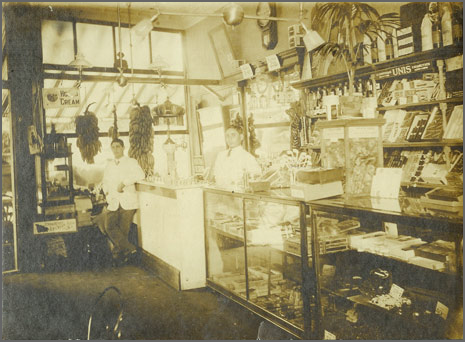 Interior view of Bob’s Spa, circa 1912.
Interior view of Bob’s Spa, circa 1912.
The Beginnings
A young man’s odyssey of 30,000 miles from the tiny seaside village of Malfa, on the island of Salina in the Aeolian Island group off the coast of Sicily, to founding a Jamaica Plain icon at 128 South Street reads like an Horatio Alger novel.
Bartholomew Ristuccia was born in Malfa in 1891. He left his hometown at age 17, with just a fourth grade education, to join a cousin in Sydney, Australia, who owned a fruit store there. Then as now, Australia was a favorite destination for émigrés from Malfa.
Bartholomew loved the fruit business and was determined to make a future for himself in that field. Learning all that he could from his cousin he left Sydney and arrived in Jamaica Plain in 1910, now a burgeoning fruit expert. He immediately went to work at Favaloro, Saltamacchia and Company’s fruit store at 343a Centre Street, near Blessed Sacrament church and Hyde Square. Favaloro, Saltamacchia and Company also operated a store at 74 Green Street. The principals, Joseph Favaloro and Giuseppe Saltamacchia, were Bartholomew’s cousins from Malfa.
With two years experience at Favaloro’s fruit store under his belt, in 1912, at the age of 21, Bartholomew joined Joseph Favaloro and Giuseppe Saltamacchia as partners in a new fruit store at 128 South Street. Soon, Bartholomew bought-out his cousins and renamed the store “Bob’s Spa.” (Bartholomew had taken the name Bob and was known that way for the rest of his life.)
Thus was launched a family owned and operated business thriving for 90 years under the continuous operation of the Ristuccia family until 2001 when it was sold to William R. Fernandez. As it nears its centennial, the store is now called Fernandez Spa and Liquors and it continues to thrive serving the diverse community flourishing in the neighborhood.
Bob’s Customers
From its modest start in 1912, focusing on fruit and fruit baskets, Bob’s Spa grew slowly, but steadily. One of its first customers, Annie Gavin of 15 Boynton Street, remained steadfast for the next 50 or so years, as did many others in the neighborhood.
Other long-time customers were James “Jimmy” Lovett and his son John. Jimmy owned and operated the last blacksmith shop in Jamaica Plain, located at 10 McBride Street, just around the corner from Bob’s Spa. Lovett’s shop had been operated previously by John “Jack” Mahoney and before him by Ignatius J. Craffey. Jimmy Lovett was born in 1905. He shoed the Boston and MDC Police horses, Hood Milk’s and the Larz Anderson estate horses until he was 84. Many an inverted horseshoe hanging in local homes and many a local game of horseshoes owed their origins to the Lovetts.
Jimmy Lovett would stop in at Bob’s after Sunday Mass at St.Thomas Aquinas Church and those visits made a lasting impression on his son, John. Jimmy taught his son the farrier’s (horseshoeing) trade and he worked at it for several years before landing a job at the Telephone Company. 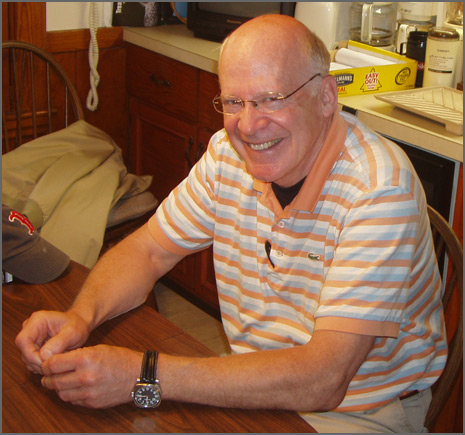 John Lovett, 2009
John Lovett, 2009
One of the major sources of Bob’s customer loyalty was the ability of nearly anyone known to Bob to buy “on-the-cuff”, i.e. on credit. The term originated in the early 1900’s when bartenders with starched cuffs would keep a tally of a customer’s drinks on the cuff. At Bob’s, there were no credit checks, no forms, no bills sent, just the faith that the customer would settle up, most, if not all, of his outstanding bill at the end of the month. Most did, but a few skipped and Bob took the hit, preferring, true to his benevolent nature, to think it was the hard times and not the customer’s intent to cheat him.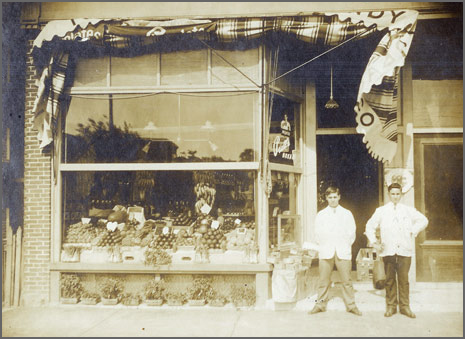 Exterior view of Bob’s Spa, circa 1912. Bob Ristuccia shown on the left.
Exterior view of Bob’s Spa, circa 1912. Bob Ristuccia shown on the left.
Bookkeeping for the credit customers consisted of small notebooks for each individual customer with hand-written entries for various purchases. The tally of a given purchase would be done in pencil on the outside of the brown paper bag holding the charged goods so the customer would have a record of the transaction. The total of the transaction would then be entered in the customer’s individual book.
And many a loyal customer was created by the fact that an 8 year old could be sent to Bob’s with a note for a pack of Pall Malls and it would be duly honored because the tobacco laws hadn’t kicked in yet.
Assuming 50 customers per 18-hour day for 90 years, there could have been over 1.6 million people entering Bob’s Spa. Even today, many of those former customers visit the store for the Sunday paper as they return to weekly services at St. Thomas. These nostalgia trips keep alive the memory of the Ristuccia family’s devotion to the store and their customers’ goodwill over many years during the good, and not-so-good times.
Bob’s Landlord
The original 1912 fruit store was just a rented corner of the block of stores between McBride and Boynton Streets owned by the John W. Patterson family. The Pattersons operated a liquor store and the Arborway Market for many years in the same block. Contrary to what most of his customers believed, Bob never owned the store that he and his family occupied for 90 years. They remained the tenants of the Patterson family and it’s successors until they sold the store in 2001.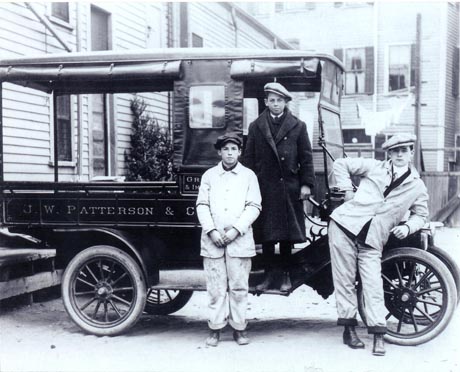 Joseph A. Patterson (middle) poses circa 1912 with two employees of Patterson’s Market in the rear of 128 South St. On the right is Edward Finnerty, who later became a Boston police officer. Photograph provided courtesy of John Patterson.
Joseph A. Patterson (middle) poses circa 1912 with two employees of Patterson’s Market in the rear of 128 South St. On the right is Edward Finnerty, who later became a Boston police officer. Photograph provided courtesy of John Patterson.
As a hedge against escalating rent, Bob bought the old Wilson’s Meat Market building on the north corner of McBride Street as a possible future store site. Mr. Wilson was something out of a Studs Terkel book with his standard butcher’s straw hat, blood-stained sleeve covers, band-aid wrapped fingers and an apron that very, very rarely saw the inside of a wash tub. It was alleged that he sold horsemeat as beef during the Big War. Nevertheless, he’d collect the ration stamps and tokens required for the meat purchase. Whatever it was, we ate it and we survived.
The large room above the market had been a pool parlor and men’s club, perhaps at an earlier time catering to the clientele of the nearby pre-prohibition Coffee Tree Inn at 16 McBride Street, which later was the site of the Washington Wet Wash laundry.
The Patterson’s also owned a small variety store at the corner of Woodman and Jamaica Streets. These Patterson business interests presented a bit of a challenge for Bob as he tried to grow his own store. For example, each time Bob wanted to add a line of food or merchandise, he needed to get Mr. Patterson’s approval, especially if the item being added was competing with the same being sold by Mr. Patterson. Eventually, Mr. Patterson would relent and Bob could keep up with his customers’ demands and remain competitive with his landlord and the many small variety stores and markets within walking distance.
The small competing stores along South Street included Dolan’s, Mary Kelly’s, Andy’s Spa, Mouradian’s Market, a one-man A&P store run by Arthur MacMillan of McBride Street next to Farrell’s Drugstore and Cavalier’s Variety further down South Street. Another one-man A&P store, Caraber’s Variety, Kelly’s Market and Campbell’s were located on Call Street. And Woody’s Variety, owned by Woodrow Barbour, was located on McBride Street.
Other short-lived small stores, with long forgotten names, dotted the area as others tried the “easy” life of running a small variety store.
Growing the Business
Weathering the impacts of wars and the related rationing and shortages, recessions, inflations, and The Great Depression, Bob’s Spa continued to grow, becoming known as a purveyor of fine, gift quality, fruit baskets. It was commonly known among the poor in those days that a family didn’t have fruit in the house unless someone was really sick, so the sight of Bob’s beautiful fruit baskets was something for most of us to crave.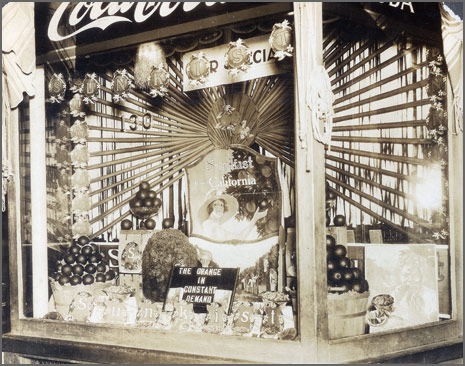 Bob’s Spa, date unknown
Bob’s Spa, date unknown
The neighborhood was growing too. A substantial streetcar maintenance facility located across South Street, known locally as the “car-barns,” which, along with expansion of the public transit systems at the Arborway and Forest Hills terminals brought streetcar, and later, bus riders up and down South Street. Fortuitously, a streetcar stop was located right at Bob’s door and later; the former car-barn site became the turnaround for the Dudley streetcar. And, as the automobile became available to working people, the public was transiting through the southern end of Jamaica Plain to access and enjoy the Arnold Arboretum, Forest Hills Cemetery and Franklin Park.
Nearby, at Child Street, the City’s DPW yard, the Boston Consolidated Gas Company maintenance facility and Kinney Pump Company on lower McBride Street and the Barbara Lee Chocolate factory on Call Street, attracted workers who found Bob’s Spa.
Expansion of St. Thomas’ elementary and high schools, many small retail and service businesses sprouting up along South Street and development of housing on Carolina Ave, South, Child, McBride, Boynton, Hall and Rosemary Streets were contributing to Bob’s Spa’s growing presence in the neighborhood.
Other revenue generators were the “Smokers,” an evening of newsreels and sports films barely visible through a dense blue cloud of cigar and cigarette smoke, at the American Legion Post No. 76, then located across South Street, and the annual carnivals at the vacant former car-barns site.
Another major boost to the business came with the construction of the Housing Project on the former car-barn site in the early 50’s. The store continues to serve the many families located there.
Nearly the End
Among the many bumps along the way, perhaps the most significant was the fire on December 24, 1927, that nearly wiped Bob out. With the same perseverance that sustained him in the early days, and the help of friendly merchants and suppliers, Bob immediately reopened in the vacant store next door until his fire-damaged store could be repaired and reopened.
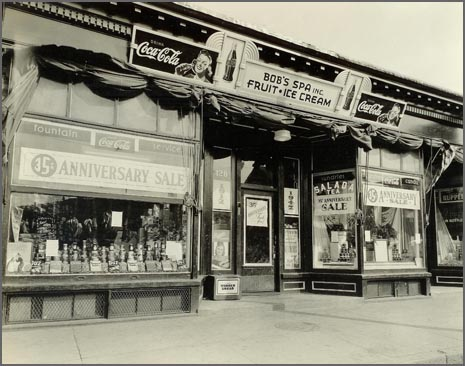 Exterior of Bob’s Spa, 1947
Exterior of Bob’s Spa, 1947
Life in America
Bob’s personal life over the span of his 65 years in America was marked by his strong spiritual beliefs, his devotion to family and honesty and integrity in all his business dealings. He was a lifelong member of the St. Thomas Knights of Columbus Council No. 120, achieving the Fourth Degree, and, because of his obvious devotion to his new country, he was made an honorary member of the American Legion Post No.76, directly across the street from his store. He was also a lifetime member in the Massachusetts Retail Grocer’s Association and the Boston Retail Grocer’s Association. The only thing Bob feared in America was driving, and after one serious close call he never drove again.
His marriage to Rosalina Caravalio from East Milton produced four children, John, Robert, Rose and Mary, all of whom, along with their spouses, at one time or another worked in the store. In the early days of their marriage Bob and Rosalina lived at Hyde Square, then South and Rosemary Streets. They finally settled in their own home at 16 John A. Andrew Street. Married for over 50 years, the Ristuccia’s experienced the same economic ups and downs as their customers. In fact, during the Depression, Bob and his wife lost their house at 16 John A. Andrew Street, but later were able to buy it back for less than its original price. This was serendipity of the sweetest kind because the foreclosing bank had callously dismissed Bob’s plea for time.
When World War II came, three of Bob’s children, John, Robert and Mary went off to serve. The growing business was open from 6 am to 12 midnight for many years in order to survive in the retail store environment. The burden of those long days, wartime rationing and shortages, and the uncertain post-war economic conditions had to be borne by Bob and his wife. After the war, the returning Ristuccia children were drafted to duty in the store, thus relieving Bob and his wife for a long overdue vacation.
The store was the family’s life and the long workdays were standard fare for the many family members who worked there over the years.
The Second Generation
On March 4, 1927, Bob’s youngest son, John, was delivered by Dr. Frederick W. Beering Jr., of 61 South Street, (known as the Flying Dutchman in his Harvard football days,) at the Ristuccia family home at 16 John A. Andrew Street.
Dr. Beering was probably the most widely known and visited doctor in that part of Jamaica Plain because he usually neglected to collect payment for an office visit, and when he did, he’d often give it back to one of the children he just examined or contribute it toward the cost of the prescription he’d just written. The good doctor claimed, without a hint of bitterness, that he was owed many thousands for unpaid services and medicines he himself paid for. His prescriptions often came into C.B. Rogers Drugstore with a note that it be charged to his account.
Johnny Ristuccia went to the Agassiz, Bowditch and Curley Schools followed by Boston Trade School to learn the “tin-knocker” (sheet metal) trade he loved. In his shop days at Trade School, Johnny made radiator covers for the State House and fuel tanks for the Boston Fire Department’s fireboat.
Johnny remembers earning money selling newspapers, especially the Boston Daily Record’s Payoff edition, which carried the daily “number.” This was the number bet with the local bookies - not the electronic State operated Lottery system existing today. The daily number was the last three digits to the left of the decimal points as shown in the daily pari-mutuel handle, or amount bet, (win, place and show) at a designated horseracing track. The fourth number was the first digit to the right of the decimal point in the “show” row.
A favorite number, quickly scribbled by the local bookie on a slip of paper, had a promised payoff of 600 to one, or $60 for a ten-cent bet. After the bet was placed, the bettor needed to check his luck in the “Payoff” (late) edition of the Boston Daily Record that evening. The Record was the closest thing to the tabloid ‘Enquirer’ of its time and it published the pari-mutuel betting numbers that in turn formed the daily number. The earlier, or “Home” editions of the Record did not carry this vital piece of information.
Johnny peddled the papers in various taverns, including Doyle’s on Washington Street. “The Chapel” on McBride Street and several other local pubs as well as more distant watering holes in downtown Boston. All paperboys were given a Newsboy’s Transit Pass to ride the elevated trains and streetcars free, to sell papers to the riders.
Johnny earned seven tenths of a cent per copy sold, (70 cents/100 copies) plus an occasional tip. Notwithstanding the meager commission structure, he was able to buy himself a wonderful new Western Auto, balloon tire, single speed bike with chain guard, kickstand, and a thumb-operated bell he had spotted in the window at Western Auto near Fenway Park. Johnny was riding high.
Seeking better pay, Johnny became a pinboy at the Arborway Bowlaway, downstairs at the corner of Boynton and South Streets, earning the respectable sum of five-cents per string while ducking flying pins and balls in the dark caverns at the end of the well-worn alleys. Occasionally a tip would come sliding down the alley after an evening of accurately spotting the candlepins for several strings bowled by the bowling leagues using the alleys. An evening’s pay of $1.50 to $2 was possible, and that was a significant night’s pay.
After high school, Johnny became an electrician’s helper at the Boston Navy yard pulling cable on ships being overhauled there. In 1944, at 18, he entered the Army and served aboard an Army tugboat in Seattle, Washington. After his discharge in 1945 he felt the not-too-subtle pressure to come to work in the family’s store. So he came aboard and stayed there for his next 47 working years.
In 1949 Johnny married one of his customers who had walked in one day and sent sparks flying about his head! Jane McCallam, from Hall Street, was a 1946 graduate of St. Thomas High School (for girls only back then.) Johnny was smitten and stayed smitten for 54 years. They were married at St. Thomas church and lived initially on Rosemary Street and then in the Project across the street from the store. They moved to Child Street and finally to 126 Montclair Avenue, West Roxbury, for the past 40 years. They enjoyed a wonderful marriage, raising four children, Anthony, John, Paul and Jean, all imbued with the Ristuccia family’s tradition of retail grocery store management. Johnny lost his soul mate when Jean passed away in 2004.
Johnny, now well into his retirement, maintains his ties to the store in several ways including as longtime proud owner of Mass license plate “Bob’s.”
Ownership Expands
After World War II, Bob’s daughter Rose married Mike Caliri. Soon, Mike became a partner in the Spa, and he and Rose were able to move to a fine house on May Street. They lived there until the late 1960s when Mike left Bob’s Spa and the Caliris moved to Chatham, Mass. to open a small store of their own. They remained there for the rest of their lives, raising their nine children in Chatham.
Shortly after the partnership was formed with Mike Caliri, Bob began to cut back on his involvement with the store and around 1950 turned his interest over to Johnny. Bob retired, more or less, in the early 50’s but of course he could not stop coming in to see how things were going.
The new management under Johnny and Mike lasted until Mike’s move to Chatham in about 1969. When Mike left, Bill White became a partner and under Johnny and Bill’s management the store was remodeled in 1970. Bill White stayed about 10 years.
Other employees over the years were Bob Micelli, Buddy Gillis and nearly all the Ristuccia family members.
Bob continued his semi-retirement until his death on November 15, 1975 at the age of 84, far away from his small hometown of Malfa, Messina Province, Sicily.
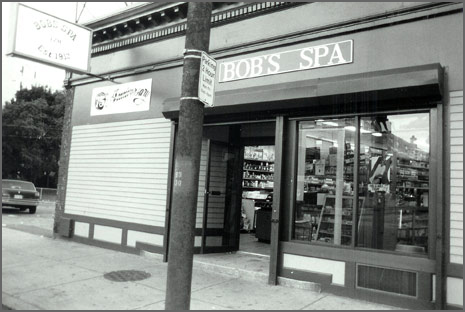 Bob’s Spa, 1987
Bob’s Spa, 1987
Memories
Everyone seems to have a different favorite memory of Bob’s Spa. Many recall the festive neighborhood gathering packed in after each of the Sunday morning services at nearby St. Thomas Church.
Commuters remember sitting out a wintry snowstorm inside the warm store waiting for the snowplowing streetcar to come up from the Arborway, followed by the big center entrance streetcar to get them to school, work, shopping etc.
Several generations remember “hanging out” at the store’s front door. Bob tolerated it but Johnny thought the kids’ presence was an effective deterrent to hold-ups.
As a meeting place/waiting room it was unsurpassed, offering jumbo 25-cent bologna and cheese sandwiches on super sized Kasanof’s Bakery bulkie rolls and hot coffee and delicious donuts made by Mike’s donuts up the street. In later years, Johnny remembers three or four different coffee klatches of seniors that would gather at the fountain at their regular times each morning.
In earlier years, who could forget the creamy smooth homemade ice cream Bob developed in his Depression era ice cream machine. Only two other local establishments could boast ownership of the same long cylindrical ice cream machine; Sammy’s Drugstore at Green and Elm Streets, and Busy Bee Spa up at Hyde Square. 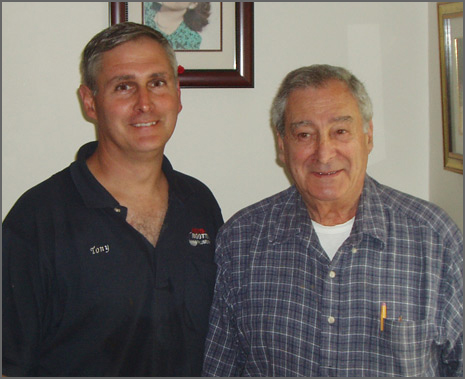 Anthony and John Ristuccia, 2009
Anthony and John Ristuccia, 2009
The unique feature of a five-cent cone at Bob’s was that the mixed ice cream was first discharged from the machine into a paper cone-shaped wrapper and a paper lid was placed on top. Batches of these paper-wrapped cone shapes would then go in the freezer until ready to be served. When you ordered one, the spiral paper wrapping would be unwound while the cone was upside down on the server’s palm. It would then be flipped over into a sugar or cake cone, and finally the top paper lid peeled off. Bob often claimed that this machine saved the store during the Depression and he was thankful that he could offer a penny sale on a second pint (normally forty cents) of ice cream at the ends of the dreary depression months to help pay the rent during those tough times.
The soda fountain had been installed in the 1920’s and was typical of the period with the marble top, high wire-back seats and the array of containers for ingredients of frappes, milk shakes, sundaes etc. Bob’s frappes and sundaes were unsurpassed with the generous serving of always-fresh ingredients and toppings he used. Root beer floats at the soda fountain looked like an old time beer ad with a huge head of foamy root beer and a scoop of ice cream afloat in it. And the tonic cooler would be jammed packed with tall ice cold Royal Crown, Pepsi and Nehi Orange drinks to be enjoyed with a Devil Dog that in those days was about a foot long, or so it seemed.
Attesting to Bob’s trust in his young customers, and the knowledge that weekly Confession loomed for most of us, the glass penny candy case, in full view of all, could be accessed from its rear where a small brown paper bag would be filled by the young customer with an amount of penny candy he or she desired. The bag would then be brought to the tobacco counter and the youngster would declare its value. Seldom, if ever, was the bag’s contents checked against the declared value. Bob had an unerring eye for character and besides; one wouldn’t dare violate the established honor system.
A Grandson Takes the Helm
Johnny’s son, Anthony Ristuccia, was born on March 16, 1960 and became the third generation to manage the store when his father retired in 1992 at age 65. Anthony, his wife Donna and their two children, live in Norwood, MA.
Anthony lost no time getting the store into the 20th century, if somewhat belatedly, by installing Western Union, credit cards, and a direct store telephone that precluded the need to ring home three times from one of the three phone booths, get the nickel or dime back, and await the call back. Of course these callbacks were never taken in the third phone booth over in the corner that was reserved for the bookies’ use only.
In 1995 Anthony bought Patterson’s Liquor Store next door and Bob’s expanded again. This addition generated a new revenue stream along with its related responsibility for store management.
The store continued to change and grow, but the basic premise of great customer relations never changed nor, however, did the long hours and infrequent vacations. So, seeking a career that would allow him more time with his family, Anthony sold the store in June 2001 to William R. Fernandez.
A New Era
William R. Fernandez owns the store now and it’s called Fernandez Spa and Liquors. He also owns the entire Patterson block that originally rented to Bob’s Spa. Bill’s family owns several other liquor stores as well. 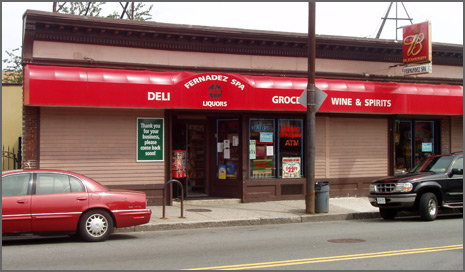 Fernandez Spa, 2009
Fernandez Spa, 2009
Bill came here from the Dominican Republic in 1984 and attended Dorchester High School. He presently lives in Roslindale with his wife Maria and their three children.
His observations since buying Bob’s Spa are the wonderful reception that they’ve had as new owners of a store with such a long and rich neighborhood tradition and the constant flow of people who grew up with the store coming in and mentioning the pleasant memories it has for them.
Bill Fernandez is proud to continue the goodwill and reputation of this local landmark and he’s very grateful to the Ristuccia family for all that they’ve done to help him launch the new era of Bob’s Spa.
Looking Back
While the Ristuccia era as ended, the lasting memories of the place continue to enrich the lives of generations of former patrons. The Ristuccias really cared for their customers and their customers cared about them. As the store nears its 100th birthday, rolling along under Bill Fernandez’s watchful eye, we can only imagine what the young immigrant from Malfa, Sicily, would think about his cherished fruit stand. We think he would be proud indeed.
Boulder at Kelley Circle Reveals History
 Any reporter must visit the scene of a story, but getting onto Kelley Circle, through constantly moving traffic, is no mean feat - not quite like getting to Paris' Arc de Triomphe, but close. This risk component must have been a rich incentive to the unknowns with their paint pots last fall. All-hiding night must have been the time of the pointless attack on an initially defenseless stone, which commemorates William F. Kelley, yet this disrespectful act produced interesting results.
Any reporter must visit the scene of a story, but getting onto Kelley Circle, through constantly moving traffic, is no mean feat - not quite like getting to Paris' Arc de Triomphe, but close. This risk component must have been a rich incentive to the unknowns with their paint pots last fall. All-hiding night must have been the time of the pointless attack on an initially defenseless stone, which commemorates William F. Kelley, yet this disrespectful act produced interesting results.
My visit to Kelley Circle yielded his birth and death dates and the knowledge that Kelley was a member of the Board of Park Commissioners. This was novel information, since any bet was that Kelley Circle was named for a Jamaica Plain veteran like Murray Circle above it. The best source of further information was Kelley's obituary and then the appropriate city departments.
William Kelley was born of Irish parentage here on September 14, 1893 and was a fine representative of the many thousands of Irish immigrant families who came to Massachusetts' shores and made good. He served his country during World War I and entered the ranks of the New England Telephone & Telegraph Company.
At the time of his death, Kelley was vice-president and business manager of Local 1 of the International Brotherhood of Telephone Workers. He had risen through the same ranks as Maurice Tobin, who branched out into politics to become mayor and governor. Indeed, Tobin's name appears on the plaque as mayor of Boston at the time. Kelley was sworn in as a member of the Board of Park Commissioners, on May 27, 1938, under the aegis of chief commissioner, William Long, fabled in Jamaica Plain for his particular care of Olmsted Park all the way from the Arboretum to Leverett Pond. In those days half a century ago prominent and interested citizens sat on the board as unpaid advisors. According to Park Department records Kelley never missed a meeting, but discussions were not recorded.
Kelley sat in these meetings with Jamaica Plain beer baron Theodore H. Haffenreffer (l880-1956), whose presence on the Park Commission from 1930 to 1956 caused granite tablets to be placed by the main gates of the Boston Public Garden. The connecting pathway over the lagoon bridge was dubbed "Haffenreffer Walk" during the administration of James Michael Curley's successor, John Hynes, in the late 1950's. The tablets' last lines proclaim Haffenreffer's "Lifetime of dedicated service to his native city" in a rare tribute to the many, many German immigrants who have passed through the City of Boston and in particular through its southern neighborhoods, including Jamaica Plain. A familiar text might have been applied to Kelley's plaque, but rather the prosaic, "May he rest in peace," ends the text before the names of the mayor and his fellow commissioners.
The quick ending is probably explained by the shock felt at the unexpected death of Kelley of heart attack on October 17, 1943 at age 50 at his home at 3 Glenburne Road in West Roxbury He was buried at a Solemn High Mass of Requiem at Holy Name Church with the mayor, the chief justice of the Supreme Judicial Court and the president of the New England Telephone & Telegraph in attendance.
The obituary, brief as it is, tells much. The Kelleys had no children, but Mayor Tobin soon appointed a brother, Frank, to succeed the board. Frank later became chief commissioner with a fine office in the Parkman House, where the Parks Department was headquartered.
After a visit, the life of William Kelley had gotten illumination, but there was still the besmirched boulder. Who would clean it up in an area of double administration? A visit to the Department of Veterans Affairs turned up that Kelley's birth and death dates, cause of death and place of burial were on file with an invitation being issued to lay the whole matter out to the commissioner in a letter.
Among other things, Veterans Affairs makes sure that signs erected to veterans at intersections all over the city stay up. Those omnipresent small memorials are fitting reminders, in an age of peace, of veterans' sacrifice for a way of life we all take for granted. Could this office assume responsibility for a plaque once erected by the Park Department now on MDC traffic control and cut through the various Gordian Knots of jurisdiction?
In less than a month a letter in full sympathy at "the horrendous action" praising a citizen's publicity of such a matter was received. Disrespect for property is bad enough but dishonoring a person's name, especially one who has served his country in perilous time, carries with it no redeeming feature. The commissioner himself visited the site of the vandalized boulder and went beyond the call of duty to arrange for cleaning both stone and plaque.
The memorial stone is now clean again and looking surprisingly better than ever thanks to the Veterans Affairs Commissioner. He made a bit of the landscape more honorable and caused a lifetime to be commemorated.
Sources: Veterans Affairs Dept.; John Ruck of Parks Dept.; Obituary in Boston Globe Oct. 19, 1943
Written by Walter H. Marx. Reprinted with permission from the February 10, 1995 Jamaica Plain Gazette. Copyright © Gazette Publications, Inc.
Boy Shot by Trap Gun While Stealing Grapes on Boylston
Published in the Boston Daily Globe on September 24, 1907
Two applications for warrants are pending in the West Roxbury Municipal Court because of the trap-gun shooting which occurred late Sunday night, while Henry Cantwell, the 15 year-old Roxbury boy, was near the grape trellis in the garden of Frank D. Seiberlich of 4 Boylston St., Jamaica Plain.
Henry Cantwell is now at the City Hospital with a wound in his thigh.
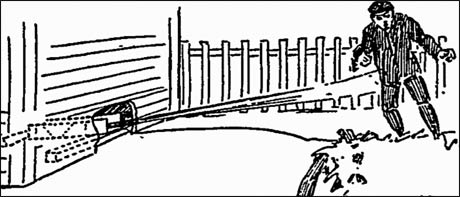
Sketch showing how gun was concealed in house and relative location of boy when shot.
Edward Cantwell, father of the boy, yesterday made complaint to Judge Perrins against Mr. Seiberlich for assault on his son. No warrant was issued and it is said that not even a summons will be made until the injured boy is able to appear in court.
Today Mr. Seiberlich will ask the court for a warrant for the arrest of Henry Cantwell for trespass.
Henry Cantwell is suffering from what was at first termed a gunshot wound, but the physicians there state positively that there was no bullet nor shot of any size found in the wound. “The effect was just what would be expected from a blank cartridge,” is the report. “The wound is on the thigh, and from this wound were taken pieces of burnt powder and wadding.”
This wound from the gun appears to be the only one from which the lad is suffering, and even this is not considered serious at the hospital, the only fear being that blood poison may set in.
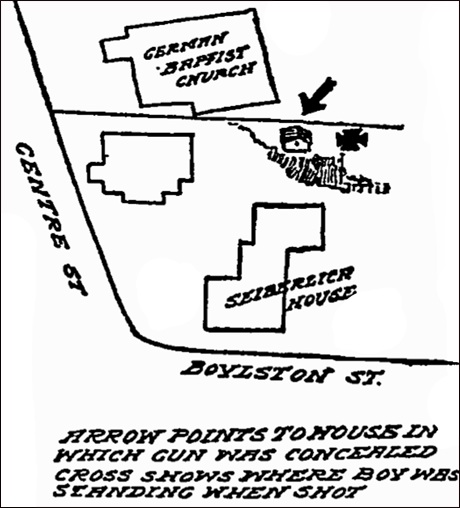
The house in which the gun was set up is of one story, with pitch roof, and is on the top of the ledge near the rear end of the Seiberlich residence. The arrangement for its discharge was rather ingenious.
An old Springfield rifle was made fast in a carpenter’s miter box, which was raised from the floor of the house by two pieces of two-inch joist, one at each end. This gave room for the butt of the rifle to rest securely on the floor, and the barrel of the rifle was made fast to the bottom of the box.
A piece of wood about six inches long, which worked on a pivot, was attached to the side of the miter box, and a second piece of wood made fast to that reached to the trigger of the rifle and was operated by a wire that ran out through the house to the fence and along the length of the fence. An opening was made in the front of the building to allow of the discharge of the gun outside of it. If the wire on the fence were touched by any one climbing over it the gun would be discharged.
The boy Cantwell is supposed to have got to the fence at the top of the ledge by going through the grounds of the German Baptist Church on Center St., some distance from the Seiberlich residence. The top of the ledge is higher than the second-story windows of Mr. Seiberlich’s home.
“It is my opinion that the boy was on the fence, and when the gun went off that it frightened him and he fell down the ledge of rocks under the fence and got his hurts that way. The gun was not charged with shot and therefore he could not have shots in his wounds.”
Such was the comment of Frank B. Seiberlich, uncle of Ex-Senator Frank Seiberlich at his residence, 4 Boylston St., Jamaica Plain, last evening, when questioned by a Globe reporter about the alleged shooting of Henry Cantwell, 15 years old, of 251 Heath St., Roxbury, who claims he was shot by the discharge of a gun on the premises of Mr. Seiberlich about 8 o’clock Sunday night, and was taken to the City Hospital by his companion, John Weil, 13 years old, of 58 Chestnut Ave., Roxbury, to have the gunshot wound in his right thigh dressed.
Mr. Seiberlich is much incensed at the stories that have been published about the affair, and said: “I will give you the true story”.
“I put up a fence at the top of the ledge of rocks and wired it in such a way that no one could get over the fence to my grapevine without striking a wire that connected with a gun I had set up in the summer house near the grapevine, and would discharge it. The gun is an old Springfield rifle and was loaded with coarse powder and paper wadding. There was no shot in it. It was set in such a way that the wadding from the gun would have struck the boy in the shoulder and not in the thigh.
“I went to bed at 7 pm. About 8 pm my wife woke me up and said the gun had gone off. I got up and looked out of the window, but could not see anyone and heard no outcry. About 1 am four policemen came to my house and woke me up and said they had heard the boy’s story and they wanted to hear my story. I told them there was a gun there charged with a little powder and paper wadding, and that I had put it there for a ‘scarecrow.’ I showed them the place where the gun was and the police took the gun and the fastenings on the floor, the powder and the caps. I was told by the police that a boy had been shot by the gun.
“It is my opinion that the boy was on the fence, and when the gun discharged it frightened him, and he fell down the ledge at the back of the yard, which is 18 or 20 feet high, and got his hurts that way. There was no shot in the gun. I am not so cruel as to want to shoot a boy for stealing my grapes. The fence is eight feet away from the gun. Last Sunday noon the gun went off when I was working near the fence and it did not hurt me. Last year it went off once, and this year it has gone off twice. I am hard of hearing and I rigged up the gun so that if it went off I would know that boys were stealing my grapes.
“The boys that come out here from Roxbury are a nuisance. They steal all the fruit they can lay their hands on, and have made it so disagreeable for me that I am seriously thinking of selling the place. Tomorrow I am going to get out a warrant for the arrest of the boy on the charge of trespass. No summons has been served on me and I don’t know what they can arrest me for anyway. I did not fire the gun.”
Mr. Seiberlich is a veteran of the Civil War and has been a resident of Jamaica Plain many years. The house he occupies is the oldest dwelling in the West Roxbury District and its record dates back to 1722, and it is said to have been an old house then.
At Police Division 13, there is an entry on the journal that reads: “Henry Cantwell, 15 years old, living at 251 Heath St., Roxbury. Gunshot wound in right hip received while attempting to steal grapes from the premises of Frank B. Seiberlich, 4 Boylston St., Sunday night about 8 pm.
Complaint has been made by the father of the boy Cantwell against Frank B. Seiberlich for assault on Henry Cantwell. That complaint has been entertained by Judge Perrins of the Municipal Court at Jamaica Plain, but no summons will be issued for his appearance until the injured boy is able to appear in court.
Edward Cantwell, father of the boy who was shot, was last seen last night at his home, 251 Centre St., Roxbury. He is employed as an operator at the Columbia Road ledge. Young Cantwell worked in the Plant shoe factory. Mr. Cantwell at first declined to say anything about the matter and referred reporters to his attorneys. Henry Cantwell was 15 years old and a graduate of the Cheverus Parochial School.
Mr. Cantwell said that he considered the affair and outrage and believed that steps should be taken to prevent a recurrence. He said that such a thing as placing a gun trap was wholly unnecessary, and that if the boys had been stealing grapes other means than that of a rifle could have been used to stop them.
He visited his son at the City Hospital yesterday afternoon, but what the boy had to say he refused to divulge. It is expected that young Cantwell will be released from the hospital within 10 days.
Buff & Buff Manufacturing Company
By Chris Globig
Buff & Buff Manufacturing Company occupied the site of what is now the Buff Condominiums at 329R Lamartine Street in Jamaica Plain until the mid-1980’s . Buff & Buff manufactured and repaired a variety of precision engineering instruments, most notably surveying transits and theodolites. 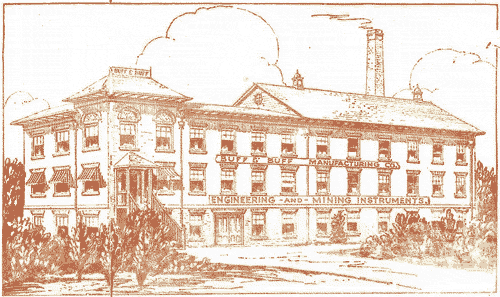
Image courtesy of Elise & Peter Pogorski
George Louis Buff started the company in 1898 with his son Louis, a transitman, after the dissolution of his previous enterprise, Buff & Berger, located at 9 Province Court in Boston. It seems George had plenty of experience in the precision instrument business, having worked for various instrument firms in his native Germany, and later in England and New York.
In 1900, the same year that George’s second son Carl joined Buff & Buff as a clerk, George applied for a building permit to construct a stone foundation, two-story brick building with a flat roof for light manufacturing on a portion of land he had bought in 1890, and where he currently resided. This encompassed what is now 23 Cheshire Street and 321-327 Lamartine. After 1901, ads in the Boston City directory gave the company’s address as 329 Lamartine. George and his wife Mary lived at 23 Cheshire together until her death from Brights disease (nephritis) in 1892 at the age of 47. George continued to live at 23 Cheshire until his death in 1923.
One of the critical pieces of equipment for making surveying instruments was called a circular dividing engine. George had two, one 28.5 inches in diameter which he built in 1899, and the other 48 inches in diameter, which he acquired in 1903. He had improved on earlier transit designs from 1866, calling his new product Buff’s Precise Transit, and, with the use of his dividing engines, manufactured it in his new factory for many years. For the cross-hairs on the instruments’ eyepieces, he used spider silk. Spiders were collected each year from the banks of the Charles River and kept in the factory’s basement on racks designed to encourage the spiders to spin silk onto reels for use in the factory.
Buff & Buff was incorporated in Massachusetts in 1904, but it wasn’t until 1907 that George deeded the rear portion of 325-327 Lamartine to the Buff & Buff Manufacturing Company. That same year, his eldest son Louis married and moved out of the house at 23 Cheshire. Shortly thereafter in 1908, Carl, not quite 31, died of typhoid fever. By 1909, George’s third son Henry had joined the company as a clerk. In 1918, they added a roofed wooden platform and steps to the factory building.
When George died in 1923, Louis became President of Buff & Buff Manufacturing. In 1926, Louis added a one-story wooden addition on a concrete foundation to the factory and Henry became Vice President of Buff & Buff. By then, Louis was involved with several other companies, and remained President of both the Babson-Dow Manufacturing Company and the Henrici Laundry Machinery Company until he died in 1941.
Upon Louis’s death at age 65 from pancreatic cancer, Henry took over the reins. Henry, who never married and continued to reside at 23 Cheshire Street, presided over the company until 1975, when Frank Dow took over the position of President. Henry died of atherosclerosis in 1976, at the age of 91. Frank incorporated under the new name of Buff Instruments Corporation in 1979, but that company was involuntarily dissolved in 1983. Around 1984 a salvage operation was undertaken by the Liberty Tool Company and a multitude of parts, miscellaneous equipment and valuable lithographs were found in the old factory. Today these artifacts can be found in the Davistown Museum in Liberty Maine.
In the early 1970’s, Sheldon Weinstein and Warren Cossit acquired the land at 321-323, 325-327, and 329R Lamartine Street. In 1979, Anne Dow bought the parcels. She sold 325-327 Lamartine in 1981, and in 1985 a real estate trust bought the remaining lots. Use of the building that housed the Buff factory was first changed from light manufacturing to light manufacturing, artists’ studios and offices, and later to a six-family dwelling. The master deed for Buff condominiums, covering the land formerly occupied by Buff & Buff Manufacturing, was recorded in 1990.
References:
Smithsonian website
http://americanhistory.si.edu/collections/surveying/maker.cfm?makerid=7
Davistown Museum
http://davistownmuseum.org/bioBuff.html
Two photographs of Buff & Buff transits, courtesy of Danielle Stone, may be viewed here:
http://www.jphs.org/storage/buff-and-buff/462.JPG
http://www.jphs.org/storage/buff-and-buff/465.JPG
A postcard sent by Buff & Buff to a customer:
front
back
Note:
Birth, marriage and death data from Massachusetts State Archives.
Property data from Suffolk Registry of Deeds and Massachusetts State Archives.
Building data from Boston Inspectional Services permits.
Copyright © 2005 Jamaica Plain Historical Society
Classic Cleaners Celebrates Golden Anniversary
Eisenhower was president, and the first baby-boomers had
just started school. Men still wore suits and hats, while
most women wore dresses and stayed home. But change was in
the air. The Cold War sent a nuclear chill around the world.
In the newly sprouting suburbs, supermarkets began to
replace neighborhood grocery stores. Television and
advertising entered their golden ages. Marilyn Monroe
appeared nude in the first issue of Playboy. Teens sporting
duck-tails and poodle cuts would soon be gyrating to the
rebellious beat of rock ‘n’ roll. A truck driver named Elvis
turned 18, Martin Luther King, 24. An average family income
was about $3,000. A modern house went for $14,000. A Philco
TV cost $200. And for 50 cents you could get a jacket
dry-cleaned at a new shop on the corner of Centre and Green
streets called Classic Cleaners.
Icons like Martin, Marilyn and Elvis now belong to the
ages-but Classic Cleaners, started by Al Pavone in October,
1953, survives as the grand dame of Centre Street,
outlasting most of its dozen or more competitors to
celebrate its 50th anniversary this month.
“When I started out, Centre Street was a much more diverse
shopping district,” said Al Pavone, a 1948 graduate of
Wentworth Institute who like many other World War II
veterans was just beginning a family and career. “It was a
very busy street, with clothing stores, baby shops, shoe
stores, jewelers, pharmacies-basically, everything residents
needed. “And of course, there were lots of other cleaners
nearby. When I bought the old Cleaning by Adele business
some people thought I was crazy…”
“And some of us still think that,” joked his son, Mike
Pavone, who took over the shop in the early 1980s after his
dad retired. “Hey, don’t interrupt me. I don’t want to be
late for my tee-off time,” Al said with a wink as they both
laughed. “Now where was I?” “The golf course,” his son
rejoined.
The two laughed again, displaying the personal rapport that
attracts loyal customers with the grace of Hope and Crosby.
“We have a lot of fun here,” Debbie Carmichael, an employee
at Classic Cleaners for 24 years, admitted. “We laugh every
day. Al and Mike are great to work for.”
“They sure are,” replied her sister, Patty, who has worked
there for 20 years. “Mike is like a big brother to us.” As
she walked out the door, Jamaica Plain resident Phyllis
Isberg noted “There’s another cleaner close to my house, but
I use Classic because of the great service and friendly
atmosphere. I can see why they’ve been in business for 50
years. Congratulations.”
But Al Pavone pointed out it took a lot more than a couple
of laughs to stay in business half a century. Long hours and
hard work were, and are, the norm. “When I bought the place
it was like an empty barn inside,” he said. “There were no
clothes on the racks and not many customers. But one day a
salesman walked in and put a mannequin wearing a wedding
dress in the window. When people realized we were good
enough to clean something like that, business picked up. But
it still took a long time to really build up the business.”
The clientele included some real characters, Al Pavone
recalled, like the mobsters who dropped off clothes with
guns in the pockets.
On a more serious note, Mike Pavone, who began working
Saturdays at the store when he was 11, said, “You know, we
still have some customers from the 1950s. We appreciate
their trust for so long.”
Mike Pavone went on to say his business, like most others’,
has dipped since the Sept. 11 attacks two years ago. “But
I’m optimistic. I don’t fault anyone, we just try to do the
best work we can.” That includes investing something
back into the community. In addition to sponsoring Regan
League baseball teams for years, Classic donates 50 cents
from each order to the Jimmy Fund or AIDS Action Committee,
with $1,500 already collected for each.
And as part of their 50th celebration, for 50 weeks they are
having a drawing for $50 worth of dry cleaning. Classic
Cleaners offers a full line of services, including dry
cleaning, shoe repair, tailoring, leather cleaning and
regular laundering. “Our motto is: If you can wear it or
tear it, we can clean it or repair it,” Al Pavone said.
Asked what the best thing has been about 50 years of
business, Al’s countenance transformed from a sidekick to a
father. “Working with Mike. It’s great to see your son take
over the business.” “Dad taught me a lot,” Mike Pavone
replied as he slung an arm over his father’s shoulder. “I
appreciate his confidence in me.”
For more information call Mike, Debbie or Patty at 524-9852.
Just don’t ask for Al, he’s in Florida now, on the golf
course.
Written by John Swan. Reprinted with permission from the October 10, 2003 Jamaica Plain Gazette.
Copyright © Gazette Publications, Inc.
Coffee Tree on McBride Street
Prohibition Killed a Coffee Tree on McBride Street
–But It Made a Surprising Recovery
By Peter O’Brien, February, 2010
A Grand Opening
On June 29, 1898, three well-known Boston beer and ale brewers opened a handsome new Inn at 16 Keyes Street, Jamaica Plain. The owners, Bradley & Farmer, Rueter & Co., and A.J. Houghton & Co. called it the Coffee Tree Inn, naming it for a coffee tree that once grew on the site.
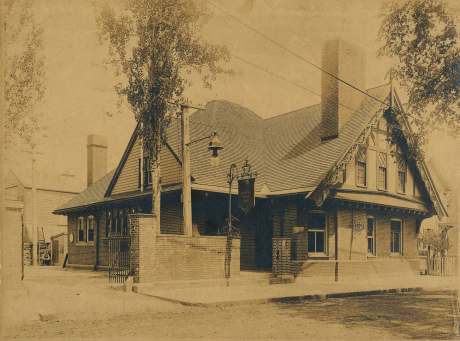
Keyes Street Re-named McBride Street
Keyes Street was laid out in 1850 and named for John Keyes who was a local tanner, making leather from animal hides.
David Greenough developed the land he had bought from the Loring estate that included Keyes Street. Greenough proposed 50-foot lots on Keyes Street for sale to the Irish immigrants flooding into the area to work as laborers and domestics in the burgeoning Jamaica Plain economy. Thus, the area became known as “Little Ireland.” Later, growth of the Boston Gas Company, further down Keyes Street, brought even more Irish labor and tavern customers to the area.
In 1921, several Jamaica Plain streets, squares and playgrounds were renamed to honor World War I heroes who had been killed in that war. Keyes Street was renamed for Corporal John J. McBride who was born on Keyes Street and had been killed in France.
The Coffee Tree
A coffee tree growing on McBride Street would strike anyone who ever tried to grow tomatoes there as an astonishing horticultural achievement. However, there is a coffee tree, unrelated to the tropical coffee plant that produces our morning coffee, native to the eastern and central United States. A member of the bean or legume family, the Kentucky Coffeetree (Gymnocladus dioicus) produces a bean which early settlers in Kentucky used to make a bitter, low-grade coffee substitute. It is a fairly common, large deciduous tree with about twenty specimens presently growing in the Arnold Arboretum, one of which dates to 1873, planted just a year after the Arboretum opened. Another labeled specimen is presently growing along the sidewalk near the tennis courts just east of the Shattuck Hospital. A Kentucky Coffeetree could grow in Massachusetts but how did one find its way to McBride Street?
Whether the owners knew or cared how it got there, the tree became the logo for the Inn and it can be seen on the Inn’s sign. Although not documented, the tree logo was also used in an approximately five-foot diameter tile mosaic in the floor of the main room of the Inn. A long-time Jamaica Plain resident, Mrs. Constance (Cuddy) Buckley, clearly remembers this mosaic before it was covered with machinery in the building’s later life. In that later life the new owners also remembered the tile mosaic in the floor.
The Inn
The Inn was designed by Boston architect J. William Beal. Mr. Henry A. Rueter suggested its conceptual design based on his survey of popular English and German taverns. Rueter, who owned the Highland Spring Brewery in Roxbury, was President of the United States Brewers’ Association. His estate was on the Jamaicaway where Jamaica Towers is presently located. Rueter and the other owners apparently felt that while the final design of the building might not blend with the neighborhood’s modest architecture, the Inn’s European Tudor design elements would resonate with the large and growing immigrant population in Jamaica Plain, especially those living and traveling on McBride Street.
The Inn’s design called for dark red burned brick for the first floor with typical Tudor style half-timbered and stuccoed walls above. A beautifully decorated gable was painted in deep green. The overhanging eaves were trimmed with relief-carved bargeboards in a sinuous stylized grapevine pattern. A carved finial at the peak faced the street.
An elegant cast iron sign, illuminated by an early electric arc light, hung near the walled-in entrance to the Inn. Another cast iron sign advertising Sterling Ale was mounted to the front of the building near the square entrance porch. 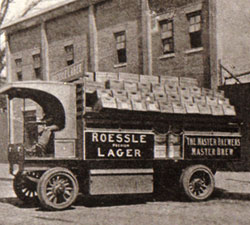 Cast iron gates secured the driveway that was flanked by birch trees and led from the un-paved McBride Street to the rear delivery area. One can imagine the delivery wagon with its stacked cases or kegs of beer navigating between the brick columns supporting the gates. Rounded granite bumper blocks protected the bases of the columns. These blocks were important architectural features in the horse drawn wagon era with its iron-rimmed wheels. They became less important later when motor trucks with rubber tires could more accurately navigate the opening.
Cast iron gates secured the driveway that was flanked by birch trees and led from the un-paved McBride Street to the rear delivery area. One can imagine the delivery wagon with its stacked cases or kegs of beer navigating between the brick columns supporting the gates. Rounded granite bumper blocks protected the bases of the columns. These blocks were important architectural features in the horse drawn wagon era with its iron-rimmed wheels. They became less important later when motor trucks with rubber tires could more accurately navigate the opening.
The diamond pane leaded windows reinforced the Tudor design concept. Beautiful stained glass windows with English and Germanic heraldic emblems graced the side of the building facing the driveway. The stained glass windows remained long after the Inn was closed and the later owners of the building remember them well.
The footprint of the main room in the Inn was about 40 feet square, with carved oak paneling all around and an oak bar on three sides. A tall oak screen separating the bar from the dining area with its oak tables afforded privacy for diners. Customers could enjoy a slice of prime Westphalian ham with roasted potatoes and a mug of beer or ale in comparative privacy.
High above the bar a skylight admitted soft diffused light. The presence of the two light poles in the picture indicates that the Inn was electrified at some point. At night the glow of early electric lighting fixtures would then have illuminated the room.
A great fireplace of red sandstone stood just beside the entrance door. It can be located more precisely from the location of the massive (front) chimney in the steeply pitched roof. It must have been very pleasant with a crackling fire burning on a snowy winter’s night with a mix of brogues and other dialects engaged in lively conversation.
Signs were carved in the oak panels at the base of the skylight dome. One stated: “Enough Is Good Use - Too Much Is Abuse.”
Bartenders
One profession that kept many men working in the early 20th century was bartending. It was a respected profession and bartender’s reputations and skills were widely known and discussed. The ability to keep a bar well stocked, clean, and properly serviced were the attributes of a good bartender. Keeping the beer pipes from the kegs below to the bar above cleaned out regularly and the floor covered with fresh sawdust were other measures of a barkeep’s performance. He also had to keep peace in the establishment and be sure over-drinking patrons were sent home before becoming inebriated, a state the Irish would quite naturally minimize as; “heyadafewinim,” (he had a few in him.) And, above all, the attentive bartender had to manage the “cuff,” his record of charged drinks recorded on his starched shirt cuff.
Thanks to the famous Doyle’s Café, founded 1882 and still going strong, we have a copy of an old Doyle’s menu that carried an undated song by M.C. Hanney. It named the many local Jamaica Plain barrooms and their bartenders and their attributes noted in each location. One verse mentions the Coffee Tree Inn:
“Then take a walk up Keyes Street, and you cannot fail to see
An ancient looking bar room, ‘tis called The Coffee Tree
They say that Bradley runs the place, when Mike Brady is not there
Mike’s Irish wit and pleasant ways, are always rich and rare … .”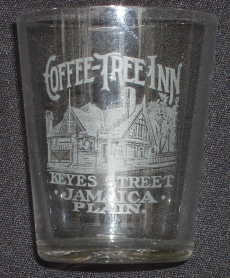 And thanks to another long-time Jamaica Plain resident, Michael Galvin, we have a picture of a genuine shot glass from The Coffee Tree Inn. Michael also allowed us to copy his beautiful Reuter’s Highland Spring Brewery sign. Michael’s eclectic collection of JP memorabilia includes one of the green cast iron water bubblers used around the corner from the Inn on South Street and two working gas street lights from nearby Boynton Street that were serviced morning and night by our local lamplighter, Mr. Shields, “who made the night a little brighter wherever he would go.”
And thanks to another long-time Jamaica Plain resident, Michael Galvin, we have a picture of a genuine shot glass from The Coffee Tree Inn. Michael also allowed us to copy his beautiful Reuter’s Highland Spring Brewery sign. Michael’s eclectic collection of JP memorabilia includes one of the green cast iron water bubblers used around the corner from the Inn on South Street and two working gas street lights from nearby Boynton Street that were serviced morning and night by our local lamplighter, Mr. Shields, “who made the night a little brighter wherever he would go.”
Neighbors and Customers
The Inn was located a few hundred yards from the Jamaica Plain streetcar car barns on South Street. The car barns site became the Jamaica Plain Loop after the barns were torn down in the 1930s; and 25 years later a public housing project was built there.
Among its clientele, the Inn probably served members of the Hampstead Club that was located on the second floor at 114a South Street at the corner of McBride and South Streets. In later years, Wilson’s meat market occupied the first floor at that address, and later still, the Ristuccia family (Bob’s Spa) bought the building. That building, on the corner of McBride Street, can be seen with the large striped awning behind the motorman in the photo of an 1898 streetcar leaving the South Street car barns.
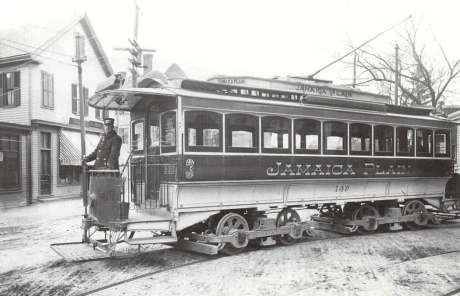
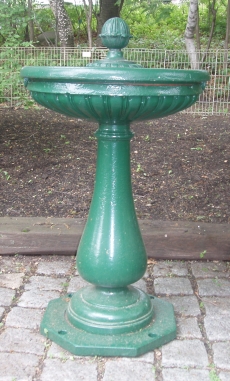 A short way up South Street, one of the green cast iron water bubblers, a copy of which resides in Michael Galvin’s garden, quenched summer thirsts.
A short way up South Street, one of the green cast iron water bubblers, a copy of which resides in Michael Galvin’s garden, quenched summer thirsts.
Another neighbor of the Coffee Tree Inn would have been the blacksmith shop, next door at 10 McBride Street. Ignatius J. Craffey founded the shop about 1910 and operated it until about 1925. John P. Mahoney, who formerly owned stables and a smithy at 716 Centre Street, took over and ran it until James ‘Jimmy’ Lovett bought it. Jimmy had arrived from Ballyferriter, County Kerry, Ireland in 1928, just a year after he witnessed Lindbergh’s historic flight over Ireland heading for Paris. Jimmy bought the shop from Mahoney’s widow in the mid 1930s and ran it until about 1961. Earlier the former stable at the front of the structure was removed, leaving only the small smithy shop at the rear of the lot.
Jimmy’s son, John Lovett, learned the trade and worked there as a youngster, helping his dad shoeing a diminishing horse population. Thus, John Lovett is probably the last resident farrier (blacksmith) in Jamaica Plain. 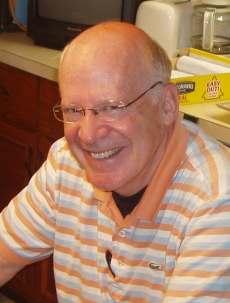 John LovettThe rhythmic pealing of Jimmy Lovett’s hammer on his anvil with streamers of hot sparks flying was our own version of the Blacksmith Blues long before that song hit No. 3 on the charts in 1952! It’s sad and so often true that we didn’t appreciate what colorful additions things like Lovett’s blacksmith shop and our lamplighter, Mr. Shields, made to our lives and neighborhood until much, much later. It’s especially true to those of us who took Forging (blacksmithing, not writing bad checks) at Mechanic Arts High School in Boston back then.
John LovettThe rhythmic pealing of Jimmy Lovett’s hammer on his anvil with streamers of hot sparks flying was our own version of the Blacksmith Blues long before that song hit No. 3 on the charts in 1952! It’s sad and so often true that we didn’t appreciate what colorful additions things like Lovett’s blacksmith shop and our lamplighter, Mr. Shields, made to our lives and neighborhood until much, much later. It’s especially true to those of us who took Forging (blacksmithing, not writing bad checks) at Mechanic Arts High School in Boston back then.
Prohibition Arrives
The Inn prospered until the Volstead Act, commonly called Prohibition, ended the country’s legal supply of alcoholic beverages in 1920. The Inn was then vacant for six years except that in 1924 a Daniel J. Hogan briefly appears as proprietor of the Coffee Tree Inn. Was Hogan attempting a comeback as a dry restaurant, or did he suspect early repeal of Prohibition? In any case, Prohibition, a well intentioned but failed experiment to control excessive drinking, was finally repealed in 1933
A New Life for the Building
In 1926, Joseph Yerkes (aka Joe Bags) of Brunswick Street, Roxbury, started the Washington Wet Wash, a commercial and residential wet wash laundry in the unoccupied Inn building. “Wet wash,” meant that your laundry was washed, but not dried. Later, Harry and Israel Yerkes joined their brother Joe as partners in the laundry enterprise. When Joe died, his wife, Betty, remarried a man named Kaplan and they lived in Brookline. The laundry was then in Betty’s name for a while. About 1951, Joe’s daughter, Helen Reinstein, and her husband Mel, took over operation of the laundry.
Many of our moms and neighbors worked at the laundry at one time or another. It was very heavy and hot work so turnover was high. One of the things that probably hastened the laundry’s demise was the overnight laundry service that was offered to stimulate business. Laundry picked up the night before would be delivered, in a repainted deep green hearse, early next morning! That door-to-door service went the way of all other home delivered things like bakery goods, diapers, twice-a-day mail delivery, milk, ice, fruit, vegetables and peddler’s wares as the age of the automobile arrived.
The Reinsteins, now of Delray Beach, Florida, remember the hearse, the tile mosaic, the stained glass windows and the fireplace in the building but little else of its fifty-year old well worn architectural features because they were busy trying to earn a living; not cataloguing the building’s formerly handsome details. They do, however, remember many of the local “characters” and tradesmen that worked there including the local bookie. The bookie already had a dedicated ‘private’ phone booth in Bob’s Spa around the corner at 128 South Street. Nevertheless this enterprising bookmaker wanted to put an “office” upstairs in the laundry, but Joe Yerkes, sensing potential problems in that arrangement wisely declined.
As the economy was improving, unskilled help was becoming hard to find and retain at the McBride Street location so in 1966 the laundry was moved to 830 Blue Hill Avenue as the Jamaica Plain Laundry and Dry Cleaners. It continued there until Oct 4, 1972 when it was finally closed.
The Inn is Demolished
It isn’t clear when the Inn/Wet Wash building was demolished or who owned it at the time.
The land is now owned by James’s Gate Pub and together with Lovett’s blacksmith shop’s land; the two abutting parcels form the present paved parking lot for the pub.
James’s Gate is located on the former site of Hester’s Tavern, irreverently known for years as “the chapel”, at 5 McBride Street, located across the street from the former Inn. In later lives, as times improved, Hester’s was elevated to “the cathedral” with little increase in either reverence or maintenance.
Bernard T. “Bonnie” Hester, a former bricklayer from Dalrymple Street, opened his tavern at 5 McBride Street in the mid-1930s and ran it until 1959 when it became McBride Lunch. Around 1967 it was called Joe Cunniff’s Bar. Cunniff was a long-time patron and former bartender. Thereafter it was Danny Harold’s, Dory Lounge, MacDonald’s and 5 McBride Lunch again until James’s Gate purchased and renovated the property in 1997.
James’s Gate’s extensive renovations with antique building materials replicated an Irish pub alongside a contemporary dining room in a building inspired by the St. James’s Gate Brewery in Dublin, home of Guinness Stout since 1759.
The Tradition Continues
So, 112 years after the Grand Opening of the Coffee Tree Inn, with the caveat that “Enough is Good Use - Too Much is Abuse,” the tradition of good food and drink for travelers and the residents of Little Ireland lives on in a nifty Irish pub on McBride Street.
And while the Inn, the blacksmith and the lamplighter are long gone, the memories of them, and of a great growing up in Jamaica Plain, are refreshed whenever we play their songs in our heads.
Sources and References
Boston Globe, June 30, 1898 and April 18, 1921
Doyle’s Café Menu (undated)
Remember Jamaica Plain? by Mark Bulger
JP Memorabilia by Michael “Mikey” Galvin
Song: The Blacksmith Blues by Jack Holmes, 1952
Song: The Old Lamplighter by Nat Simon and Charles Tobias, 1946
Frank Norton archives
James’s Gate Restaurant and Pub website
Special Thanks to John Lovett, Mrs. Constance (Cuddy) Buckley, Frank Ratta, James McNally, Paul Byrne, Anne (Hester) Devaney, Ira Yerkes, Mel and Helen Reinstein, Maggie Redfern, Arnold Arboretum, Visitor Education Assistant, and Diane Parks and Liane Lalor at the Boston Public Library, Central Library.
Doyle's Cafe Serves Up Brews And History
It's 1984, and a young businessman shows up at Doyle's Cafe, the landmark pub on Washington Street in Jamaica Plain that Bill, 52, runs with his older brothers, Ed and Jerry. The fella's trying to sell a new beer. He's having a tough day; in fact he's so angry that his face is busting out red, because the posh Ritz-Carlton told him his beer "wasn't up to their standards."

Burke laughs about it today: "We thought he was out of his mind, too. We were all Bud drinkers at the time. We said, 'What's this stuff?' But we put it on, anyway. In 10 minutes, everyone loved it."
The beer was Samuel Adams Boston Lager. The young businessman was Jim Koch, founder and chairman of the Boston Beer Co. The rest, as they say, is history. It seems history has a way of finding a home at Doyle's Cafe, a perpetually popular pub smack dab in the center of the city that looks like it witnessed its share of bare-knuckled brawls back in the days of "Boston Strongboy" John L. Sullivan. Antique-looking, oversized beer signs cover the facade. The floor planks inside are faded and worn by the better part of a century's worth of tipplers who have made their way to the long wooden bar. (The bar itself was moved to Doyle's from an even older pub early in the 20th century.) Pictures of Boston politicians - mostly Irish - adorn the walls.
Even Hollywood has been smitten by its charm. The pub has appeared in movies like "The Brink's Job" and "Celtic Pride," and out-of-towners today recognize Doyle's as the local watering hole for the characters of the Fox TV series "Boston Public."
Boston's Irish-American community has adopted the pub, too. Come Saturday, if past St. Patrick's Days are any indication, cops will direct traffic out front while bagpipe bands inside entertain the mayor, a veritable Who's Who of other local politicians, and a wall-to-wall crowd of singing, swaying Guinness drinkers.
Thanks to the youngest Burke's guidance, Doyle's has also grown into a classic American beer bar, with 26 carefully chosen draft beers, three hand-pulled cask ales, and a large selection of bottles. Burke orders the beer, takes the deliveries, cleans the lines, taps the kegs and otherwise does everything he can do to ensure the beer is in the best condition possible. (Among the beers you won't find at Doyle's are Anheuser-Busch products, which Burke now refuses to sell. This doesn't sit well with the Teamsters who deliver A-B beers; they protested outside Doyle's last St. Patrick's Day.)
 But Doyle's is more than just a great beer bar.
It's something of a museum of Boston brewing
history, and Billy is its curator. He takes great
pride in his role.
But Doyle's is more than just a great beer bar.
It's something of a museum of Boston brewing
history, and Billy is its curator. He takes great
pride in his role. "Burkes have been serving beer in Jamaica Plain since 1918," Billy says, first at the now-defunct Rossmore Tavern, which his grandparents owned, and at Doyle's, which Ed Burke bought from the Doyle family in 1969.
He makes his way down the cellar, where the pub is connected to the city's brewing legacy at, quite literally, its most elemental level. Stony Brook, which begins in Dedham and ends in the Fenway, runs right under the foundation of the pub. It was along Stony Brook that Irish and German immigrants built dozens of breweries in Jamaica Plain and Roxbury in the 19th century. The hollow, brick shells of many of these breweries can be seen today throughout the two neighborhoods, some with their names, such as Franklin Brewing Co. and American Brewing Co., still etched in granite and visible from the street.
The old Haffenraffer Brewery, a few blocks up Washington Street, sits along the brook, too. Today it's the home of the Boston Beer Co., and Doyle's is often the first place in America where you'll find new or experimental Samuel Adams beers.
After the most treacherous downpours, the brook bubbles up into the basement. A water line, two feet above the foundation, can be seen at various points along the cellar. The water fills a square hole cut out of the concrete where booze was hidden during Prohibition, and threatens an impressive collection of beer and brewery memorabilia.
The collection includes 12-year-old bottles of Chimay Grand Reserve and Thomas Hardy's Ale (beers "that get better with age," Burke says), and original bottles of Samuel Adams beers, with generic labels marked "sample." There's also a large collection of ads for nearly every beer and brewery that ever made Boston its home. Among them: Pickwick Ale ("ale that is ale"); J.J. Pfaff's "lager beer"; and the original Boston Beer Co., which touted itself as "America's oldest brewery" (it was established in 1828) and reminded folks that "Good Food Tastes Better with BB Stock Ale."
Beer cannot make its way up to the bar by itself, and the cellar houses a time capsule of beer-serving technology. An old electric beer pump sits next to the contemporary canisters of gas - carbon-dioxide and-or nitrogen - used to push beer today.
In another crowded section of the basement is a thin, five-foot tall brass, iron and wood handle with two brass cylinders at the bottom. Years ago, it would have been placed next to the bar, and the bartender would push it back and forth, creating air pressure to draw beer up out of the kegs in the cellar to the taps upstairs. It worked much like the manual keg pumps found at frat parties today.
There are more stories back upstairs. One of the centerpieces of the main barroom is a mural of Paul Revere's ride. The moon over Revere's shoulder does more than just illuminate the colonial countryside: it hides a bullet hole put there by one of the Burke brothers.
The brass railing in the center of the barroom is a late addition to the pub. It was placed there by the producers of "The Brink's Job." They wanted it back after filming was complete but were hoodwinked out of it by the Burke brothers.
Behind the bar is a small framed picture - something of a memorial, actually, of a gentleman to whom Bill Burke feels a special bit of gratitude. His name was George Dauberschmidt, and for years he worked for the breweries of Boston, installing and caring for draft lines.
"Back then breweries sent out someone to clean the lines, and everyone in the beer business knew George," Burke says. But, he adds, Dauberschmidt had a bit of a personality quirk. "He wouldn't show anybody how to do his work because he was afraid someone would take his job. But as I got older he took a shine to me, I guess, and taught me the trade."
And taught him well, as the thirsty crowds and national acclaim attest each and every day - but especially on St. Patrick's Day, when Burke expects to sell nearly 25 kegs of Guinness alone.
"We never had any idea we'd be this busy," Burke says. "But we always wanted to sell the best beer in town."
Written by Kerry J. Byrne. Photographs by Charlie Rosenberg, Jamaica Plain Historical Society archives. January 2003. Reprinted with permission from the March 11, 2001 Boston Herald. Copyright © Herald Media, Inc.
Doyle's History Talk by Gerry Burke
This article is based on a talk given by Gerry Burke to a meeting of the Jamaica Plain Historical Society the evening of November 9, 2005 at Doyle’s Café. Good evening! When I started to think about this presentation, I thought; “there’s roughly 120 years of history connected with the place so I’m going to have to condense it to a broad overview to give a good history of Doyle’s.”
Good evening! When I started to think about this presentation, I thought; “there’s roughly 120 years of history connected with the place so I’m going to have to condense it to a broad overview to give a good history of Doyle’s.”
So part of my show-and-tell is this picture, which was taken in December 1902, from the Forest Hills side of Washington Street showing progress of the work on Stony Brook and the Elevated Railway System going to Forest Hills. The Forest Hills work had progressed to a point approximately between Williams Street and Rossmore Road at that time. If you notice that fellow on the right, wearing a bowler hat, and standing next to the mailbox, he has a remarkable resemblance to my grandfather, Bill Burke. I’m not sure it’s him; it could have been, but I don’t know. In 1902 he was the owner of John Sheehan’s Tavern on the corner of Rossmore Road and Washington Street. It’s not there anymore; it was located where the parking lot in front of the Laundromat is found today.
In 1905 Bill Burke became President of the Ancient and Honorable Hibernians, Division 40, in Jamaica Plain and there he became very close with the Doyles over the ensuing years. The building behind the man in the picture is the original Doyle’s. The wall you see there encloses the grocery store. Halfway between the grocery store and the saloon on the other side are swinging doors that were used to enter and leave the saloon side. I can’t see anything on the windows, but I would assume the windows on the grocery side would say, “Fine Teas, Coffees, and so forth.” There is a sign on the other side but I can’t read it. The house in back still exists and Dennis Doyle, who built the original Doyle’s building, owned it. His son Barney assumed ownership after Dennis’ death in 1900.
Doyle’s did well all through the 1880’s and 1890’s. But with the burgeoning population coming out this way and with the Elevated Railway System in place, Barney said to himself, “I’m not going to be able to do this unless I expand the operation to keep up with the times.” He had considered a couple of options, including destroying the building, but he couldn’t do that, because it was only 20 years old! What he decided to do was to push it back roughly 60 feet toward Gartland Street and add a new building to the existing structure. And so the entire building was jacked up about eight inches and telephone poles were inserted under it as rollers. Horses and teams moved the existing building back to make room for the new building addition.
I have the original Specifications and Contract for the new Doyle building. The salient features of the two documents were (1) the call for nothing but Union Labor and (2) the use of only the best materials available.
So you’re now sitting in the original saloon of Doyle’s – the old Willow Athletic Club – as it was after the move. It now serves as our function room. You probably noticed the floor in this room is slightly elevated. This is because this is the original part of the building that had been raised for the rollers. The original bar was formerly against the wall in this room and when the new building was completed the bar was moved to where it is now, in the saloon on the Williams Street side of the building. This is the reverse of the original layout when the grocery store was on the Williams Street side.
The grocery store and the new saloon prospered in the new building from about 1910 to 1919 when Prohibition came in. Prohibition brought tough times and all the money spent on the expansion went down the drain as the Doyles were no longer interested in the business without the saloon. They had invested heavily in the new building that was built to last forever! So, they sealed-off the swinging doors that formerly connected the saloon and the grocery store and Doyle’s began its new life as a Speak-easy!
The grocery store, located in the room we’re meeting in tonight, stayed open and continued operating under the management of Luigi Salvi. Luigi Salvi’s family owned the saloon my grandfather operated at Rossmore Road. Due to Prohibition my grandfather had to close that saloon down also. But he kept it open as a Spa, selling fancy candy, notions, and so forth. However, it was really a front for a bootlegging operation. The deal was that he would supply the booze for Billy Doyle’s Speak-easy.
So over the years, while the Burkes and the Doyles became close friends, no one ever mentioned their business arrangement because anyone with Irish blood in him would know you’d never say anything about that, - the favorite expression being “tell ‘em nuthin!” In fact, because it was never discussed in my family, it was only through my own research later that I learned that my grandfather, Bill Burke, supplied the juice. Some have suggested that Joe Kennedy, JFK’s father, was involved, but he wasn’t. He was busy in the stock market at that time, while after Prohibition he became a liquor importer, among other things.
Then, in 1928, during the administration of Mayor Malcolm Nichols, the last Republican Mayor of Boston, my grandfather was granted the refreshment concession at Franklin Park. It included the Franklin Park Zoo, the Refectory, and the Golf Course. I don’t know if he did anything in the Refectory Building; a big cavernous building, but knowing Bill Burke, chances are he was selling juice from there too! However, my grandmother faithfully went to Mass and put enough money in the box at Lady of Lourdes to save his soul. Of course, the old Irish always said, “If you’re in the booze business you’re gonna die a violent death,” but the widows always said, “I’ll take the money anyway!” They lived in splendor thereafter.
Getting back to the new building, in 1909 they installed a new flat-rate telephone connection to the new saloon. You didn’t have to use money in it and you could get the latest ball game scores, boxing results, whatever you needed to know, including the numbers. It was located in the old telephone booth that used to be in the front room and then for years, before we got here, it was down the cellar.
So Doyle’s did well until Prohibition ended in 1933 and Francis Doyle came back in, taking over from Barney Doyle, around 1933 or 1934. At that time there was an Irish-American boxer named James J.Braddock who beat Max Baer in 1935 to become the heavyweight champion of the world. Joe Louis took the title from Braddock in 1937 but he always remained a favorite of the Boston Irish. At the time there was a Braddock Rye Whiskey from Maryland that was named after General Braddock, the Commander-in-Chief of the British Armed Forces on the continent during the French and Indian War. General Braddock was liked and respected by both sides until he was fatally wounded in a skirmish and died. Somehow, Francis Doyle got together with the Braddock Whiskey people and made the proposition that; while he could not sell their whiskey exclusively, he would ‘push’ it hard as he could, if they would agree to put a new front on the existing building which had fallen into disrepair during Prohibition and the Depression. The Braddock people agreed and installed new brickwork, a new window and paid for new signage. And that’s the origin of the Braddock Café. In 1939 the business’ name was officially changed to “F.J. Doyle and Company, dba Braddock Café.”
During Prohibition the Doyles had extensive land holdings in Jamaica Plain. There was plenty of development work to be done and by 1955 they had built the building at 18 Pond Street. Bill Doyle, who had taken over from Francis, had heard my grandmother was looking for a place and he gave her first refusal at a rent that would barely pay for an afternoon there today!
In the late 30’s and 40’s, with the kids going off to war, there were a couple of lean years but the slack was soon taken up by the expansion of local factories converting to war work. So, Doyle’s generally did well in the war and post-war years when the veterans returned until the late 40’s. Then Harry Truman came in and things were fine.
In the 50’s everyone just sailed along. The 50’s were a good time to be living in Jamaica Plain as some of those here tonight know. Graduating from Jamaica Plain High School in 1958 we are now looking forward to our fiftieth reunion coming up in 2008!
The early 60’s saw the young Irish Catholic kid from Boston, John F. Kennedy, elected President of the United States and everything was fine. Then when he was killed things just went all to hell in a handbasket as far as I’m concerned and this neighborhood began to change fast! It had started changing in the late 50’s as the boys and girls were getting out. Pushed on by the riots in ‘67 it was tough down here. This neighborhood from Forest Hills to Eggelston Square was really no-man’s land by the early 70’s; and, as many of you know, it wasn’t easy.
So, in 1971, Bill Doyle asked my brother Edward if he’d be interested in buying the place – “I’ll give your family first shot at it”, he said. I told Eddie he was crazy, “you’re out of your mind, Franklin Park is already gone and if we don’t get out of there we’re gonna get hurt!” But he said, “no, if we do it right and offer good food and drink and systematically exclude a lot of the jerks we grew up with and keep them out it’s gonna work!” So we went ahead with it.
Then we were lucky enough to get this fellow, Ted Pitman, who was the head chef at the Venetian Gardens. He lived up on Glade Avenue and we talked him into coming with us. We picked his brain and took his advice to buy only the finest food available and cook it right, - so he had a lot to do with putting us on the map. As a result, business got so good in the first room we had to something, so we expanded to this room, the old grocery store.
I was still doing my political work with Kevin White and I began decorating the walls with all this political material, all of which is authentic and original because I won’t put up reproductions. John L. Sullivan, the famous Irish boxer who was world heavyweight champion in 1882 came here often. His mother was from Roscommons, the same village as the Doyle family. His picture was on the wall along with Mike Kelly, the first Irish baseball hero.
We dedicated the main room in 1986. Mayor Raymond Flynn, named it in honor of the great Irish patriot Michael Collins. Ray Flynn had a lot to do with the success of this place and he is truly a great guy.
As things got better my brother Billy was in charge of beer operations and I handled food operations and public relations. Then one night, Eddie Martin, an aide to Senator Kennedy came in and said, “I really like this place, is there any chance that the Senator would get a good reception here?” I said “I’ll tell you what, we’re opening a new room in 1988 and I’ll name it in honor of the Senator’s maternal grandfather, John F. Fitzgerald.” So, on St. Patrick’s Day in 1988, Senator Kennedy dedicated this room, the old grocery store. I was originally going to name it the Sam Adams Room because Jim Cook had opened the Sam Adams Brewery here in Jamaica Plain.
This John F. Fitzgerald Room was the original grocery store. Over the years it had been occupied by The Willow Athletic Club, various tailors, cobblers, barbers and so forth. It had been closed off from the saloon by a wall and was in terrible shape when we took over. We removed the wall, cleaned up the old shops’ area, added a small room extension and began using this side.
In the 90’s things were going wonderful. We never had an incident of any kind. It was nothing like years ago when we’d announce “last call” and guys would say, “I’m not leaving, what are you going to do about it?” And we’d call Police Station 13 and they’d say “that’s your problem, we’re not going down there!” So we’d have to fight the “last call” crowd to get them to leave. Now the customers are saying “thank you very much, how much do I owe you?” at closing time. We can’t believe it!
A couple of years ago we opened the Tom Menino Room which is this room we added at the end of the Fitzgerald Room.
Some of you may recall that in 1964 three guys came in and announced it was a hold-up. They put a bullet in the wall over there near the Paul Revere picture. That isn’t the moon you see in the picture, it’s where the bullet hole was patched with plaster. They then pistol-whipped Tom McDonough, the bartender, and they ran out the door, not knowing that Billy Doyle, a former policeman, was crouched down behind the counter. Doyle then came out, opened the window, and shot one of the robbers four times, killing him. He then went outside and relieved him of his money. He then called Station 13 and they took the robber to City Hospital, but he was dead. Bill Doyle had a well-deserved reputation for being very frugal and the story goes that they were the only four shots he ever gave away for ‘nuthin.
My mother always said, “When Bill Doyle talks, you listen”. One day, during the energy crisis, he said, “You like to burn wood don’t ya?” I said “yes” and he said, “I’ve got some nice wood down the street.” So I went down with the truck and got some rotten wood from an old shack he owned nearby. It was filthy wood, just awful. It turned out that the City had cited him and had ordered him to get the wood out of there in three days, or else!
Bill Doyle also owned the Meehan Block at the corner of Glen Road and Washington Street. I was still working for the City and he let me park there and get the El upstairs to go in town. One day in November 1972, during the energy crisis, I got off the train and found him in the parking lot with a flashlight under his arm. He was getting old about this time and I said, “What are you doing here at this time of night Billy?” He said, “I shut the heat off on these bastards this morning so now I’m putting it back on!” Billy Doyle was quite a character.
My brother Billy decided a couple of years ago to leave the business. He went to work for Stop and Shop in their liquor operations. My brother Eddie got out recently too. So, I’m here, on a long leash, using the place as my clubhouse, and I’m in and out all day. My son Jerry took over in June of this year with my godson Christopher Spellman who’s from a great old Jamaica Plain family. And of course, I told them not to change anything, but I notice they’ve put in a couple of flat-screen TVs over the bar.. But that goes back to the old Doyle’s premise of “keeping up with the times.” I recall when we took over; Bill Doyle only had two ice cube trays, saying, “What the hell do you need an ice maker for?”
So that’s about it. I can take some questions now I guess.
Q. Isn’t there some kind of easement under this building?
Ans. Yes, the old Stony Brook that wandered from Stony Brook Reservation at High Point Village, in Hyde Park, to the Muddy River passed right under us, and all the properties along its route to the River. They decided to put Stony Brook in a culvert and cover it over. To do that they made a taking for easements to install the culvert underground. This was actually another reason for moving the building back originally. They granted a hundred year lease to occupy the easement which was up last year. But by logic and common sense we deserved the land anyway. When they demolished the Elevated you could see the culvert.
Q. I was wondering about the movies they made here.
Ans. Oh yes, there have been several movies shot here. There was The Brinks Robbery, The Celtics movie, The American Experience on James Michael Curley with David McCullough, The Irish in America, Mystic River, the Sam Adams beer ad in which my son appears and many other TV ads. There isn’t a month goes by when someone doesn’t come in to do some kind of an ad which we are happy to accommodate on a complimentary basis.
Q. Wasn’t there an old clothing store located here?
Ans. Yes, there was. It was Cappy’s Tailor Shop. It was on this end of the building. The Capone family ran it. (Not THAT Capone family!) The barbershop, with two pool tables was here too. Then this was the Viet Nam Veterans Post No.1, then the old Rossmore Associates - Jack Spinney and those guys, came back too. They had been in the old Norton’s bar room down the street. This was the late 70’s and these guys were dying off, one-a-month from overdoses, or suicide, and so forth. It was a very rough period.
Q. Has this building been put on the Historic Register?
Ans. No, it isn’t because you have to conform to their restrictions - you can’t do what you want to the building. You can open up any area of this building and you’ll find an old door, an old window or whatever; there’s so much character here as you can see in the pictures I sent around.
Q. Wasn’t this always, more-or-less, a workingman’s Pub? And when did women start coming in?
Ans. Yes, that’s what it always was - a workingman’s Pub. The women started after the First World War when they reluctantly came in to get their husbands out after Mass. They became more acceptable in the early 60’s. Remember, this was a tough neck of the woods.
As far as the political aspect of the place, it started with Ray Flynn in a lot of ways. I don’t remember any other Mayor before him coming in. Former Mayor Collins used to come in after he was out of office. We would drag Mayor Kevin White in here if there were something going on in Jamaica Plain. Generally, the advice to political candidates was to stay out of the gin mills – you’re not going to get any votes in there. But times have changed. In Mayor Curley’s time, if you wanted to petition him, you had to use the phone. But nowadays, Ray Flynn and Tom Menino practice retail politics – they bring it right to you, which in many ways is much better.
Q. Wasn’t there always a strong ethnic Irish presence here?
Ans. Yes there was, and a lot of Germans too! But mostly Irish. They would stop in here asking about work in the nearby factories, the Gas Company, and so forth. And many came in to cash their paychecks. When my own grandfather came from Galway he was told to go down to Doyle’s to ask about work at the Gas Company, Sturtevant’s, Franklin Park, the MBTA, Crittendon’s and other places.
Q. Has the removal of the MBTA’s elevated structure changed things much around here?
Ans. Oh yes, and I miss it a lot! There was nothing better than standing in the first car looking out the front window as the train headed in town. It was a lot of fun. And, of course, we now have to wash the windows more frequently!
Q. In the early 70’s there was a very multi-ethnic, multi-racial, group employed at the nearby Brookside Community Health Care where I worked. And everybody said, “We can all always go to Doyle’s”.
Ans. Yes, and remember, my grandfather, my father and my brother Eddie and I operated the refreshment concessions at Franklin Park, the greatest melting pot in the world! We worked with everybody up there. And we never forgot how oppressed the Irish had been in their own day and that always guided us in dealing with people. And if it weren’t for Teddy Pitman we wouldn’t have done what we did here.
Q. When did the Refectory Building at the Park come down?
Ans. About 1974. There had been several fires and in 1972 there had been an auction there. I stayed on a few more years at the Zoo. The Refectory became derelict and it was stripped of its ornate decoration. It was a sin. If they would take some money and fix the beautiful bear den at the Park it could be restored. Instead, there are street-people hanging out there and shooting-up. Demolition by neglect it’s called. Franklin Park is gone. I’m still very interested in the place. I was on the Board of Directors when Brian Rutledge was there. I took that poster of the three performing elephants off the wall of the Elephant House when it was abandoned. It reads “Molly, Ratty and Tony, Performing Elephants, presented to the Boston Post and the City of Boston by 70,000 Children, June 6, 1914.” These were old circus elephants purchased with contributions by the kids. They were brought to Fenway Park to an overflow crowd. Mayor Jim Curley had been in office for just a few months and, on behalf of the Boston Post, they were presented to him there. They were then paraded to Franklin Park. They passed away and were replaced by a succession of other elephants.
Q. Was that the Boston Post Newspaper?
Ans. Yes, the old Boston Post Newspaper which was around to the 1950’s. The publisher, Mr. Fox, worked in the back room of a nearby bookstore until the 1980’s. It was a Democratic newspaper.
Q. Was that a gorilla cage up on the hill at the Zoo?
Ans. No, from what I understand that was all farmland in the 1880’s and one of the landowner’s sons was interested in astronomy. To my knowledge there were never any gorillas in that cage. There were gorillas in the old Monkey House, however. When the Refectory was built, before the Zoo and Golf Course came, there was a carriage house built across the way, but it never worked because there was no attraction in it. So, when the Zoo was opened and there was an overflow of animals, they made the carriage house the Monkey House and that lasted until 1942 when Mayor Maurice Tobin, God rest him, closed it down due to the shortage of fuel during those early World War II days. That put my old man out of business in the Refectory. Maurice Tobin was a very honest man and he didn’t mind hurting someone if it benefited the City.
Well, I guess that’s it. I’ve really enjoyed this and I will be happy to answer any other questions later in the evening. Thank you.
You may also be interested in this video interview of Gerry Burke by Rick Berlin.
The Jamaica Plain Historical Society is extremely grateful to Peter O’Brien for his assistance in transcribing this article from tape and editing it for print.
Farnham and Nelson is Manufacturer of Auto Bodies
The rapid and almost universal spread of the automobile the past few
years finds a striking illustration locally, not only in the number of
machines owned and operated in the district, but in the development of
various lines of business connected with the automotive trade. Among
the instances of the business development there is none in the local
district that has been more rapid and substantial than that of the
Farnham & Nelson Co., of Jamaica Plain, the large and well-known
concern engaged in the building of high-grade automobile bodies and
all that pertains to the automobile above the engine and running gear.
This firm is located at 47 Union Avenue, Jamaica Plain, in one of the
best of the large brick buildings formerly a part of the Sturtevant
blower works. The proprietors are J.T. Farnham and F.D. Nelson and the
business was established in December, 1908. The concern is, therefore,
just beginning its fourth year, and some idea of the rapid rise of the
business can be had from the fact that the volume of business done
during the year just closed will approximate $75,000.00.
Previous to establishing their business on Union Avenue, both Mr.
Farnham and Mr. Nelson were superintendents of different departments
in two large automobile concerns, one in Boston and one in Cleveland,
and are, therefore, men of large experience. That they are successful
businessmen is shown by the fact that they started with nothing, in
the way of trade, and the second year more than doubled their volume
of business, while the third year will yield a one-third increase over
the second year.
The secret of success of the firm is due, in additon to the skill and
business ability of the two proprietors, to the fact that they supply
a special product for a special class of people. They are designers
and makers of special automobile bodies, tops, windshields and other
equiptment for people who cannot purchase ready-made cars that are
entirely to their liking, so that a large portion of their trade is
making bodies for imported and domestic cars which are purchased
without bodies by some customer who then engages them to design and
build a special body to suit their particular taste or requirements.
It is interesting to note, and it may be a surprise to some, that
people cannot buy an automobile ready-made from the fatory that is
satisfactory to them in all respects any more than they can get a
custom-made suit of clothes that is to their liking in fit, style,
etc., so they buy the chassis and have the body of the car built to
order.
In the factory, they have a large portable blackboard, some 20 feet in
length by 10 in height on which they draw the designs at full size so
that the customer can see exactly how the finished body of his car is
to look. In addition to building bodies, they make and repair all
other parts of the car above the engine, making a special windshield
and doing a fine class of leather and upholstering work, and making
the tops for high-grade cars. All of their work is of the
highest-class and their customers include the owners of the largest
and most expensive cars in use. The firm handles the line of work both
for private individuals and manufacturers.
A considerable portion of their factory work is also supplied in
making bodies for those cars whose owners desire a closed body for
winter, and an open one for summer. If a machine has a limousine top
they will build an open type for the summer, and vice versa.
An intersting feature of their business is that of a large proportion
of the bodies they build are of aluminum and their factory is equipped
with the latest devices for metal working, including a power trip
hammer, and other appliances.
The firm employs 50 men and its factory includes a woodworking,
painting, upholstering and blacksmithing department. The large factory
building is heated by steam and equipped with electric power, with
separate motors for all departments. The factory thus being heated
makes a desirable place for automotible owners to leave their cars
during repairs or through the winter when they are having a new body
built, and a walk through the building reveals about 75 cars in
various stages of completion, some entirely new with bodies being made
for their first use, and some limousines for which the firm is
building open bodies for summer use. All cars for regular customers
are stored free of charge. Special bodies for cars devoted to special
uses such as hospital and sanitorium use are also built there. One
that attracts particular notice of a visitor to the factory is a body
specially constructed to admit sick persons who are obliged to ride on
a cot and which is used for carrying invalids to and from trains, and,
for other private purposes.
In brief, the firm makes and repairs everything about the automobile
except the engine and running gear, and the rapid development of the
company’s business in the last three years it has been established
shows clearly the large and growing field its particular line of work
fills, as well as proving the fact that the firm meets the demand well
with its equiptment and qualtiy of work.
From the Jamaica Plain News, January 27, 1912
Five Thousand Witness Spectacular Forest Hill Hotel Blaze
Originally published in the Boston Daily Globe, June 28, 1909
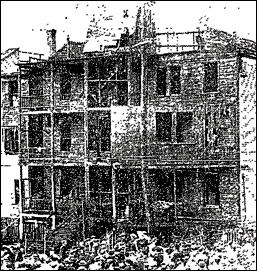 A fire that swept through the north section of the Forest Hills Hotel, at the junction of Hyde Park Ave. and Walkhill St., Forest Hills, yesterday afternoon, drove 400 guests in the building in a stampede to the street and did damage to the hotel and adjacent property estimated at between $16,000 and $18,000.
A fire that swept through the north section of the Forest Hills Hotel, at the junction of Hyde Park Ave. and Walkhill St., Forest Hills, yesterday afternoon, drove 400 guests in the building in a stampede to the street and did damage to the hotel and adjacent property estimated at between $16,000 and $18,000.
The heroes of the fire that swept through the wooden building with appalling swiftness were Ex-Senator Frank Seiberlich, proprietor of the hotel, his manager, Frank J. Jeager, and assistant manager Stephen Walsh who forced their way through the smoke-filled rooms and rescued Mrs. William F. O’Connor and her 4-year-old son William, Mrs. John O’Connor, all guests, and Mrs. Sarah Leach, Mrs. Mary Brady and Mrs. Josephine Benson, domestics. They were cared for at the residence of Patrick J. Rooney, 36 Hyde Park Ave.
The damage to the building, which is owned by Gabriel Gougeon, is estimated at $5,000; to contents and furnishings owned by Frank Seiberlich, $9,000; to Hotel Meyer, a three-story apartment house at 49 and 51 Hyde Park Ave., owned by William Miller, $1,200; to furnishings of Joseph Bornino in his apartment in Hotel Meyer, $300; to the building at 3770 Washington St., owned by William Miller and occupied as a saloon by John J.Walsh, $300.
Heavy Sunday Business
The hotel is a three-story wooden structure at 51 to 61 Hyde Park Ave., having a frontage of 158 feet on Hyde Park Ave. and a long frontage on Walkhill St. It is triangular in shape, and contains 35 rooms. The north portion, numbered 51, 53, 55 Hyde Park Ave., and running back to Walkhill St., was the part burned.
That section of the hotel contained a large wine-room in the basement, containing $6,000 worth of wines and liquors, and a rathskeller. On the first floor were the office and two large rooms: on the second floor a saloon and nine private dining rooms, with parlor and kitchen at the rear, and 12 chambers and bathrooms on the third floor.
Sunday is one of the busiest days at the hotel which caters to a very large out-of-town patronage. Yesterday the business was unusually heavy and at the time of the fire there were seated about the tables in the serving rooms about 400 guests.
These rooms were on the street floor and directly back of them is a large piazza that runs to above the second story. There is an exit from the hotel at the end of the piazza on the Walkhill St. side. It was under this piazza that the fire was first discovered by John Reilly, an employee, who gave the alarm. Mr. Seiberlich was behind the desk at the east end of the serving room, and manager Jeager and assistant manager Walsh were also in the office. All of them saw the smoke curling into the windows of the serving room and the 400 guests also saw the fire making rapid headway up the side of the rear of the hotel and getting a hold on the dry timber of the two-story piazza.
Saved in Nick of Time
Almost at once the flames were forcing their way through the windows into the building, driven by a strong west wind, and the guests tumbled over each other in their haste to escape.
Mr. Seiberlich quickly rang the hotel fire alarm, then telephoned Station 13 that the hotel was on fire; shut the cash register and closed the door of the safe, and with manager Jeager and assistant manager Walsh hurried through the hotel and rescued the women mentioned.
Mrs. William O’Connor was carried out of the building by Stephen Walsh and her little son William by Mr. Seiberlich. During this time the fire department of the hotel, composed of Otto Luskarg, William Reinhardt, Peter White and John Reilly, got out a line of hose and endeavored to check the flames.
Knowing that Mrs. Leach, Mrs. Benson and Mrs. Brady were at work in the kitchen in the second story, directly above the heart of the fire, Mr. Seiberlich and Stephen Walsh forced their way through the smothering smoke that now filled the building, up the narrow stairway to the second story, and brought out the three women in the nick of time. A few minutes later the room in which they had been was a mass of flames.
Second Alarm Ordered
Patrolman George Keyes of Division 13 was on Washington St. not far from the rear of the hotel when he saw a sheet of flame shoot almost across Walkhill St. He jumped upon a passing car and ordered the motorman to make all speed to Box 531, at the corner of Washington and Morton Streets.
Someone on Hyde Park Ave. called to a passing driver of a hack that the hotel was on fire and to rush to Box 592 before Patrolman Keyes sounded Box 531.
The fire made such rapid headway, fed by the hard wood of the hotel and fanned by a strong westerly breeze, that when District Chief Michael J. Mulligan got sight of the fire he ordered a second alarm before he left his wagon.
Engine 28 and Ladder 10 of Jamaica Plain was the first apparatus to arrive. Engine 45 and Ladder 16, Roslindale, followed closely. When the firemen reached the scene the flames were eating up the rear of the hotel on the Walkhill side and had a good hold on the roof and one side of the Hotel Meyer.
A four-foot alley separated the north wall of the Forest Hills Hotel and the Hotel Meyer. The wind was driving the flames against the latter and District Chief Mulligan knew that he must make his fight there. He placed men with a line of hose at that point and; although the heat was intense, they succeeded in holding the fire in check.
The building at 3770 Washington St. caught fire but the flames were quickly extinguished.
Fight Watched by 5,000
The second alarm brought additional apparatus from Roxbury, West Roxbury and Mattapan.
The fire, which was most spectacular, was witnessed by more than 5,000 people, who crowded Hyde Park Ave., Walkhill St and Washington St. A crowd of 2,000 men, women and children watched from the raised track-bed of the New York, New Haven and Hartford Railroad until driven from their dangerous position by police.
Ladders were thrown up on the Hyde Park Ave. front of the hotel, on the Hotel Meyer and against the rear walls of the Forest Hills Hotel. From there the firemen poured a deluge of water directly into the heart of the fire. The heat from the fire was almost unbearable. Senior Hoseman Wesley Newdick of Engine 42, Egleston Square, was overcome and was compelled to relinquish his task. He was replaced by Hoseman Griffin, Chemical 5, Egleston Square.
Ladderman Stephen A. Moran of Ladder 16, Roslindale, while taking down a line of hose on a ladder on the Walkhill side of the hotel, fell and injured his right leg. Hoseman Fall of Engine 28 was also slightly overcome.
After two hours the firemen won.
Carelessness Probably the Cause
Ex-Senator Seiberlich, proprietor of the hotel, was loud in his praise of the work of the firemen and told District Chief Mulligan that the men of the department would hear from him later. He also assured all the employees of his hotel, who had lost their belongings in the fire, that he would reimburse them.
Mr. Seiberlich carried an insurance of $10,000 on the contents of the hotel. Mr. Gougeon, owner of the building is also well insured and it is understood that Mr. Miller’s loss is also covered by insurance.
The south section of the hotel, with entrance at the junction of Hyde Park Ave. and Walkhill St., which contains the bar on the first floor and 20 chambers on the floors above, was but little damaged as Mr. Seiberlich closed the iron fire doors separating the two sections of the hotel.
It is expected that the hotel will be rebuilt at once.
A lighted match, carelessly dropped through a crack in the piazza, is believed to have started the fire.
Frank Norton's 1940s and 1950s Jamaica Plain
 My name is Frank Norton and I was born in Jamaica Plain on May 7, 1943.
By the time I came along my parents already had one son named Larry. He
was a year and two months older than I was. Unfortunately for Larry, I
came along to “rain on his parade.” Both Larry and I were born during
the years of World War II, so I can only guess what kind of a world we
were living in at that time. My brother Larry and I are shown in the photograph to the right in 1947.
My name is Frank Norton and I was born in Jamaica Plain on May 7, 1943.
By the time I came along my parents already had one son named Larry. He
was a year and two months older than I was. Unfortunately for Larry, I
came along to “rain on his parade.” Both Larry and I were born during
the years of World War II, so I can only guess what kind of a world we
were living in at that time. My brother Larry and I are shown in the photograph to the right in 1947.We lived on the second floor of a three decker at the corner of 51 Custer Street and Goldsmith Street. There was a corner grocery store right underneath us that was owned and operated by our landlords Harold and Laura Poppleton. As far as I can remember, the Poppletons didn’t have any children. Mr. Poppleton loved the Red Sox and golf. He had all of these small homemade boxes with holes in the middle of them and ramps leading up to them all over the back yard. This was his miniature golf course. He allowed Larry and me to play along with him when we were old enough to do so. Archie Scott lived on the third floor. The surrounding three deckers were home to the families King, Panos, Duffy, Bowes, Di’Ampolo, Sullivan, Cotter, Sevigny, Burdell, and McPartland to name a few.
Mrs. Poppleton worked at the store most of the time. She would sit behind the glass display case that held my favorite candy treats. Back then, candy really was a penny! She had this handheld device with a grip on the end of it to reach items that were too high on the shelves. In this particular corner store you could get everything from food products to kerosene for the kitchen stove. I can remember many a night my father going to “Poppy’s” for kerosene and coming back with those wax covered liquid treats that you would snap the neck at the top to get to the sweet liquid inside. We had a round washing machine with a clothes wringer. The clothes used to wring into the white porcelain sink. We had a “stack” which was similar to a hot water heater. The “stack” would be lit once a week for hot water for our Saturday night bath. You would feel the side of the stack to see if you had enough water heated. The kerosene can would be tipped upside down and put onto the holder located on the back of the stove.
In the late 1940’s, we used to entertain ourselves by listening to radio programs like The Green Hornet and The Great Gildersleeve, and being told by the radio announcer to “watch for The Cushman Bakery delivery truck that would be soon coming down our street”. Back then, very few people had television sets. I can remember when they did become available that they were small and had a round picture tube. I think the test pattern with the awful buzzing noise was the clearest thing you could really see. The Poppletons eventually bought a television set and used to let us come downstairs to watch cartoons and an occasional Red Sox game.
Almost everything that you needed to buy was delivered to the neighborhood. If you needed ice from Gordon Durning the iceman, you would put the cardboard sign in the window. It had different weight amounts on all four sides of the card. When he would collect, he would reach in his pocket and pull out all of this money to make change. If you needed milk, the milkman would deliver on a regular schedule. If you needed clothes or household goods, Sid from the Green Supply would take the order and deliver them to you. The way people paid for things back then was to leave the envelopes on the door with a few dollars inside of them for each vendor.
 The fruit and vegetable man would come
down the street with his horse and wagon. He would yell “‘Maters, three
pounds a quarter.” He had a scale attached to the back for weighing
your purchases. The same was true of the ragman. He had a similar
wagon with a scale, and would sing “rags, any rags today?” We were
always reminded when we went out into the street to watch out for the
horse droppings. The lamplighter would climb his small ladder and light
the gas lights early each evening and come back in the morning to put
out the light. We had mail delivered twice a day. Three men and a
truck that had an opening on the side of it picked up the rubbish.
There would be one guy inside the opening and the others throwing the
barrels to him. He would empty them and throw them back. There
was a separate truck for garbage. One man used to go around to the
backs of the houses and collect the swill from the round receptacles
that were in the ground and bring them out to the street where they
would be picked up by this awful-smelling truck similar to today’s
rubbish truck.
The fruit and vegetable man would come
down the street with his horse and wagon. He would yell “‘Maters, three
pounds a quarter.” He had a scale attached to the back for weighing
your purchases. The same was true of the ragman. He had a similar
wagon with a scale, and would sing “rags, any rags today?” We were
always reminded when we went out into the street to watch out for the
horse droppings. The lamplighter would climb his small ladder and light
the gas lights early each evening and come back in the morning to put
out the light. We had mail delivered twice a day. Three men and a
truck that had an opening on the side of it picked up the rubbish.
There would be one guy inside the opening and the others throwing the
barrels to him. He would empty them and throw them back. There
was a separate truck for garbage. One man used to go around to the
backs of the houses and collect the swill from the round receptacles
that were in the ground and bring them out to the street where they
would be picked up by this awful-smelling truck similar to today’s
rubbish truck.Doctors made house calls, and some of our locals were Dr. Sumner Karp and Dr. Melvin Gould. The dentist of choice was Dr. Sarris.
We had Jolly Cholly the ice cream man visit us nightly on Custer Street in the summertime. We could hear his bell ringing as he drove down the street. He would let a few of us go with him on his route around the Arborway and up to the rich section of Moss Hill. We took turns ringing the bell and riding on the running boards. We must have looked like a band of gypsies, but what did we care; we were young and having fun.
 In the very early 1950’s we got our first television set and started
watching television programs like Life of Riley, I Remember Mama, and
Tom Corbett Space Cadet. The heroes of the day were Pinky Lee, Big
Brother Bob Emery, Buffalo Bob, and especially Howdy Doody! The older
folks watched Queen for a Day, I Love Lucy, Our Miss Brooks, Arthur
Godfrey, and during serious times the McCarthy hearings. Senator
McCarthy would start each one of his inquiries with the question “Are
you now, or have you ever been, a member of the communist party?”
In the very early 1950’s we got our first television set and started
watching television programs like Life of Riley, I Remember Mama, and
Tom Corbett Space Cadet. The heroes of the day were Pinky Lee, Big
Brother Bob Emery, Buffalo Bob, and especially Howdy Doody! The older
folks watched Queen for a Day, I Love Lucy, Our Miss Brooks, Arthur
Godfrey, and during serious times the McCarthy hearings. Senator
McCarthy would start each one of his inquiries with the question “Are
you now, or have you ever been, a member of the communist party?”In the wintertime we used to go coasting at the sugar bowl which was located on the left-hand side of the Jamaica Way near Mayor Curley’s house. It was called the sugar bowl because it was shaped like a bowl. If you went down one side you’d go half way up the other side during coasting. Another great spot to coast was the Arnold Arboretum right near the Administration building. This was the closest for us to go to. All we had to do was to go to the end of Custer Street and cross over the two lanes of traffic at the Arborway and we were there. The Arnold Arboretum is 265 acres of beautiful trees and historic plantings. In the spring they host Lilac Sunday. The smells were delicious. Bussey hill was the highest point, and if you rode your bike down the winding spiral you would build up momentum with each turn. If you made the entire ride in one piece, you were considered a hero for at least ten minutes or so.
When my brother Larry and I were old enough to venture away from the neighborhood we would go up to Centre Street. That’s where all the great stores were. On our way we would pass Margie’s variety store which was on the corner of South Street and Carolina Ave. There was Doctor Bering’s office on South Street, The Jamaica Plain Library, Curtis Hall, The Monument, the drugstore on the corner of Eliot Street, The First National, Brigham’s, “Ask” Mr. Fowler Real Estate, Mullen’s bakery, Costello’s bar, Mammigon’s restaurant, Kresge’s, and Woolworth’s to name a few.
On the walk back we would go to my favorite toy store The Erco Shop. It was located near the First National and Brighams. Mr. Erco spoke with an accent. If you needed the latest model plane or ship to build, this was the place to come. We had to buy the airplane glue separately. They called it Dope.
Larry and I delivered grocery orders at the First National store on Centre Street using our Radio Flyer wagons. He delivered newspapers for the Jamaica Plain Citizen and walked Mrs. Barnes’ dog, a boxer, for extra spending money. As we got a little bit older Larry went to work part-time for Forester’s Market on Boylston Street near Lamartine Street. He delivered orders in an old delivery van with a driver named John. The owner of the market was Bill Judge.
 My first part-time job was at Hailer’s Rexall drugstore on the corner of
Seavern’s Ave. and Centre Street. Les Weiler was the owner/pharmacist.
Fran Shultz ran the lunch counter. The surrounding merchants were: Wayne’s Dept. Store, Hanlon’s Shoes, Jones’s Card Shop, Metropolitan
Furniture (formally the Mohegan Market), Kennedy’s Butter & Egg store,
Mike’s donuts, The Shawmut bank, Woolworth’s, Kresge’s, Capital Super
Market, Ralph’s fruit stand, Jamaica Flooring and Harvey’s Hardware,
just to name a few.
My first part-time job was at Hailer’s Rexall drugstore on the corner of
Seavern’s Ave. and Centre Street. Les Weiler was the owner/pharmacist.
Fran Shultz ran the lunch counter. The surrounding merchants were: Wayne’s Dept. Store, Hanlon’s Shoes, Jones’s Card Shop, Metropolitan
Furniture (formally the Mohegan Market), Kennedy’s Butter & Egg store,
Mike’s donuts, The Shawmut bank, Woolworth’s, Kresge’s, Capital Super
Market, Ralph’s fruit stand, Jamaica Flooring and Harvey’s Hardware,
just to name a few.There was the fire station across the street and police station #13 on Seaverns Ave. One of the police officers that worked out of that station loved to sing. His name was Bill Dolan, and he and another police officer were on Community Auditions, the local talent program on Sunday morning television. They won the contest and went on to the Ted Mack Amateur Hour. I don’t believe they won that contest, but they were great!
There was a woman named Mrs. Nixon who lived in the brick apartment block directly in back of Hailer’s Drug Store. Her son was a movie producer or director and was married to the movie star Marie McDonald from the My Friend Irma television show.
My family moved out of 51 Custer Street when I was about twelve years old. The family had grown to four children. Tommy and Joe came along in 1950 and 1951. It was starting to get a little crowded in two bedrooms, and the Poppletons were getting ready to sell the house and store and move to California. Up until that point my brother Larry and I went to school at Saint Thomas Aquinas on Saint Joseph Street. Farrell’s Drug store was on the corner of Saint Joseph and South Street. Further down the street (where the projects are now) used to be the MTA car barns. They were across the street from Bob’s Spa, with Saint Rose Street to the left.
When I was a young kid, you rode in the old fashioned streetcars like you see at the Trolley museum in Maine. I forget how much the fare was, but you could go from the streetcar to a bus, to a train, to a trackless trolley all for one fair by getting a “transfer” slip of paper. Our parents used to tell us to “Don’t forget your transfer.”
 Forest Hills housed the train station overhead and the trolleys and
buses down below. From the Forest Hills station you could go left to
Hyde Park or right to Roslindale. If you went up Washington Street
towards Green Street, you would pass Ernie’s Diner, the Forest Hills
Outlet Store, the Boston Gas Company, Timmons Liquor Store, and Jo-Ann’s
coffee shop which was right beside Ruggierio’s Market. If you went down
Green Street heading towards Centre Street you would pass Kilgariff’s
restaurant. Further down the street was the Green Elm coffee shop owned
by Mike Kalijian. If you took a left on Elm Street you would come to
Jamaica Plain High School. If you continued on Green Street you would
see the K of C Hall that was once called the Jamaica Club years before.
When my brother and I were young, my father would take us to the
minstrel shows that they would have there. The K of C also used to have
Christmas parties with Santa handing out presents and small boxes of
hard candy.
Forest Hills housed the train station overhead and the trolleys and
buses down below. From the Forest Hills station you could go left to
Hyde Park or right to Roslindale. If you went up Washington Street
towards Green Street, you would pass Ernie’s Diner, the Forest Hills
Outlet Store, the Boston Gas Company, Timmons Liquor Store, and Jo-Ann’s
coffee shop which was right beside Ruggierio’s Market. If you went down
Green Street heading towards Centre Street you would pass Kilgariff’s
restaurant. Further down the street was the Green Elm coffee shop owned
by Mike Kalijian. If you took a left on Elm Street you would come to
Jamaica Plain High School. If you continued on Green Street you would
see the K of C Hall that was once called the Jamaica Club years before.
When my brother and I were young, my father would take us to the
minstrel shows that they would have there. The K of C also used to have
Christmas parties with Santa handing out presents and small boxes of
hard candy.When we moved, we went to 14 Haverford Street that ran between Cornwall Street and Montebello Road off of Washington Street. My parents bought a three decker and our back yard abutted the convent that belonged to Our Lady of Lourdes parish and housed the Saint Joseph nuns. We were one block in back of the overhead train tracks and when we first moved in; I thought I would never sleep again. The trains went by about every 10 minutes or so during rush hour and it was quite noisy.
After a few days we adjusted to the sounds and started fitting into our new surroundings. Mrs. Gallagher lived on the second floor of the house. She was very Irish and she and her husband had a beautiful, well kept apartment. They had a gorgeous black cast iron stove in the kitchen. This heated that section of their apartment. Mrs. O’Connor lived on the third floor. I attended Our Lady of Lourdes Parochial school for the sixth through eighth grades. The Principal was Sister Joanita, and she was tough as nails. The story was that she came from a school for deaf students, and was a real disciplinarian. I got suspended for a day because I had a duck tail haircut. I had to bring my mother to the school. My mother was a scrapper, so it was an interesting war of words between the two of them. My brother Larry continued at Saint Thomas Aquinas parish. The nuns were tough, but overall the education we got was good. I graduated from Our Lady of Lourdes in 1958.
The Haffenreffer brewery was down off of Amory Street and each day around noontime you could smell the hops being brewed. The apartment we had was heated by coal, so it was interesting to see the truck deliver the coal down the chute and into the coal room located in the cellar. The furnace would be stoked daily, and the ashes would be used on the snow to give us traction.
We found our way around the neighborhood rather quickly. Up at the corner of Washington Street and Montebello Road was Buddy’s Spa on one side and Madden’s drugstore on the other. If you wanted a chocolate or vanilla coke, Madden’s drugstore was the place to go. If you wanted a 25-cent Italian sub pre-wrapped on the counter, and a bottle of cream soda, Buddy’s was the place to come to. Buddy let all of the parents in the neighborhood run a tab. He would give you a small spiral notebook and kept track of your purchases until week’s end when it was time to settle up. We had the Boylston CafÈ on Washington Street. They had the best barroom pizzas, and if you wanted to play a number with the bookies, you just had to go to the end of the bar and see the man. The Boylston bowling alley and pool hall were right next door to the Boylston CafÈ. Tommy Smith was the manager of the bowling alley. Dottie’s Donut was on the next corner. Across the street from there was DW Dunn Mayflower storage. The JA Club (actually a barroom) was beside that. We had Jerry the barber who charged 50 cents for a haircut and gave you back 25 cents so you could go and get a treat. There was the Chinese laundry beside Madden’s drug store. Across the street from that was Waterman’s block. There was a grocery store on the street level. It was on the corner of Forest Hills Street.
At the time the most memorable movie on television was the Fighting Sullivans. Television was really progressing at that time, and some of the shows were Sid Caesar and Imogene Coca, Red Skelton, Jackie Gleason, Uncle Milton Berle, and Ed Sullivan just to name a few.
If you came down Montebello Road off of Washington Street the brick apartment building on the left belonged to the Walsh family. All of the sons were tradespeople so they built their parents a ranch house in the back yard of the apartment building. It looked strange when they were building it, and I’m sure if you rode by there today, it would look just as out of place.
When my brother Larry and I were old enough to go for our driver’s license we went up to Station #13 on Seaverns Ave. for the “dreaded” road test. Larry got his license right away; I failed the first time. I hit a curb while turning around on Gordon Street. The second time around I got mine too. Larry’s first car was a primed but unpainted 1949 Ford. My first car was a 1949 Plymouth. We went through cars every other year it seemed. It was in this neighborhood that we were introduced to the “I shoveled this spot out when it snowed, and put my chair or barrel in its place when I had to leave” unwritten law of Haverford Street. Smaller versions of World War III were argued over who took a parking spot after a snowstorm. God forbid a stranger came into the neighborhood; everyone would gang up on whoever the offender was.
As my brother Larry and I got older we both started branching out further and further away from the house and the friends that we had gotten to know from the neighborhood. By that time we were both out of school for good. Larry had graduated in 1959 from Jamaica Plain High School. If you happen to see that particular yearbook, he’s on page two. He was involved with some of the writing of the yearbook and the opening pages.
I went to Jamaica Plain High School in 1959 and had to repeat the year because I wasn’t able to go to the required 13 weeks of Agriculture School in the summer of that year. I went to the Mary Curley School the following year. I found public school quite different than Parochial school. The structure wasn’t the same and I became a horrible student. It was my own doing, so in order to take on a full time job at Radio Shack on Commonwealth Avenue in Brighton, I quit day school and spent 2 years going nights at Roslindale Evening High. A few years later I became a milkman for H.P. Hood & Sons on Anson Street that was off of South Street. We used to garage our stand-up Divco milk trucks across from Anson Street in a brick garage. Driving the Divco was a challenge. The clutch and the brake were on the same pedal, so it you stepped down too hard you would be thrust forward towards the windshield. Being a milkman, and working for Hoods Milk was not only a great job at the time, it was a lot of fun.
My brother Larry moved out of Jamaica Plain in 1961 and got married. I moved out of Jamaica Plain in 1965 and got married. Unfortunately we both ended up being divorce statistics years later.
When we went back to visit our parents it wasn’t the same anymore. You could notice the differences taking place and the decline of the neighborhood. When my parents sold the 3 decker in the 1970’s, you couldn’t give them away for $13,000. The insurance companies were redlining the neighborhoods and not selling fire insurance. My parents bought a house in Weymouth and lived there until they passed away. My mother died in 1978 and my father died in 1985. My beloved brother Larry died April 25, 2002, at the age of sixty. He had a 35-year career with a great company named Roche Brothers Supermarkets. He was in management. He was my hero, and I miss him terribly. As for me, I just wanted to write our story.
Frank Norton
Hanson, Massachusetts
Hailer’s Drug Store
Hailer’s Drug Store, one of the oldest retail landmarks in Jamaica Plain, shut its doors for the last time Monday. The unexpected closing caught customers by surprise as owner Steve Grossman broke the news to his many friends who have considered the pharmacy an indispensible anchor to both the past and present.
“This is the end of an era,” said a shocked Penny Pimentel, who works across the street at the Arts Center. “An important part of Centre Street’s personality has just been dissected out of Jamaica Plain. The breadth of supplies this store carries and the friendship of Steve and his staff will be sorely missed.”
Grossman explained he was not able to let people know before Monday what was happening because he was privately negotiating with CVS to buy out his customer list. The chain will take care of anyone who has been dealing with Hailer’s, and the phone number will also be transferred to CVS.
He said a combination of factors led to his decision to call it quits. “We have seen the handwriting on the wall for a long time, but the final nail in the coffin has been the exclusive contracts between health groups and big [pharmacy] chains - along with mail order prescriptions,” Grossman lamented. “We were, in effect, locked out of the system and just could not compete.”
Grossman said Hailer’s was the last independent pharmacy in Jamaica Plain. “My wholesaler told me he has seen over 60 independents close in recent years, and unfortunately, this seems to be a trend across the country.”
For independent owners like Grossman, the only alternative now is to lock the doors and say good-bye. “When my father, Saul, took over the business in 1948 (then called Arborway Pharmacy) there were prescription files that went back to 1831,” Grossman said. “In 1966 we moved from the corner of South and Rosemary, to Brighton - and then in 1970, back to Jamaica Plain. After dad passed away in 1985, I became the sole owner.
“This store has been like a living, breathing member of our family. But recently it has been like watching a loved one on life support. I guess I feel both relief and grief that it’s finally over. My lawyer says the store turned from a business, to a hobby, to a charity. I guess he’s right. And today is our wake.”
As Grossman broke the bad news to customers and friends, John Donovan - the former owner of Roger’s pharmacy - helped out filling prescriptions in the back of the store. Donovan, who said he spent 42 years in the business, gave it up in 1978 after enduring one too many robberies. Alongside Donovan, another former owner, Frank Hojlo - who gave up Smith’s Pharmacy for the same reason, exactly four years to the day before Hailer’s closing - stood by his two long-time friends. Together the three men represented over 137 years of neighborhood service.
“You know, we used to have 18 independent pharmacies between Jackson Square and Forest Hills,” Hojlo said. “Hailer’s was the last of the Mohicans. It’s a real shame. We have lost the personal contact of the local pharmacy that knew your family, cashed your check and delivered prescriptions in the middle of the night to folks who couldn’t get out of bed.”
Those days may be gone forever, but Steve Grossman’s customers and friends insist that kind of service will not be forgotten.
“Coming here is a personal thing,” said Paul Peccia, a customer of more than 35 years. “Small stores like this are much friendlier. You always knew you could call Steve up in an emergency. I’m really sad to see him go.”
When hearing the news, Anna Shea reminisced about the days she brought her daughter to the store in her baby carriage. Now she has her own family in Wrentham. And guess what? She still comes to Hailer’s because she likes Steve so much.
“It’s like home here,” she said. “You could come in, sit down, and meet your neighbors. I just feel terrible. Steve went out of his way for people. I wish him the best of luck.”
Leroy Balbanis, whose family used the store since its days at South and Rosemary, said he felt like he suddenly lost a good friend. “I’m going to miss everyone who worked here. This is really sad. I remember Steve’s father. A good man. The whole family was the salt of the earth.”
“Saul’s family are regular, good neighborhood people,” agreed John LeClair, who also remembers the South Street store. “It’s a big loss to the community. I’m going to miss Steve, Edna and Loraine. And coming here to shoot the breeze. You can’t do that at CVS.”
As LeClair stood up, he looked around the store for one last time. “I wish Steve and his new bride the best,” he said.
Grossman, who was married four months ago, said he has no plans as yet, and only wants to “cool out” for a while. “We are going to visit Jennifer’s family and relax,” Grossman said. His wife is a professor at the Massachusetts College of Pharmacy.
“This is a very emotional time for me,” he continued after taking a deep breath. “All the friendship and gratitude. And the mosaic of memories from so many years, it’s all around here.”
As for the future of the space occupied by Hailer’s since 1970, Jamaica Plain Business and Professional Association president Bob Shortsleeve said he hopes the next store fills the community’s needs, and not just duplicates existing businesses to pay the rent.
“I feel bad losing someone like Steve, whose family has invested so much in the neighborhood,” said Shortsleeve. “These are the kind of people who support the little leagues, the Arts Center, and other local initiatives. I hope the new owner has the same commitment.”
One suggestion Shortsleeve said he could support is a bookstore. “Steve’s variety of books and international magazines was always welcomed. I don’t know if the space is large enough, but it would be nice if it happens.”
Saying the Business Association should be a catalyst, not a control, Shortsleeve disclosed his group “will definitely communicate with the building’s owner concerning the tenant selection.”
But for residents like Fareedah Nu-Man, the thought of another store at the corner of Centre and Seaverns is too painful to consider at the moment. With tears running down her cheeks after she found out the pharmacy was closing, Nu-Man declared, “Nothing will take the place of Hailer’s. And no one can replace Steve. This really hurts.”
Originally published in the December 3, 1993 issue of the Jamaica Plain Gazette. Copyright © Jamaica Plain Gazette. All Rights Reserved. Used with permission. Production assistance provided by Monica Salas.
Hi-Lo: For Latinos, More Than A Grocery
by Paysha Stockton
Ripe guineos verde green bananas Dominican olive oil, dulce de leche
candy, Embajador chocolate, and Yaucono coffee, shrink-wrapped for
freshness.
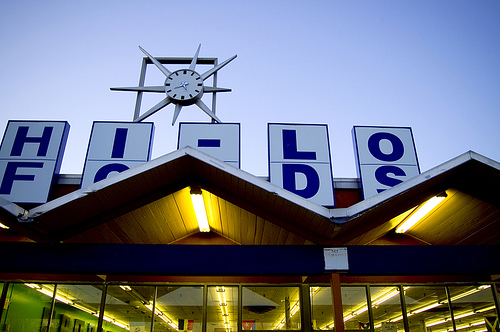
Photograph courtesy of David Salafia
Shoppers who push through the swinging metal doors of Hi-Lo Foods are
on a mission: to fill their carts with foods like these that they
often can’t find anywhere else.
“They have everything I want,” said Damaris Pimentel, 31, who treks
monthly from Charlestown to the Centre Street market some call the
center of Boston’s Caribbean community. “Sometimes I go to other
places and it takes me forever.”
Forty years ago, the Hi-Lo was your average white-bread chain Sklars
Market, and it served mostly Eastern European and Irish neighbors.
Store manager Bill Jordan, 62, of Jamaica Plain, who’s worked at the
store since it was built, has seen it change ownership and names
several times; John Knapp Jr., who’s owned it for 33 years, named it
Hi-Lo about 25 years ago.
But as Spanish-speaking newcomers arrived and the ethnic makeup of the
neighborhood changed, the store’s flavor changed along with it, said
Jordan.
Today, the Hi-Lo’s crowded aisles are stacked with hard-to-find
cookies, produce, sodas, meats, and spices from all over the Caribbean
and Latin and South America. Reflecting its Latin flavor on the
exterior, a crew of young painters was busy last week painting a
massive, Caribbean-inspired mural in colors that echo the fruits and
spices inside.
But more than a place to stock up on food, the Hi-Lo is a social
center for the local Latino community, where customers run into
friends and family and can immerse in their language and culture.
“You don’t see your friends for 10 years you come here, you see them,”
said Sergio Vega, a store security guard.
Pimentel, who came here from the Dominican Republic, said she loves
finding staples such as yucca up front. “I like shopping here,” said
Pimentel, plump aloe leaves poking out of her overloaded cart. “It
makes me more comfortable. Mostly everybody speaks Spanish.”
Jordan said he doesn’t advertise: He has word-of-mouth power.
“High value, low prices,” Jordan said. “They can come in and feel
comfortable. They can speak their own language and they can buy all
the products from their particular country. It’s a winning
combination.”
Hi-Lo is not about chi-chi foods prettily packaged for adventurous
Anglo cooks, foodies who frequent exotic co-ops and drool over “The
Naked Chef.” Nothing is chic or color-coordinated here. The foods are
staples for people far from home, people who bargain shop and call
friends about sales. But the shoppers are also a diverse bunch: They
could roll up in a shiny SUV or on a city bus.
Some neighbors have suggested Hi-Lo go for the specialty niche, said
Valerie Grabiel, former director of the Hyde/Jackson Square Main
Street group, who is working with the grocery to spruce up its
storefront and helped it get a city grant.
“I’ve had people come to me and say `What can we do with the Hi-Lo?
They could be the Bread and Circus of ethnic food!’ ” Grabiel said,
laughing.
But those people don’t get it, said Aileen Duggan, Main Street’s new
director. “Hi-Lo sells what anybody else would call specialty foods,
but they’re selling them as staples. It is a regular supermarket to
all the people who shop there.”
Hi-Lo is an insider’s take on Caribbean cuisine and culture. Everyone
is welcome its 40 employees are happy to advise on how to boil yucca,
blend frozen mango pulp, or cook with Sofritos but the store isn’t
geared for the masses. Its shelves cater to the tastes of Cubans,
Dominicans, Puerto Ricans, Haitians, Jamaicans, Ecuadorians,
Colombians, Mexicans, and other Spanish speakers.
The evolution from a mainstream to Latin market was gradual, Jordan
said. Immigrant customers wanted foods he didn’t stock. Faced with
JP’s shifting demographics in the 1970s, he had a choice: change and
prosper, or stand still and possibly die.
So Jordan, whose wife is Puerto Rican, took a Spanish immersion class
and started chasing down requests. Soon, Goya beans and Bustelo coffee
filled the shelves, goat meat and pigs ears appeared in the coolers,
and plantains were prominent on the produce table.
“You gotta go with it,” Jordan said. “If you want to do something and
be successful, you have to go at it 100 percent.”
Duggan said Jordan’s success comes from understanding his customers’
needs and striving to meet them. “That’s real neighborhood customer
service.”
Jordan, who can tick off products and explain which are favorites in
which countries, said transforming the Hi-Lo into a Latin food mecca
has paid off, and customers come from as far as Maine and Cape Cod to
stock up.
“When you live in a country and you go the supermarket, you take it
for granted. You know what to expect,” Jordan said. But that basic
comfort often eludes immigrants. Ricardo Austrich, president of the city’s Latin American Grocers
Association, said the store also gives customers glimpses into each
other’s cuisines.
“You get a sense of an interchange of ideas and a different way of
eating,” he said. “You pass the word when you can find things you
can’t find in other places.”
The outside of the store reflects its spirit. The back is covered with
a huge mural by the Puerto Rican artist Rafael Rivera Garcia. Painted
in 1984 and renovated last summer by the city’s youth Mural Crew, it
depicts three mythical figures of the Taino people, the Indians who
were essentially wiped out by the mid-1500s after the arrival of
Spanish settlers.
The Garcia mural, which grew out of Boston’s relationship with Dorado,
Puerto Rico, affirmed JP and Hi-Lo as the heart of Boston’s Latino
community, Grabiel said. “This was the place they chose.”
The new Mural Crew masterpiece’s wild-colored banana leaves and
tropical birds now cover the store’s faded front. Jordan hopes the new
look makes his customers feel even more at home.
“It will give it more identity,” he said. “The feeling that this is
their market, it means a lot. It’s not like any other supermarket.
It’s not like you’re going to see Del Monte peas” here.
Copyright © 2004 Globe Newspaper Company. Reprinted with permission.
Holtzer-Cabot Electric Company
 In 1970, when the Boston Housing Authority converted the factory
building at 125 Amory Street for senior citizen housing, it marked the
end of the long history of one more manufacturing concern in Jamaica
Plain. The building is now known as the Amory Street Apartments, but
for fifty-five years it was the home of the Holtzer-Cabot Electric
Company.
In 1970, when the Boston Housing Authority converted the factory
building at 125 Amory Street for senior citizen housing, it marked the
end of the long history of one more manufacturing concern in Jamaica
Plain. The building is now known as the Amory Street Apartments, but
for fifty-five years it was the home of the Holtzer-Cabot Electric
Company. Industrial concerns are sometimes mysterious to their surrounding neighborhood. They usually do not sell any goods in the local area and display no products behind glass windows. But Holtzer-Cabot was a very well known company in its field, especially during its early years. It was an innovative company that produced both electrical communications devices and electric motors.
The Signal Department made communication apparatus such as fire alarm systems, watchman clocks, and telephones. The Motor Department produced speed reducers and small motors, usually less than one horsepower, for special uses. Electric coffee mills, envelope openers, and oil burners often used Holtzer-Cabot electric motors. This expertise in small motors, transformers and communication equipment evolved from the founding of the company.
Holtzer-Cabot Electric Company was started in 1875 in Brookline as the Holtzer Co. Charles W. Holtzer began the company to make simple electrical devices like doorbells, burglar alarms and electrical lighters for illuminating gas. By 1880, he was also operating the first telephone exchange outside Boston with one toll line to Boston and fourteen local subscribers. Since the telephone had been invented only in 1876, we can appreciate how progressive this commercial enterprise must have been.
Between 1880 and 1888, the firm was known as Seth W. Fuller & Holtzer, and then Fuller, Holtzer & Company when George E. Cabot joined the business. In 1889, Mr. Fuller left the company and the enterprise became Holtzer & Cabot and formally incorporated as Holtzer-Cabot Electric Company.
In 1891, the company built an electric carriage able to carry two people for Fiske Warren of Boston. This was one of the early automobiles in America, and a very early electric car. At this time, inventors were using steam, electricity or internal combustion to power the horseless carriages. This car was initially built for four passengers, but additional power was needed and more batteries were added in the back seat.
Although William Morrison in Des Moines, Philip W. Pratt of Boston, and John A. Barrett in Philadelphia had built earlier electric autos, this “Holtzer-Cabot” has been called the first successful electric vehicle built in the USA. It was one of the first to feature a steering wheel as it is used now; and it was manufactured as a commercial venture for a client, not as a demonstration vehicle for an inventor.
Mr. Warren scared everyone when he drove the car on the roads around his country house in Waltham, but it must have been successful because he ordered anther one built by Holtzer-Cabot in 1893. This one seated eight people, weighed 5100 pounds and could attain the speed of sixteen miles per hour. It seems to be the last electric car the company made.
The Company greatly expanded its telephone work from 1890 to 1915 and achieved success with the useful invention of noiseless generators for central telephone exchanges and other innovations. By World War I, their telephone apparatus was in telephone systems around the world and aboard ships and submarines of the US Navy. In 1912, a special Holtzer-Cabot generator allowed the first radio communication between an airplane and land. Mr. Holtzer, the founder and Chairman of the Board guided the creativity and expertise for these advances.
Charles William Holtzer had been born in Karlsruhe, Germany in 1848. He came to New York at eighteen years old, and six months later was working at E.S.Ritchie & Sons, Brookline. He started the electrical firm of Holtzer & Newell in 1874, then proceeded on his own in 1875 in a small building in Harvard Square, Brookline. The company expanded quickly, moving to Boylston Street in 1880 and then buying property on Station Street opposite the railroad station in 1885.
This building (still standing) was remodeled, added to, expanded, and rebuilt until 1915, when Holtzer-Cabot’s new building was ready at 125 Amory Street, Jamaica Plain. He had chosen the area for its excellent transportation lines along Columbus Avenue, Washington Street, and the New Haven Railroad (now the Southwest Corridor). The area had abundant skilled help, and was in the heart of the Jamaica Plain German community.
The plant was six stories high, had 150,000 square feet of floor space and had room for expansion of four acres. Here Mr. Holtzer indulged in the benevolent management of his employees, with a Mutual Benefit Association, Savings Club, Shop and Management Committees and numerous extra-curricular activities. Sports teams of all sorts were well known in the city, and the daily band concerts at the Holtzer-Cabot bandstand every noon are still fondly remembered.
Mr. Holtzer died in 1927, and the company expanded during World War II. After ninety-seven years, the company closed. Its remaining lines were sold to Eastern Air Products in Dover, New Hampshire, which still carries the Holtzer-Cabot trademarks. The Boston Housing Authority bought the land and building for its renovation and reuse as housing. The building remains in our neighborhood, but nothing of the Holtzer-Cabot Electric Company has survived here - excepting perhaps its spirit.
Sources: Holtzer-Cabot Electric Co., Fifty Years 1875-1925, Boston, 1925; Automobile Quarterly, The American Car since 1775, New York, 1971; The Brookline Chronicle, April 7, 1925; Boston City Directory, 1905-1976. Photograph of battery powered car, early 1900’s with Mrs. Charles C. Gates and friend, similar to electric vehicles produced by Holtzer-Cabot Electric Company. Photograph by Harry M. Rhoads courtesy of Western History/Genealogy Department, Denver Public Library.
Copyright © 1995-2003 Michael Reiskind
How Jamaica Plain Activists Created the Southwest Corridor
No wonder Jamaica Plain residents speak and act as though they can have some control of what happens in the neighborhood. Starting 49 years ago, local people along the Southwest Corridor banded together to stop a highway from splitting the neighborhood. Then they persuaded government to move the elevated Orange Line from over Washington Street and put it in the corridor with other positive additions.
In 1986, JP resident Edwina Cloherty, who grew up on Washington Street in JP, told me about her and the community’s experience.
Summer 1964: “It was very hot that night. I was a first year teacher, and I had a friend who worked for the Boston Redevelopment Authority (BRA)…” At the crowded meeting at what was the Neighborhood House on Amory Street, the BRA said that I-95 was coming through and “it would clean up a decaying area of Jamaica Plain.”
Winter 1967: Several organizations held a meeting and presented a report saying the elevated highway would “really muck up the neighborhood.” But officials said there was “nothing anyone could do.”
Early 1968: Cloherty and others formed the Jamaica Plain Expressway Committee. A City Council hearing at the Curley School drew 400 people, most opposed. Officials said something might be done.
Summer 1968: Community people advocated depressing the highway. Mayor Kevin White commissioned a BRA evaluation that said an elevated highway “would have a significant negative impact on the neighborhood visually and economically.”
Gov. Francis Sargent’s office reported receiving 2,000 postcards favoring depressing the highway.
February 1969: At a national conference for people impacted by mass highway plans where air pollution issues were presented, Cloherty said that her community could not stop the highway from coming through. “Well, I was so embarrassed,” she said later. “The others responded that they had stopped highway projects in their neighborhoods, and we certainly could, too.”
When she got back to JP, the Jamaica Plain Transportation Committee took a vote, and “No highway” won.
1967: Sargent put a moratorium on highway construction in the state. JP and Roxbury activists requested a study showing a different transit corridor instead of a highway.
In 1972: Sargent declared that 128 could replace I-95. But houses and businesses along the Southwest Corridor had already been torn down.
1974: A proposal for depressed rail and a four-lane street was made for the corridor. Activists started wearing buttons, “Stop i-95” with a lower case I.
July, 1976: Cloherty cancelled her vacation to attend a packed meeting at the State Labs in Forest Hills. She and others then met with officials from the Kevin White administration to describe how much people did not want any highway in the corridor. The highway was never mentioned again, she said.
The community and government worked together for the next decade to plan for and build the new Orange Line, parks, businesses and housing.
“As a community we have more power than we usually think,” Cloherty reflected later. “What we have to remember is that responsibility comes with the power. We are the people we have to hold accountable.”
Copyright © 2013 by Sandra Storey. All Rights Reserved. Reprinted with the permission of the author and the Jamaica Plain Gazette.
Origianlly appeared at: http://jamaicaplaingazette.com/2013/08/30/jp-observer-how-jp-activists-created-the-southwest-corridor/Jamaica Plain Crime Report for May 1, 1900
James Dwyer, 21 years old, living with his parents at 6 Carlow St., Roxbury, was arrested yesterday afternoon by the police of the Jamaica Plain station after an exciting and highly amusing chase, in which a patrol wagon with several officers, a sergeant and near a dozen more officers, a doctor in his buggy and hundreds of citizens figured.
Jamaica Plain has not seen such excitement in years and but for the serious side of the affair it would have eclipsed the Fourth of July celebrations held in this vicinity.
It all happened about noon. Patrolman Riley was standing with a young man, whom he had just placed under arrest as a suspect, at a patrol box on Washington St., near Green. He had rung for the wagon and was standing there talking to his man, when two young men walked down the street and passed him. As they did so he noticed that neither made any attempt to stop, and it was plainly evident that both purposely avoided looking at him or the man he was holding. This aroused a suspicion in his mind. Every officer in the Jamaica Plain district has been on the lookout recently for unknown men who might be suspected of wrong-doing. The district has been invaded of late with a gang, and as a result there is a sort of terror among the residents. Breaks have been so numerous that the police officials have become tired of entering on their books the complaints.
It appears that one house was broken into by breaking a pane of glass and forcing the catch. When discovered it was found that the window and woodwork were covered with blood, and it is presumed that the man who had committed the break had cut himself in the attempt.
This was a slight clue, but the police took it up and tried to carry it to its end. They have been on the close watch for any man who had a cut hand or wrist.
Patrolman Riley proved yesterday that he had remembered the instructions of his superiors. As the two men passed him he noticed that one made a poor attempt to conceal from view his wrist by pulling it up into his coat sleeve. This proved the man’s downfall and but for this slight movement on his part, he might now be enjoying freedom instead of occupying a cell at Station 9.
The men had not gone far when the patrol wagon drew up to the box. One of the officers jumped off but before he had time to take Riley’s prisoner, Riley ordered the driver of the patrol to hustle down the street and get the two men who had passed. "They are the men I want," yelled Riley. "Never mind this man, but be sure you get them."
A Sensational Chase
The driver put the whip to the horse and drove at a mad pace down the street. But the two men were not unaware of the proceeding and quick as a flash they separated. This was a tough problem for the men in the patrol wagon, and while some jumped out to chase one of the men the driver continued after the other.
Just at this point the fun began, and it proved as exciting a cross-town run as the Marathon race, but was its superior in point of spectacular features. Seeing the chase, a well-known Jamaica Plain physician, whose house has been broken into, tried to outdo the patrol wagon and whipped up his horse and started after one of the men.
Station 13 is but a short distance from the scene of the affair, and it so happened that the patrolmen were just after receiving their pay and a number of them were coming out of the house. The clanging of the gong on the patrol wagon attracted their attention, and upon looking they saw the cause of the excitement.
Not to be outdone several of them joined the chase, headed by Sargt. McCausland. They continued the run through yards and fields and with each hundred yards the chase was continued the crowd of followers increased. The two fleeing men passed near the works of the Sturtevant Blower Company just as the employees were leaving for dinner, and without knowing why they did it several of them also joined in the hunt.
But there is a limit to all things and the limit was reached at Stony Brook. The fleeing men reached the edge of the brook, and at this point one of them stopped and was placed under arrest. The other, however, did not scare at the sight of water and boldly jumped in.
The swimmer was pretty well exhausted and at the other side of the brook was completely used up and an officer who had made a circuit of the brook ran up and grabbed him. He was taken to Station 13 in the patrol wagon with the other prisoner. The latter was later released as there was no charge on which to hold him. But Dwyer was locked up on the charge of breaking and entering and later turned over to patrolmen Lynch and Rooney of Division 9, Roxbury.
The break for which Dwyer was arrested was committed about 1:30 yesterday morning in the liquor store of Henry Nolte, 2056 Washington St., Roxbury. At least three men were concerned in the affair and two are now under arrest. Dwyer and Joseph H. McCourt, who was taken in the store at the time of the break by patrolman Lynch.
Yesterday morning Lynch turned into Washington St. from Nawn St. and as he looked up Washington St. saw a man disappear around the corner of Eustis St., but a short distance away. He started after him and as he passed the store of Mr. Nolte, saw a man on the inside. He stopped and tried the front door, which was securely locked. He then went around to the side door and this was also found to be fastened. Then patrolman Lynch passed around to the rear of the building and saw that a window was open. He climbed in and made for the form he had seen behind the counter.
There was a grapple, in which the officer won out. He floored his man and was just placing the twisters on his wrist, when he heard a crash and quick as a flash he saw a man dive headlong through the large plate glass window in the front of the store.
Lynch fired two shots, but neither took effect and the man ran through Sterling St. toward Shawmut Ave. and was lost to view. The sound of the shots attracted the attention of patrolman Rooney and he came to the assistance of his brother officer and then went looking for the man who had escaped. The jump through the window was a daring one, the man carrying away with him nearly the entire pane of glass.
The man who was caught by Lynch was sent to Station 9, where he gave the name of Joseph H. McCourt. Examination proved that the men had tapped the till and taken $4.99, leaving one cent.
McCourt appeared in the Roxbury District Court yesterday morning and pleaded not guilty to a charge of breaking and entering. He was placed under $1000 bonds for trial Saturday. Dwyer will be arraigned this morning. He denies that he was implicated in the affair. His hands and wrists are cut and his shirt is spattered with blood.
The police claim that both men have prison records. McCourt, it is said, was released from prison March 30, and Dwyer is said to be out of Concord Reformatory but little more than a month.
A Lively Time in Roslindale
There was an exciting chase after two housebreakers in Roslindale yesterday afternoon. One had entered the house of William L. Lovejoy, 40 Ashland St., but was frightened away before he had secured any property.
Fred G. Child, who resides in the neighborhood, saw two men prowling about the premises. Presently the smaller of the two climbed a trellis, and opened a window on the first floor of the house and entered the building.
Then Child started across the street toward the larger man, who was keeping watch. Upon seeing Child he whistled to his companion, who immediately made his exit from the house by opening the front door, and both men ran toward Washington St.
Child hurried to the Station, at the corner of Washington and Ashland Sts., and notified officer Chadwick, and both started in pursuit of the fleeing men. One of the latter continued running down Washington St. toward Forest Hills, while the other went across the meadowland toward Mt. Hope.
Officer Chadwick called upon two bicyclists, Charles Lannon and Charles Tibbets, to pursue the man who was running down Washington St. while he started on a cross-country run after the other. Chadwick tried hard to overtake his man, but was unsuccessful, losing sight of him after he reached Florence St.
The bicyclists obeyed the officer’s orders and started after the man fleeing down Washington St. When the latter saw that Lannon was overtaking him he left the street and ran across the fields on the east side of Washington St. Lannon kept on to Forest Hills and notified officer Schlehuber, and both started back toward Roslindale.
When Lannon rode away the housebreaker returned to the street and got onto a wagon that was passing and lay down in it. His action was observed by Tibbets, who was wheeling leisurely along, and when he saw his friend Lannon and Schlehuber approaching he increased his speed, shot ahead of the wagon and informed the officer that his man was in it. The burglar discovered the officer some distance ahead of the wagon, and jumping to the street tried to make his escape through a yard, but he was overhauled by the officer before he had gone any distance.
At the Station House he said his name was Vincent and that he lived at 23 Keyes St., Jamaica Plain.
Later he was identified by Mr.Child and admitted his guilt.
Johnson Bombers
How the game of baseball brought unexpected recognition and honors to a modest Jamaica Plain man, George T. “Red” Johnson, and his namesake team, the Johnson Bombers. 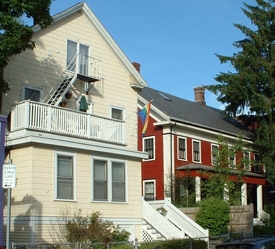 In 1874 the first standardized baseballs were manufactured at 39 Green Street, Jamaica Plain, by Louis Mahn. Photograph by Charlie Rosenberg.Special thanks to Joe Davis, former Johnson Bombers (baseball) and Johnson Classics (basketball) player who suggested this story and assisted with the research.
In 1874 the first standardized baseballs were manufactured at 39 Green Street, Jamaica Plain, by Louis Mahn. Photograph by Charlie Rosenberg.Special thanks to Joe Davis, former Johnson Bombers (baseball) and Johnson Classics (basketball) player who suggested this story and assisted with the research.
By Peter O’Brien
December, 2012
Baseball in Jamaica Plain Jamaica Plain’s baseball history goes way back to 1871, when Harry Wright and his brother, George, founded the Boston Red Stockings. The Red Stockings later became the Boston Braves. The Wrights were English cricket players who came to America and switched to baseball. Harry lived for a time on Pond Street, Jamaica Plain, and was an early inductee to the Baseball Hall of Fame.
Jamaica Plain’s baseball history goes way back to 1871, when Harry Wright and his brother, George, founded the Boston Red Stockings. The Red Stockings later became the Boston Braves. The Wrights were English cricket players who came to America and switched to baseball. Harry lived for a time on Pond Street, Jamaica Plain, and was an early inductee to the Baseball Hall of Fame.
In 1874 the first standardized baseballs were manufactured at 39 Green Street, Jamaica Plain, by Louis Mahn. Mahn later sold the patent for the ball to Albert G. Spalding, a co-founder of the National League in 1876 and founder of the sporting goods firm that still bears his name.
Leo Callahan was born in Jamaica Plain in 1890. He played from 1913 to 1919 for the Brooklyn Dodgers and Philadelphia Phillies.
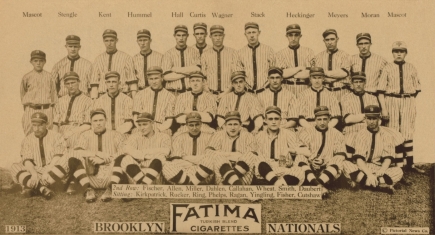 1913 Brooklyn Nationals. Leo Callahan is shown fifth from left in middle row of seated players.
1913 Brooklyn Nationals. Leo Callahan is shown fifth from left in middle row of seated players.
Babe Twombley was born in Jamaica Plain in 1896 and he played with the Chicago Cubs in 1920.
Johnnie Tobin was born in Jamaica Plain in 1906 and he played in 1932 for the New York Giants with just one major league at bat. 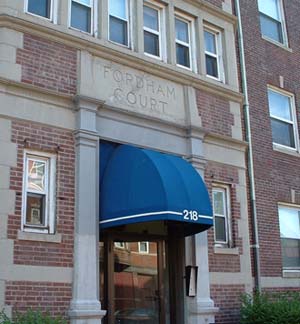 Fordham Court Apartments owned by Joseph Lanin in 1914In 1914 the owner of the Boston Red Sox, Joseph Lannin, owned the apartment complex known as Fordham Court on South Street, Jamaica Plain. There were rumored, but unconfirmed, reports of occupancy in the apartments by Tris Speaker and Babe Ruth.
Fordham Court Apartments owned by Joseph Lanin in 1914In 1914 the owner of the Boston Red Sox, Joseph Lannin, owned the apartment complex known as Fordham Court on South Street, Jamaica Plain. There were rumored, but unconfirmed, reports of occupancy in the apartments by Tris Speaker and Babe Ruth.
In 1929, the year the Boston Park League was started, St. Thomas of Jamaica Plain was the first League champion; a feat St. Thomas repeated again in 1931 and 1932. 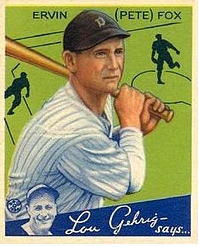 Courtesy of WikipediaErvin Pete Fox, former Red Sox player, lived on Carolina Avenue, Jamaica Plain, for a time in the 1950s. He often attended our CYO ball games at Murphy Playground on Carolina Avenue, Jamaica Plain, wearing the old-style Red Sox jacket.
Courtesy of WikipediaErvin Pete Fox, former Red Sox player, lived on Carolina Avenue, Jamaica Plain, for a time in the 1950s. He often attended our CYO ball games at Murphy Playground on Carolina Avenue, Jamaica Plain, wearing the old-style Red Sox jacket.
Eddie Waitkus of Cambridge, also known as “the natural,” played for the Phillies, Cubs and Orioles in the 1940s and 1950s. Waitkus was the victim of a shooting which is dramatized in Robert Redford’s movie, The Natural. Waitkus survived the shooting and lived until 1972 in Jamaica Plain.
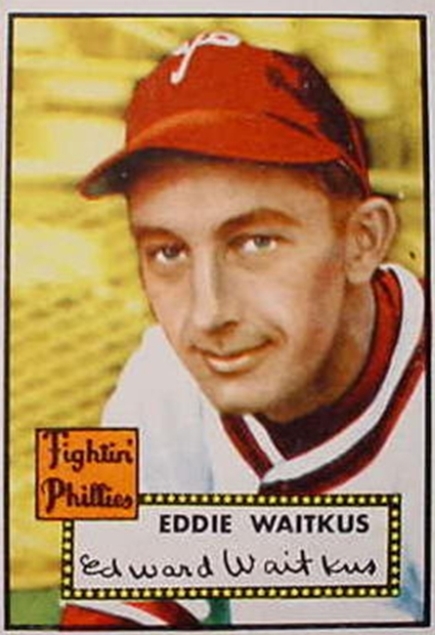 Eddie Waitkus
Eddie Waitkus
And then comes Red Johnson and his Johnson Bombers.
George T. “Red” Johnson
Red Johnson is a legend in the Boston Park League where his love of baseball, his players and the team he founded, the Johnson Bombers, consumed all of his free time and a good chunk of his hard-earned salary. We’re not sure when Red was bitten with the baseball bug, but he was driven to personally sponsor, fund and manage his teams over most of the 30 years he was active in the Boston Park League. He won a seventh-grade baseball award at the Agassiz School – perhaps that’s where it started?
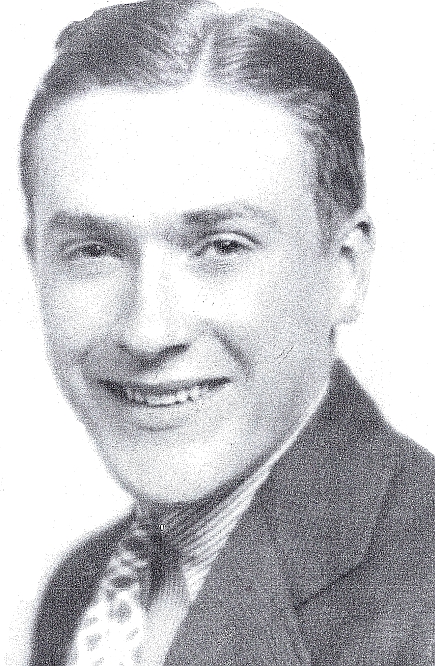 George T. “Red” Johnson. Date unknown. Courtesy of Mrs. Catherine Johnson.
George T. “Red” Johnson. Date unknown. Courtesy of Mrs. Catherine Johnson.
While never winning a Park League baseball championship, Red did bring home the gold in basketball, coaching the Johnson Classics to a championship season in the City Basketball League in 1962. In the end, and perhaps better than a winning baseball career, the “Red Johnson Alumni Award,” presented each year since 1982 by the Boston Park League to a selected former player, would please Red more than a shelf full of trophies. And his election to the Park League Hall of Fame that same year would be the ultimate recognition of his many years of helping to keep the league alive.
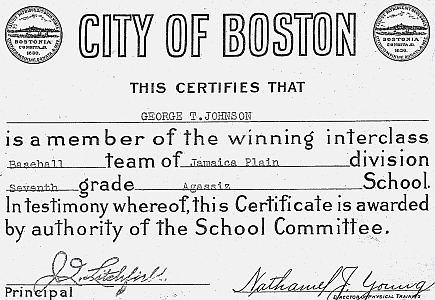 Red’s seventh grade Agassiz School award. Courtesy of Mrs. Catherine Johnson.
Red’s seventh grade Agassiz School award. Courtesy of Mrs. Catherine Johnson.
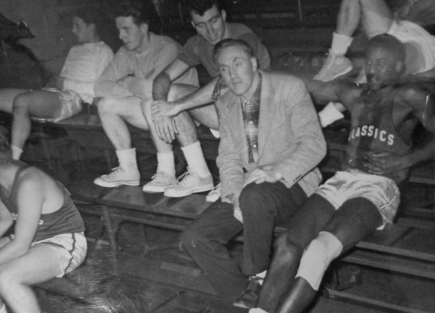 Red Johnson in civvies. Courtesy of Joe Davis.
Red Johnson in civvies. Courtesy of Joe Davis.
The Boston Park League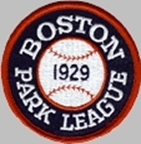 Boston Park League logo, courtesy of Boston Park League.The Boston Park League was founded in 1929 by Bob Cusick, program director for the Boston Parks and Recreation Department, and it is now the nation’s oldest amateur baseball league. It was Cusick’s idea for the City of Boston to support and manage a quality amateur baseball league, and have most of the City represented. Teams were sponsored by different individuals, businesses, and churches. He bought discarded Red Sox and Braves uniforms and hired unemployed professional umpires at three dollars a game, and was able to field ten teams to begin the Boston Senior Park League.
Boston Park League logo, courtesy of Boston Park League.The Boston Park League was founded in 1929 by Bob Cusick, program director for the Boston Parks and Recreation Department, and it is now the nation’s oldest amateur baseball league. It was Cusick’s idea for the City of Boston to support and manage a quality amateur baseball league, and have most of the City represented. Teams were sponsored by different individuals, businesses, and churches. He bought discarded Red Sox and Braves uniforms and hired unemployed professional umpires at three dollars a game, and was able to field ten teams to begin the Boston Senior Park League.
The popular league was highly publicized and games were well attended. In the 1930s and 1940s, it was not unusual to see 3,000 to 5,000 fans show up for a regular season game. At play-off time, the attendance would increase from 8,000 to 12,000 a game, and it is reported that one game at Fallon Field in 1933 drew 18,000 to see the Roslindale Town Team beat the Rosebuds.
The Boston Park League drew praise from such notables as Judge Kenesaw Mountain Landis, Commissioner of Major League Baseball from 1920 to 1944, who said it was “the best operated municipal baseball organization in America.” He demonstrated his support by attending the 1932 Boston Park League banquet along with other prominent baseball personalities.
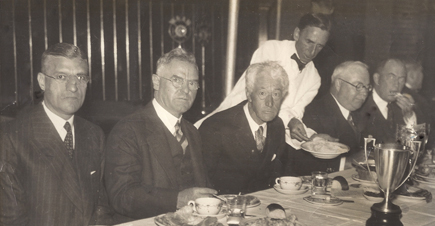 1932 Boston Park League Banquet. From L to R: American League President Will Harridge, Red Sox owner Bob Quinn, Commissioner of Baseball Judge Kenesaw Mountain Landis, Boston Parks Commissioner William Long, Boston Director of Recreation, William Mullen. Courtesy Mrs. Joan (Cusick) Morrissey
1932 Boston Park League Banquet. From L to R: American League President Will Harridge, Red Sox owner Bob Quinn, Commissioner of Baseball Judge Kenesaw Mountain Landis, Boston Parks Commissioner William Long, Boston Director of Recreation, William Mullen. Courtesy Mrs. Joan (Cusick) Morrissey
In the 1950s and 1960s, the League continued to draw 6,000 or more fans to post-season playoff games. These were the most productive years. Despite the leveling of attendance, the League continued to prosper as a steady stream of skilled players were coming and going. The players came from high schools, colleges and the professional ranks. The latter’s professional experience and skills influenced many a ballplayer to play in the best league around.
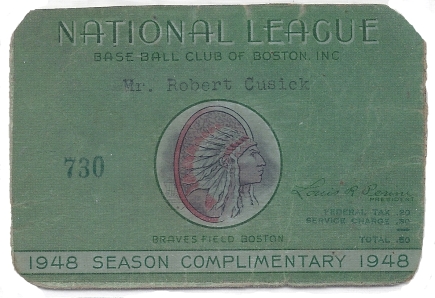 Bob Cusick’s Braves Field pass. Courtesy of Mrs. Joan (Cusick) Morrissey.
Bob Cusick’s Braves Field pass. Courtesy of Mrs. Joan (Cusick) Morrissey.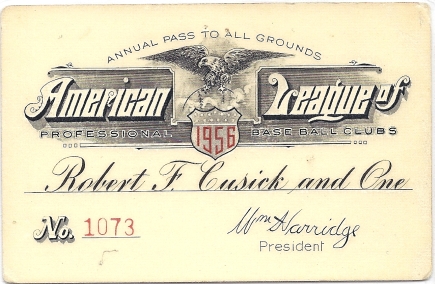 Bob Cusick’s Pass to All American League Ballparks. Courtesy of Mrs. Joan (Cusick) Morrissey
Bob Cusick’s Pass to All American League Ballparks. Courtesy of Mrs. Joan (Cusick) Morrissey
Over the years there have been several distinct Park League levels. While the criteria are lost to us, we know there were seven other levels besides the Senior Park League. They were: Industrial, City National, City American, Hub, Suburban, Dorchester and Business leagues.
In 1982 the City of Boston decided to transfer the League’s administrative duties to a small group of former players and coaches. The league named Bill Mahoney its first President, Harvey Soolman Secretary-Treasurer, and Walt Mortimer Umpire-in-Chief. Walt Mortimer is currently Secretary-Treasurer. With the need for more funding, the Budweiser Brewing Company of Medford sponsored the League for four years. The Yawkey Foundation came on board in 1986 and has continuously sponsored the Boston Park League to the present. Much more information about the Boston Park League can be found at their website, www.bostonparkleague.org.
Bob Cusick
Robert F. Cusick was born in 1907 in Fall River, Mass. He died, aged 82, in 1989. He attended Durfee High School where he played basketball, graduating in 1925. In 1929 he went to work for the Boston Parks Department under Parks Commissioner William Mullen. Soon after joining the City’s Parks Department, Cusick’s proposal for a Boston Park League was approved and he proceeded to set it up and preside over it from his office at the Pinebank Mansion on Jamaica Pond, until retiring in 1976 as Director of the Boston Parks and Recreation Department. Known as a “helluva guy” by Joe Cronin, Bob Cusick was the confidant of Ted Williams, Tom and Jean Yawkey, and other members of the Red Sox family for many years. He was known far and wide in professional baseball as “Mr. Baseball,” and was the owner of annual complimentary passes to all American League ballparks for many years.
Bob raised his family in West Roxbury, relocating to Cape Cod after he retired. Shortly after his retirement, Mayor Kevin White proclaimed September 12, 1976 as Bob Cusick Day, and named the baseball diamond on Boston Common, at Boylston and Charles Street, for him.
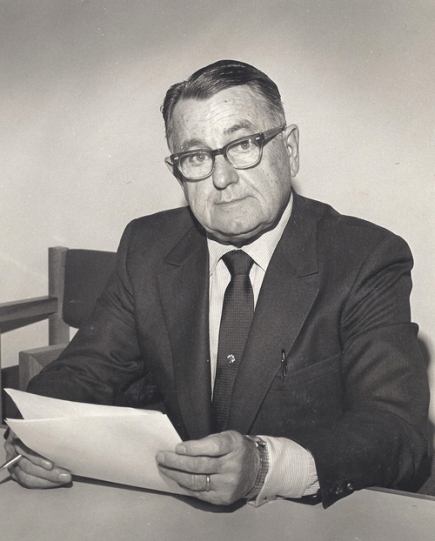 Bob Cusick, Director Boston Parks and Recreation Department. Courtesy of Mrs. Joan (Cusick) Morrissey
Bob Cusick, Director Boston Parks and Recreation Department. Courtesy of Mrs. Joan (Cusick) Morrissey
Countless thousands of Boston’s young and not-so-young men have found an organized outlet for their baseball “field-of-dreams” in the Boston Park League. They played for well over 100 different teams with the caliber of play at the top levels good enough to attract former and future professional players. Indeed, many former Park League players were signed by major-league scouts. Bob Cusick’s vision for amateur baseball in Boston was certainly fulfilled, and the present Park League administration continues that vision for Boston’s young men.
Until budget cuts in 1981, the City provided well-maintained fields, night-game lighting, paid umpires and a minimal level of equipment. Thereafter, the teams had to pay the umpires and an assessment for use of the fields. While now self-sustaining with the generous help of the Yawkey Foundation, it is interesting to note that the chairman of the Yawkey Foundation, John Harrington, and Bob Cusick’s daughter, Joan Morrissey of Norwood, are year-apart graduates of St. Thomas Aquinas High School in Jamaica Plain.
Red Johnson’s Beginnings
In researching this story, several of Red’s former players were interviewed. Few, if any, knew much about Red’s personal life, only baseball anecdotes related to his teams and players. The answer is simple; he never spoke about himself, his work, his family or his own playing days – it was always about the game of baseball and his players.
Red was born on February 8, 1914, in Dorchester. His parents were from Nova Scotia. He died in Boston of a heart attack at age 73 on December 11, 1987. Although he had moved to Newton in 1984, he was buried from St. Thomas Aquinas Church in Jamaica Plain on December 14, 1987. He is buried in plot 117 at The Gardens of Gethsemane Cemetery, 670 Baker Street in West Roxbury.
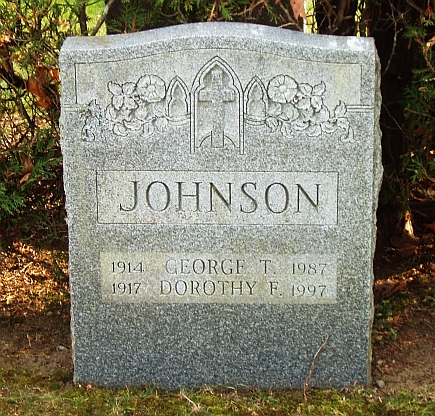 Red’s Gravesite at Gardens of Gethsemane Cemetery. Photograph courtesy of Peter O’Brien.
Red’s Gravesite at Gardens of Gethsemane Cemetery. Photograph courtesy of Peter O’Brien.
After 181 Sidney Street, Dorchester, Red is next reported, in 1930, at 3 Woolsey Square, Jamaica Plain. He married the former Dorothy F. Chaperon of Vermont and they lived from 1935 to 1940 at Vernon Street in Roxbury with his in-laws. During that period he was listed as an unemployed road laborer. From 1950 to 1960 the Johnsons lived at 2 Alfred Street in Jamaica Plain, until moving to 70 Green Street, just down the street from the home of the first standard major-league baseballs made a hundred years earlier, at 39 Green Street, Jamaica Plain. They next lived at 6 Everett Street, Jamaica Plain, until 1974. In 1981 they were located at 84 Dunster Road, Jamaica Plain, and in 1984 the Johnsons moved to 677 Winchester Street in Newton.
Red went to the Agassiz school in Jamaica Plain and completed two years of high school according to census records. He had two brothers, Joseph and Arthur, and both are deceased. Joseph was killed in action in WWII. The playground at the corner of Lamartine and Green Streets was named for Corporal Joseph E. Johnson in a 1960 ceremony with Mayor John Collins. Arthur Johnson’s widow, and Red’s sister-in-law, Catherine, who is shown in the Collins photo, graciously provided many of the photos in this piece.
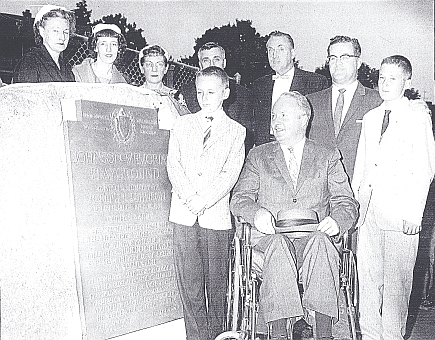 Mayor John Collins dedicating Johnson Playground. Rear L to R: Dorothy, Catherine, Helen, Arthur, and Red Johnson, Rep. James Craven, Joseph Johnson, a nephew. Another nephew, Robert Johnson, stands at the right of Mayor Collins. Courtesy Mrs. Catherine Johnson, the source of the clipping is unknown.Coach Johnson
Mayor John Collins dedicating Johnson Playground. Rear L to R: Dorothy, Catherine, Helen, Arthur, and Red Johnson, Rep. James Craven, Joseph Johnson, a nephew. Another nephew, Robert Johnson, stands at the right of Mayor Collins. Courtesy Mrs. Catherine Johnson, the source of the clipping is unknown.Coach Johnson
We think Red began his Park League coaching career about 1949 with a team called Trimont Tool. Trimont Manufacturing Company was located at 55-71 Amory Street in the old Rockland Brewery building from about 1902 to 1954. Trimont made heavy-duty wrenches and other pipe-fitting tools. They held several patents for wrenches and other devices. Trimo wrenches are EBay collectibles nowadays.
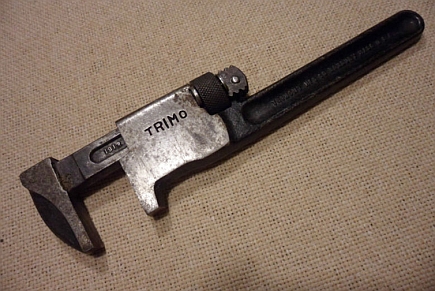 Trimo wrench. Courtesy of Fort Hill History by Jason Turgeon.
Trimo wrench. Courtesy of Fort Hill History by Jason Turgeon.
At some point Red negotiated blue-on-blue uniforms and limited support from the Company for his Trimont Tool team which was probably in the Industrial League, a notch or two below the Caseys, Royals, Saints, Crosbys, Crownburners, etc. in the Senior Park League. And with money from his own pocket, and occasionally exercising his home team prerogative of passing the hat, he kept us in clean baseballs, and a few un-taped bats. The author’s first hitch with Red was about 1952-3 with the Trimont team. Another contributor, Dick Mazzocca, played for Trimont also. Dick went on for another six years with the Park League’s Crosby Club after we served together in the Army in Japan.
We are guessing the Johnson Bombers was formed shortly before Trimont closed in 1954. This time Red must have dug deep in his own pocket to come up with uniforms as seen in this early Johnson Bombers photo, about 1954. 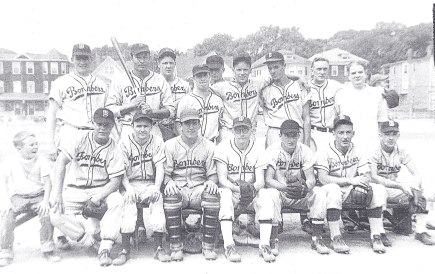 Johnson Bombers about 1954. Courtesy of Mrs. Catherine Johnson.
Johnson Bombers about 1954. Courtesy of Mrs. Catherine Johnson.
There is scant information available about Trimont Tool or the Bombers in the Park League as most records were lost. It is known, however, that despite finishing between fifth and seventh for twenty years, the Bombers had two players who made it to the big leagues: Richie Hebner and Skip Lockwood.
The Players Remember Red
Larry McNulty, a retired teacher/principal/coach, a Park League Hall-of-Famer and former New York Mets player, played for the Johnson Bombers from 1958 to 1961 and for Red’s 1962 championship basketball team, the Johnson Classics. Larry was struck by Red’s love of the game of baseball and his players, and his wife’s devotion to repairing the uniforms kept at their Green Street apartment where Larry visited frequently. Noting that Red never spoke about himself, Larry did, however, visit him at work at Beth Israel Hospital where Red was so obviously conscientious. “He was an inspirational leader, if not the most astute baseball coach.” He would, Larry recalls, wear out the grass at the third-base coach’s box as he exhorted the batter to “give-it-a-ride, give-it-a-ride.” Most importantly though, without children of his own, Red seemed to adopt his players and treated them like they were his own kids. He was one-of-a-kind.
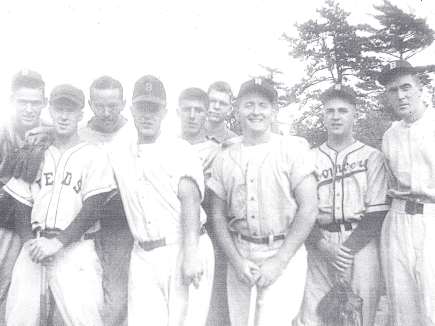 Red Johnson on far right with unnamed players. Courtesy of Mrs. Catherine Johnson.
Red Johnson on far right with unnamed players. Courtesy of Mrs. Catherine Johnson.
Jack Fahey, 83, of West Roxbury, played 26 years in the Boston Park League and was the 2011 Red Johnson Alumni Award recipient, and is another Park League Hall-of-Famer. Jack didn’t play for Red but knew him well and has heard many of the anecdotes connected with Red. He believes Red had a great eye for talent, excellent organizing skills (including finding sponsors), but Red’s baseball-managing skills were somewhat less, and so he never won a championship in the League. Jack recalled how Red enlisted Joe Coleman Sr., former Philadelphia Athletics pitcher, to manage the Johnson Bombers starting on May 11, 1959 at Fallon Field. Joe pitched an occasional game as well, and later managed the athletic programs at Walpole and Norfolk State prisons. Red also enlisted Gerry Leone, later coach at Franklin High School, who played until an ankle injury ended his playing days. Gerry’s son is now Middlesex County’s District Attorney. Jack also recalled Ornie Woods, a carpet layer, as another talented player Red recruited. And there were many others. Jack also visited Red’s apartment on Green Street and remembers the Bombers’ equipment neatly stored in barrels and boxes.
Joe Davis of Groveland lived on Forbes Street, Jamaica Plain, from 1959 to 1966. A retired Amtrak detective, he recalls playing baseball for the Johnson Bombers and basketball for the Johnson Classics in 1959-61, before entering the Army. His most vivid memory of Red is as a father figure to him and many others who played for him. Red loved baseball talk and remembering other players he had coached, easily recalling their names and particular baseball skills. Years after his Army service, Joe spotted Red at Fallon Field one evening and went over to say hello and Red greeted him like a long-lost son. Joe visited Red’s Green Street apartment also and saw the neatly-stored equipment and uniforms there. Joe’s class of 1958 at Jamaica Plain High has many friends of Red’s too, including Gerry Burke of Doyle’s Café. Red’s reputation carried him far and wide in Jamaica Plain.
Dick Mazzocca of Walpole is a retired Norwood business man and an eight-year Park League veteran from Jamaica Plain. He played for Red’s Trimont Tool team, and following his Army service in Japan, Dick returned to the Park League’s Crosby Club for six more years. Dick’s lasting memory of Red was his complete absorption with the game of baseball and his unabashed enthusiasm for each game, despite a pretty steady diet of losses. Dick says, however, Red never quit – he didn’t have it in him to quit.
Harvey Soolman of Medford won the Red Johnson Alumni Award in 2004. Harvey has been involved with the Park League for over 40 years as a player, coach and administrator. He is also a published playwright and an accountant. Harvey didn’t know Red but was playing while Red’s Bombers were still active and he remembers Red’s practice of driving around with give-away baseballs.
Boston Globe Newspaper Clippings
August 22, 1947. The Casey Club wons its opener with the Linehan Club, 3-1, before 5,000 at South Boston Stadium. Catcher Red Johnson drove in a single with a line drive to left field. Later, Johnson contributed a sparkling play to prevent a Linehan rally.
May 11, 1959. The Park League opened its 29th season that evening with former major leaguer Joe Coleman and George “Red” Johnson at the helm of the Johnson Bombers against the Boston Selkirks at Fallon Field, Roslindale.
March 30, 1961. Larry McNulty scored 31 points to lead the Johnson Classics to a 104-86 win over the Waltham Boy’s Club in the Class A semi-final of the 19th annual Waltham Boy’s Club Basketball Tournament.
March 31, 1961. The Wells Club of Somerville won the chance to meet the Boston Park League Basketball Champs, the Johnson Classics, in the finals.
March 20, 1962. Bill Foley and Bill Donovan led Newtondale Drug to a 115-89 Class A victory over the Johnson Classics at the Waltham Boy’s Club Basketball Tournament.
March 24, 1962. George Schlenhuber and Lennie Sorrin led the Johnson Classics to an 89-50 triumph over the Huntington YMCA in the 20th annual Waltham Boys Club Basketball Tournament at the Waltham Boy’s Club gym.
May 13, 1962. As the 32nd Park League season opened, the Johnson Bombers, with Red Johnson again handling the club, started a team made up mostly of newcomers against the Bottomly Club of Hyde Park at Fallon Field, Roslindale.
May 20, 1963. The future Mayor of Boston, Ray Flynn, threw a three-hitter against the Johnson Bombers for a 10-1 victory for the Supreme Saints in the first-ever Sunday Park League game.
August 1, 1965. Winning 12 of their last 14 games, the Johnson Bombers would be making the playoffs for the first time in Manager George Johnson’s 16 years of Park League play. The Bombers lost to the Connolly Club 5-1, but managed a 6-4-3 triple play in the game.
June 30, 1968. A lengthy Globe article said that there was no lack of brain power on the Johnson Bombers and the coach, a self-described “truck driver,” was not intimidated by the bright, articulate, kids on his team. On the contrary, they were all comfortable with each other despite a 7-8 record! The story reported the Bombers’ players with Princeton, MIT, Yale, Cornell, Harvard and Northeastern degrees. The degreed players were Phil DeSantis of Roxbury, Avi Nelson of Brookline, Geoff Weissman of New York City, Tom Argir of Natick, Wayne Rana of New York, Jim Hampe of Dedham, John MacGowan of Boston and Skip Cunningham of Boston, who the week before had earned only a tie in a no-hit, no-run game he pitched for the Bombers. Other (then) recent Bomber players included major-leaguer Joe Coleman, Sr., and Richie Hebner, the Norwood star who went on to a great major-league career. Red described himself as head of the motor service at Beth Israel Hospital during the day, while at night he was the Bombers’ owner, general manager, coach, scout, batboy, equipment manager, scorekeeper and groundskeeper.
November 25, 1979. In another lengthy article entitled “Remembering Boston,” several prominent Bostonians, including James Michael Curley, boxer Peter Fuller and other entertainers, remembered Boston. Red Johnson was also interviewed and he observed that after coaching semi-professional baseball for 30 years and playing before coaching, he opted to forego a rocking chair, a pipe and a pair of slippers so he could continue in some other capacity when he retired:
Back when he decided to become a coach, a lot of people told him he was wasting his time in sports and that he was not going to get anywhere. Red said to the reporters interviewing him, “Lookit, Howard Johnson makes twenty-eight flavors because people like different things, just as some of you guys like horses, some of you guys like dogs, some of you like music, and some like art. I happen to like sports and that’s why I’m in it. I didn’t drink, smoke or gamble but I took a liking to sports. Now when I was a youngster, if you went down to the local ballpark there’d be a game going in every corner. You had to get up early in the morning to find a place to play because there was so much interest in baseball. Of course, in those days there was no television, there were no automobiles, no drive-in theaters, and during Prohibition there were no barrooms. In other words, there were fewer things to do, so the youngsters turned to sports if they wanted some action.”
Red said he turned to sports because he liked it and the kids where he was brought up liked it too, and they had some pretty good athletes. Comparing the past with the (then) present, the sportswriters often asked his opinion about the kids he coached in 1979 and the kids he had coached thirty years previous. He told them the only difference was there were too many diversions – too many things for them to do at the present time, so that they tended to branch off into other areas. He thought the only real interest in baseball then (1979) was in the Spanish community, where they were deeply into baseball. When asked to umpire a (then) recent championship playoff series he was impressed with their sincerity compared to the (Caucasian) American kids. The Spanish kids dived into the bases head first and they got very emotional if they didn’t make a hit or if they made an error. He hadn’t seen that kind of enthusiasm for many years. Their genuine interest in baseball was evident when you spoke to them and they would say “viva pelota,” or “long live baseball!”
May 18, 1980. In an article noting the opening of the Park League’s 50th year, Red Johnson was named among the “angels” who kept the league going by running teams practically on their own.
April 1, 1981. An article describing the City’s withdrawal of financial support of the Park League, due to budget cuts, announced that lights would no longer be provided, umpires would be paid by the teams and the teams would be assessed a user’s fee for the use of the fields. Several managers were at a kick-off meeting and aired their concerns, along with their willingness to do whatever it took to keep the league functioning. “Dedication,” said George “Red” Johnson, a 30-year veteran of the league as a player, sponsor and manager. “I can’t refrain from contrasting the attitude of these guys with that of some of the prima donnas we know in higher places.”
Red Johnson at Beth Israel Hospital
Red was a driver/courier for Beth Israel Hospital from 1952 to his retirement in 1976. Their June 1976 internal newsletter, the BI Examiner, memorialized Red’s retirement with glowing tributes from staff and co-workers. Here are some of the accolades: Beth Israel’s talented man about town is retiring and will leave a gap roughly the size of the Grand Canyon. He doesn’t talk much about himself, but no one in the hospital has had such rapport with so many at so many levels. His daily rounds in the ’67 Ford van, in all weather and traffic conditions sometimes totaled fourteen stops, many times picking up snowbound key-employees, emergency lab deliveries, spare parts, the all-important mail and always making friends along the way. His driving skill in delivering a critically ill child to a neighboring hospital for emergency surgery was credited with saving the child’s life, and donning a Santa’s suit when B.I. had an in-patient pediatric unit was just another example of Red’s special concern for children.
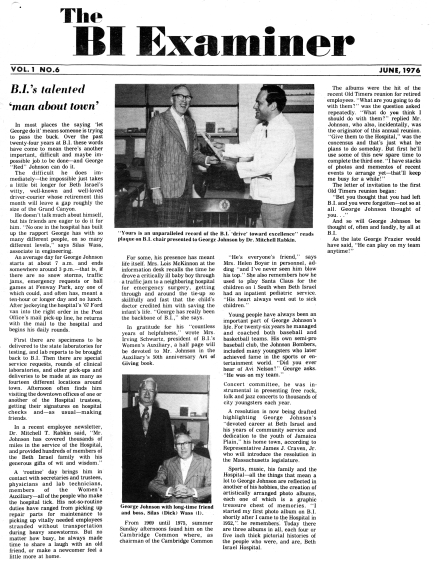 BI Examiner notes Red’s retirement, June 1976. Courtesy the Ruth and David Freiman Archives at Beth Israel Deaconess Medical Center.Another of Red’s avocations was the creation of artistically-arranged photo albums depicting the people who were employed at Beth Israel Hospital. There were three, five-inch thick albums in all, started just after Red was hired at B.I.in 1952. These albums were a hit at each of the Old-Timers reunions he organized for B.I. retirees. Red donated the albums to the hospital.
BI Examiner notes Red’s retirement, June 1976. Courtesy the Ruth and David Freiman Archives at Beth Israel Deaconess Medical Center.Another of Red’s avocations was the creation of artistically-arranged photo albums depicting the people who were employed at Beth Israel Hospital. There were three, five-inch thick albums in all, started just after Red was hired at B.I.in 1952. These albums were a hit at each of the Old-Timers reunions he organized for B.I. retirees. Red donated the albums to the hospital.
At Red’s Beth Israel retirement, Representative James J. Craven introduced a resolution in the Massachusetts Legislature highlighting George Johnson’s “devoted career at Beth Israel Hospital and his years of community service and dedication to the youth of Jamaica Plain,” his hometown. And, in recognition of Red’s service to the hospital, he was presented with an inscribed Beth Israel chair by Dr. Mitchell Rabkin. Red Johnson left a mark on Beth Israel Hospital and he will be thought of, often and fondly, by all at Beth Israel.
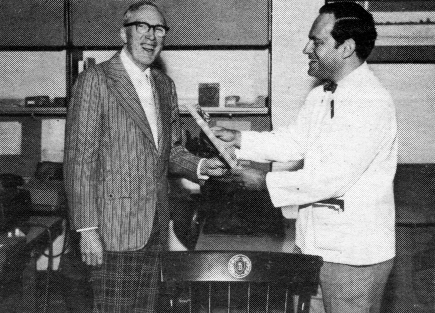 Dr. Mitchell Rabkin presents Red with his Beth Israel chair. Courtesy the Ruth and David Freiman Archives at Beth Israel Deaconess Medical Center.
Dr. Mitchell Rabkin presents Red with his Beth Israel chair. Courtesy the Ruth and David Freiman Archives at Beth Israel Deaconess Medical Center.
Life after Baseball
After retiring from the hospital and baseball, Red devoted himself to entertaining senior citizens at various retirement homes including Farnsworth House at 90 South Street, Jamaica Plain. Red was a one-man band called “Memory Lane Ballroom,” and he’d bring tambourines for the seniors to participate. Soon, true to his coaching instincts, he’d have them up dancing. He performed every Sunday for over ten years and seniors and administrators, including Dean Collotta, Property Manager of Farnsworth House, fondly remember Red Johnson and his tambourines to this day. Coincidentally, Dean Collotta also played in the Boston Park League.
Give-it-a-ride
Red Johnson was obviously a man driven by a love of baseball. And his post-baseball career, entertaining seniors, bespeaks a kind heart, with perhaps a bit of a showman’s love for the spotlight, a spotlight that, sadly, never found him in the winner’s circle in Boston’s amateur baseball world. Nevertheless, those who knew him, or played for or against him, or worked with him, never forgot him. He was truly one-of-a-kind, and he would “give-it-a-ride” in whatever he applied himself to. Jamaica Plain is proud to include his name in its baseball history.
References and Credits
1. Baseball in Jamaica Plain by Michael Reiskind, Jamaica Plain Historical Society.
2. Trimont Manufacturing Co. information courtesy Fort Hill History, a blog about Fort Hill/Highland Park by Jason Turgeon.
3. Boston Park League information courtesy Walt Mortimer and the Boston Park League.
4. Beth Israel “BI Examiner” excerpts courtesy of The Ruth and David Freiman Archives at Beth Israel Deaconess Medical Center and Michael Keating, Manager of Internal Communications, BIDMC.
5. Boston Globe archives, various dates.
6. …and thanks to Dick Mazzocca, Walt Mortimer of the Boston Park League, Harvey Soolman, Jack Fahey, Dean Collotta, Eunace Davis at The Gardens of Gethsemane Cemetery, Larry McNulty, Catherine Johnson, Scott Johnson, Gerry Burke, Joan (Cusick) Morrissey and many other Red Johnson fans.
Julia's Beauty Shoppe
Moore owns Julia’s Beauty Shoppe in Jamaica Plain, the oldest salon and one of the oldest businesses in Jamaica Plain. The shop, started by Moore’s mother, Julia Spagnoletti, has been a part of JP for 75 years, remarkable in a neighborhood known for its diversity and change.
The salon itself can be described by what it’s not: It’s not a trendy place that serves tea and lemonade with its haircuts, and it’s not a discount chain store that gets you in and out in 15 minutes or less. A simple black-and-white sign beckons customers.
“You’re not going to get your frills, you’re not going to get your thrills,” says Greg Moore, Elena’s son, who helps out on occasion.
Wood paneling and mirrors cover the walls. Plants hang in the window. A slight hint of cigarette smoke mixes with the scents of various hair solutions. Helmet- style hair-dryers line the back wall.
In the center of the side wall hang a few relics that, according to a hand- written note, belonged to Julia and date to 1938: a wood-handled hair dryer and a curling iron that had to be heated on a gas burner.
As Moore sits behind her counter, neighborhood regulars wave in the window or stop in to chat.
“Maybe,” she says, “they can talk old times.”
Jose Rivera, a longtime Jamaica Plain resident and regular customer, stops in to say hello. He assesses Moore this way: “You’re Ellie, that’s the best thing I can say.” After a slight pause, he describes the salon. “This is the place you have to be and you just sit and listen.”
Befitting that atmosphere, Moore prefers walk-ins to appointments.
“I don’t like to keep appointments,” she says. With walk-ins, “there’s no pressure. It’s more like having a big family serving supper.”
She says she keeps a fairly solid group of regular customers, mostly ladies who come in weekly or every other week to get their hair set. Helen Olsen, for example, estimates she’s been getting her hair done here for 40 years.
Moore was raised in the part of the neighborhood that is now the Bromley-Heath housing development. She says she practically grew up in the back of her mother’s shop, which started on the corner of Parker and Centre streets, then moved to the corner of Centre and Roseway streets.
The shop’s been at its current location near the Civil War monument on Centre Street for 32 years.
Moore politely declines to give her age but will say she is old enough to have three children, two grandchildren, and a great-grandchild; her husband, Thomas, died in 1994.
Given the modern decline in women getting their hair set weekly, business at the shop has slowed, and her regulars are getting older.
“Sometimes,” she says, “it looks like I’m running the geriatric ward.”
Times and styles have changed, says Moore.
“She used to have five girls in here” until 9 or 10 at night, says Greg Moore. “Then the sixties came.”
“Young people don’t pay as much attention to their personal appearance,” she says. “You can look out the window and see how many girls have long, unkempt hair, hair in ponytails, hair kept under a hat.”
Now Moore works by herself. If she’s not getting business, she’ll chat with neighbors who walk by, or go home early.
Nevertheless, she has no plans to hang up her brush and scissors. She says the shop keeps her active and connected with the community.
“She looks twenty years younger than all her friends,” says Greg.
“I hope she never retires.”
By Craig Nickels, Globe Correspondent
09/11/2005 Page 12, City Weekly Section
Copyright © 2005, Globe Newspaper Company
Used with permission.
Mail-Order House on Lamartine Street
A small bungalow at 281 Lamartine Street, built in 1940, is a rare, documented mail-order or “Readi-cut” house by the Aladdin Company of Bay City Michigan. The Aladdin Company was one of the longest-lived and most successful of the “Readi-cut,” “built-in-a-day” companies which flourished between about 1905 and World War II.
Sears Roebuck and Montgomery Ward – huge department stores whose catalogues revolutionized the American middle-class consumer culture and did more than anything else to create a common sense of being an American – were two other companies that offered complete mail-order houses; Sears started in 1908.
The Aladdin Company houses – featured in illustrated company catalogues – consisted of measured, pre-cut, and numbered pieces of lumber delivered by rail boxcar to a siding nearest the house lot. Customers would select a style from the illustrated catalogue and put in the order with a down payment. Customers could – and were encouraged to – make changes or adjustments to what they saw in the catalogue, and Aladdin architects would adapt those changes to preexisting designs. Everything from floor joists, rafters, plaster, shingles, millwork, nails and two coats of paint were provided. Between 10,000 and 30,000 pieces of lumber and other materials would be packed in one or two boxcars and shipped to the buyer within – as it was advertised – a week.
The Aladdin Company was formed in Bay City, Michigan, in 1906 by William and Otto Sovereign, who began as “knock-down” boat builders, using standardized, ready-made, cut and numbered pieces. They expanded this concept into boat houses, garages, and summer cottages. Beginning in 1908, Aladdin began publishing annual catalogues of the house styles and plans it offered; usually modest, one-story, but also larger, two-story homes. The company advertised in magazines like Good Housekeeping, National Geographic and The Saturday Evening Post. Aladdin emphasized the value of home ownership to the middle classes and the importance that home ownership meant to the family.
Aladdin had mills in Portland, Oregon and Bay City, Michigan on the edges of the great tree farms of Oregon and Washington State, as well as the north woods of Michigan, Wisconsin and Canada. For forty years, the mail-order house business provided a ready market for the great lumber barons.
Aladdin – like the others, especially Sears Roebuck – also pioneered the common national architectural styles: the bungalow, Cape Cod, gambrel roof and the four-square, all largely Colonial Revival styles. This also, over time, united the national mind: someone from Massachusetts traveling in Kansas would be comforted to see familiar house styles.
Aladdin’s biggest success – especially as individual house sales dropped in the 1930s – was with contractors who bought in bulk. It also supplied houses for company towns and military housing during World War II.
The house at 281 Lamartine Street was one of three adjacent Aladdin houses built by the McDonald Tinker Housing Corporation of Somerville; number 277 still stands, while the middle house was taken down. McDonald Tinker bought two vacant lots near Biltmore Street in 1939. This was originally the site of the Nicholas Broughton house, built by 1874 after Lamartine Street was completed in 1873. The 17,680-square-foot parcel was vacant and subdivided by 1914.
The three bungalow/prairie-style houses that McDonald Tinker built on the lots are not exactly shown in the 1939 catalogue, but several two-bedroom homes are similar, and clearly the contractor modified the plans. More than likely McDonald Tinker had a contract with Aladdin for houses on 1/4- or 1/2-acre lots in the metropolitan area.
Number 281 and its twin at number 277 were small, two-bedroom houses popular in the summer house section of the Aladdin catalogue, and probably marketed to newlyweds and the first time homebuyer.
The location was ideal: Lamartine Street was built in phases that connected the Jamaica Plain (Green Street), Boylston Street (Stonybrook), and Heath Street (Jackson Square) stations on the NYNH&H Railroad. The Jamaica Plain station had long sidings that served the Brookside area factories.
Aladdin guaranteed free shipping and delivery within five days, in carefully packed boxcars from its Bay City mills, to buyers east of the Mississippi. McDonald Tinker had three or four boxcars delivered to a siding, and transported to the three house lots. Aladdin did not provide foundation materials, in this case cinderblocks.
The 1939 catalogue, which McDonald Tinker may have used, offered forty-one house styles (mostly Colonial Revival), ten summer houses and six garage styles. All the houses from 1908 through the last one in 1958 had names, all firmly Anglo-Saxon, such as The Norfolk, The Roosevelt (Thoroughly American), The Hawthorn, The Plymouth, The Pilgrim, or The Birchwood.
It is difficult to document a mail-order house; occasionally a shipping label can be found on the backs of millwork of windows. The building permits for 281 and 277 Lamartine Street list the architect as the Aladdin Company of Bay City Michigan. The estimated cost of number 281 is listed as $3000. This is for materials and labor, but does not include land costs.
Aladdin required a down payment with monthly costs over seven years. McDonald Tinker certainly had bulk rate terms, but in 1939 a house similar to 281 Lamartine, called The Cedars, had a down payment of $158; the monthly charge was $18.63 spread out over seven years, which totaled $1564 or $1722 total.
Labor costs for McDonald Tinker were greatly lowered because all the lumber was pre-cut and measured, requiring no on-site cutting; complicated work such as stairways and rafters were cut and numbered by skilled carpenters in Bay City.
Business slowed for Aladdin after World War II, but it continued to offer catalogues until 1958, and pre-fabricated houses until 1981, family-owned until the end. Sears Roebuck closed its “Honor Bilt” house mills in 1940.
In February 2016 Nik Ligris bought number 281 Lamartine and the adjacent lot where the third house once stood. He proposed to take down number 281, combine the lots and build a three-story, six-family condominium with first-floor parking designed by David O’Sullivan.
Richard Heath, July 11, 2017
Bibliography
The principal source is The Clark Historical Library, Central Michigan University.
https://www.cmich.edu/library/clarke/ResearchResources/
A photo gallery of images related to this article may be found here.
Margaret Fuller School
Margaret Fuller School days,
Readin’ and writin’ and ‘rithmetic,
Taught with a smile and not a stick.
This was sung every Friday afternoon as we assembled on the inside staircase of the school, just before going home. I attended the Margaret Fuller School from September 1929 to June 1934. It was a red brick, two-story school located on Glen Road, very near Franklin Park. There were grades kindergarten through 5. When I first was a pupil there the fifth-grade class was located up the hill in an old Victorian house at the corner of Glen Road and Forest Hills Street.
The fifth grade occupied one room, on the first floor. There were no desks, just an assortment of straight-back chairs, and the pupils piled their books on the floor underneath. Coats were hung on hooks along one wall, and heat was provided by a stove in the middle of the floor. Did people complain? Of course not! In fact, we loved it when we went up there for a special program or something.
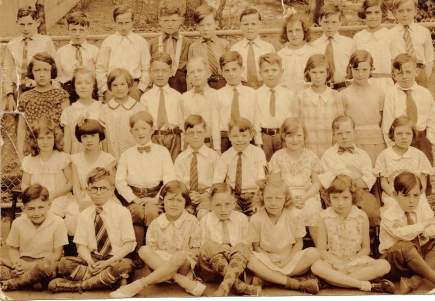 Photogaph of Dorothy Neagle Cook’s fourth grade class at the Margaret Fuller School. Dorothy is seen front row, second from the right, wearing a ribbon in her hair. A larger view of this photograph can be seen at: http://tinyurl.com/000mf
Photogaph of Dorothy Neagle Cook’s fourth grade class at the Margaret Fuller School. Dorothy is seen front row, second from the right, wearing a ribbon in her hair. A larger view of this photograph can be seen at: http://tinyurl.com/000mfIn about 1931 or1932, an addition was built on to the original school that allowed for a fifth-grade classroom – and two portables were erected next to the school. The empty lot next to the school that had served as the schoolyard was cleaned up, fenced in and cemented – prior to this we just played in that lot.
I remember the teachers well:
Kindergarten: Miss Sullivan (assisted by Miss Ferry – a pretty young lady, still in Teacher’s College)
Grade 1 (2 classes) Miss Carpenter (also the Principal), Miss Fitzgerald
Grade 2 (2 classes) Miss McPherson, Miss Buxton
Grade 3 (2 classes) Miss Friary, Miss Young
Grade 4 (2 classes) Miss Dorey, Miss Scully
Grade 5 (1 class) Miss Loughran
There was only one fifth-grade class because children living on the other side of Washington Street were required to attend the Bowditch School on Green Street for fifth grade.
Every Monday began with a general assembly. There was no auditorium, so we assembled in the kindergarten room. A large circle was painted on the floor, and the kindergarteners sat around this circle in sturdy little chairs. As a teacher played a stirring march, we filed in, class by class (one pupil in each class carrying the flag), and stood in our assigned places. After the Pledge of Allegiance and My Country ‘tis of Thee, the Bible was read – especially Psalm 24 (yes, the 24th, which we eventually memorized). There was a prayer and then we sang Come, Thou Almighty King. There were the usual announcements, current events, a special story or poem, and we all filed back to our classrooms. I should mention that the Bible was read every morning in each classroom, followed by a short prayer.Quite often James Michael Curley, Mayor of Boston, would attend our opening exercises and our plays. (I think he often worked from home, which was in Jamaica Plain instead of City Hall.)
When the school was enlarged the cloak rooms were removed and clothes cupboards built in the back of each classroom. These had folding doors with panels that became bulletin boards. In the weeks leading up to Christmas the teachers would get pictures (copies of famous religious paintings) from the public library, put them up on those bulletin boards, and we would learn the Christmas story. We also memorized those portions of the Scriptures. Then when Lent arrived pictures of Christ in the Garden of Gethsemane, the Crucifixion and Resurrection would be put up and we would learn those Bible stories, too. I remember vividly how the teacher explained the reason for the crucifixion, and the rapt attention of the children. We had children of all ethnic and religious backgrounds, but NO ONE ever complained. The parents, too, enjoyed these religious displays.
In the Margaret Fuller School we were taught not only the usual subjects, but also things that have lasted throughout our lives. Every Monday a “Memory Gem” was written on the blackboard which we recited each day, i.e., If at first you don’t succeed, try, try again; Remember to be kind; A habit is a cable: you weave a thread of it each day until it becomes so strong you cannot break it; and Practice makes perfect.
In my second-grade class, the teacher would bring in a piece of classical music which she would play many times, explaining what each “movement” meant. So, we learned a little music appreciation along the way. I remember Humoresque, The Flight of the Bumblebee, and Melody in F, among others.
We went home for lunch – and on Halloween we were allowed to return dressed in a costume – and there would be the teachers, also in costume, waiting for us in the schoolyard. We would then go room by room in our costumes.
At Christmastime, Mr. Robinet, the custodian, would erect a real tree in each classroom. We would decorate these with paper ornaments, and also the windows. The day before Christmas recess, we would go room to room singing Christmas carols and looking at their decorations. Then, as we left the school, each child was given a little box of Christmas candy (the kind tied with a string). The trees were discreetly given to children whose families otherwise would have had no Christmas tree.
One day after Christmas recess was “Doll Day” (even though the boys were involved, too), when in the afternoon we could bring a toy to school to show the class. A lot of these were homemade (especially doll clothes and trucks). Another fun time.
We had plays for Thanksgiving, Christmas, Easter, and very patriotic plays celebrating George Washington, Abraham Lincoln, and Betsy Ross.
With all of the above happiness you might wonder if we ever learned our lessons. Well, there were seldom any discipline problems – we loved our teachers and were more than willing to pay attention during our studies, knowing that “good times were ahead.” There were rules, of course. Slingshots were not allowed, but once in a while one would appear sticking out of some boy’s pocket. These were immediately confiscated and put in the bottom drawer of the teacher’s desk. On the last day of school they would be returned to their owners with the admonition to “never bring it to school again.” Fighting was never allowed – boys who might get into a fight went to the Principal’s office. Whatever happened there was nothing compared to what would happen when they got home!
Rewards were given out for good work – usually a pretty sticker placed on the paper – and for a special, special thing there was “The Fairy Box” – a tin box on the shelf in the teacher’s closet, and the happy child would be allowed to take out something – usually a tiny piece of candy. However, one day I was especially good and my reward was a tiny wedge of CHOCOLATE CAKE!
One day when I was in the second grade, the teacher came in with a large box wrapped in white tissue paper and covered entirely with red and green string, each piece knotted. (It must have taken forever for the teacher to do this.) She told us there was something very special inside to be shared by all the class. She explained that every time one of the pupils did something very nice, displayed good manners, held the door for a girl/lady, was kind or helpful, that child could snip off one of the strings and when they were all snipped off, she would open the box. Well! Talk about good manners! Talk about being helpful! Talk about being kind! The great day finally came and the box was opened – with all those eager little eyes fastened on the treasure inside. All-Day-Suckers!!!!! Lollipops that none of us ever had, that really lasted all day – and from the fanciest store in Boston (S.S.Pierce) no less! Each child was given one of these HUGE candy treats. What a day! (Mine was in the shape of a rocking horse, lemon flavor).
Of course there were the down-sides of school. We had monthly “head checks” for little critters, yearly physical exams, and monthly dental check-ups. Hardly anyone had a private dentist, so we poorer children were taken to the Forsythe Dental School down in the Fenway, which scared us to death. However, when you finally received that little pin which said “My Teeth Are Perfect,” it was worth it all. (The dental work, cleaning and bus ride cost the big sum of 5 cents!)
In the winter of 1929-1930 they offered inoculations for diphtheria. My mother signed the papers giving her permission. The day for the shots arrived and we were all herded into a big room. No one had ever had a shot before so panic prevailed. Children were screaming and throwing tantrums – the teachers were beside themselves. And the doctors didn’t help matters with trays of needles displayed for all to see. I was practically paralyzed with fear, but you can be sure I’d never scream like that, not even if they were taking me to the gallows. Well, the nurse said, “Here’s a brave little girl who’s not afraid. She’ll go first to show you that it doesn’t hurt.” So, I was first to get the shot (probably the first kid in the school district). There were three injections in the series – and when each time came for another shot the nurse would call my classroom and say, “Send that brave little girl down to show the others that there is nothing to fear.”
We had monthly trips to the Children’s Museum (then located on the far side of Jamaica Pond). What an exciting day that was! We were allowed to choose our own partner instead of the one assigned for every day, and we could take a snack. We walked, with the teacher leading the way – quite a walk, too! – down Glen Road, the whole length of Green Street, across Centre Street, the whole length of Myrtle Street, and then down Moraine Street where we would stop beside Mayor Curley’s house. He would always come out to talk to us, and then call his daughter Mary to come out and bring her dogs to show the children. Finally, we’d reach the museum, where there was always a wonderful program – and then the long (but enjoyable) walk back to school.
On the first day of school each child was given a green pencil (no eraser) and this was used every day until it was just a stub – then you were given a new one. We were also given a box of letters and a box of colored pegs (to use in learning arithmetic). In grade 2 we began to use ink – with a black dip pen.
One day we would arrive at school to see the round holes at the top of our desks fitted with a little inkwell – then the teacher would carefully fill each one with ink – and we’d be taught the perils of fooling around with anything as messy as ink. We each had to bring a little cloth thing to wipe our pen points with – my mother made mine, about 3 inches round, out of grey wool, pinked the edges, and sewed a tiny red button on top. Real pretty – I kept it for years.
Even the last day of school each June was a fun day. We would bring rags and polish to school and proceed to scrub and polish our desks – so things would look nice for the next year’s class. Each afternoon throughout the year the windows were closed, the shades drawn in an even line and any papers on the floor were put in the wastebaskets. We were taught to take pride in our classrooms.
I look back on those days as among the happiest days of my life. We were mostly poor, but you don’t miss what you never had. People shared clothes – and we took care of them knowing that another child would eventually be wearing them, too. We even looked forward to “our turn” to wear something pretty that another girl was wearing. There was no shame or criticism. It was a time of caring and sharing.
And we made it! Out of those classes came policemen, firemen, postmen, politicians, secretaries, nurses, teachers, priests, ministers – even a couple of doctors! World War II played a prominent part in the lives of us all – the boys serving on battlefields from the islands of the South Pacific to the Arctic to the devastated cities of Europe – and the girls in munitions factories and shipyards. And finally home to seek the American Dream.
Moxie Soda Outsold Coca-Cola
 If you go to the super market and examine the soft drink shelves, it will take a good bit of luck to find that particular New England soft drink - Moxie - that was based here in our neighborhood for twenty-five years.
If you go to the super market and examine the soft drink shelves, it will take a good bit of luck to find that particular New England soft drink - Moxie - that was based here in our neighborhood for twenty-five years.
Moxie is older than Coca-Cola and Pepsi-Cola. From 1928 to 1953 it was made at 74 Heath Street at “Moxieland”, as the plant and headquarters was called. It may look like a cola or root beer, but the original taste was not like any other soft drink. People either loved it or thought it was the worst stuff they had ever tasted. It had a distinct, strong medicine taste, and in its best year of 1920 it outsold Coca-Cola.
Augustin Thompson created Moxie in Lowell in 1876, about ten years before Coke. He was a medical doctor who brewed up a mixture of Gentian root extract, cinchona, sassafras, caramel and other flavorings to make “Moxie Nerve Food”. It was billed as a medicine which can “recover brain and nervous exhaustion; loss of manhood, imbecility and helplessness. It has recovered paralysis, softening of the brain, locomotor ataxia and insanity”. Moxie Nerve Food, like all early soft drinks in America, was first created as a medicine, not a recreational drink.
Carbonated beverages started out as cures thousands of years ago, and can be traced back to the Greeks and Romans who thought water could treat ailments. Cold and hot baths and steam rooms aided the curative process long ago and still do today. Hot springs with dissolved chemicals and minerals were thought to be restorative, and health “spas” were popular in Europe as places to “take the water cure”. The natural carbonation in some of these springs helped digestion and other ailments and people began to drink the water as well as sit in it. These “tonics” invigorated, refreshed and increased the body tone of their quaffers.
After the US Civil War, pharmacists began to add medicinal roots and herbs to produce a more curative drink. Sugar was often added to counter the bitterness of these concoctions and to make a better-tasting drink. These medicinal tonics developed into today’s soft drinks and New Englanders still call them tonic and get them at the corner spa. Moxie Nerve Food, named by Dr. Thompson after the American Indian Moxie Falls in Maine, became New England’s tonic.
Thompson expanded his Nerve Food to a beverage soft drink and bottled it in 1884. (This date is still printed on every Moxie container.) The drink was an enormous hit at the St. Louis World Fair in 1904. When the Pure Food and Drug Act of 1906 was passed, Moxie Nerve Food became simply Moxie and no more outrageous claims were allowed. But the soft drink Moxie thrived under Thompson and an entrepreneur partner, Frank Morton Archer. He sent eight-foot model bottles around the country pulled by horses or trucks, and they visited more than 40,000 towns. Of course, the drivers were called Moxie Men.
In 1916, Archer came up with an advertising idea that he called the Moxie Horsemobile: He mounted a dummy horse onto a car chassis and fixed the controls to enable the driver to sit in the saddle and operate the automobile. Everywhere they went, crowds appeared and followed the Moxie Man in the “Moxiemobile”. Within four years of the invention of the Moxiemobile, Moxie was outselling Coca-Cola. Even to this day, the Moxie Man appears on every Moxie label.
Moxie’s advertising played up the drink’s bitterness. They said “It’s the drink for those who are at all particular” and “What this country needs is plenty of Moxie”. The name began to be imitated by Proxie, Noxall, Modox, Rixie, Noxie, No-Tox, and Toxie soft drink companies. Frank Archer added a Moxie Song, celebrity endorsements, and more advertising and the company grew. The word “moxie” entered the English language as another word for spirit or verve.
In 1928, the company moved to 74 Heath Street near Jackson Square and called their factory Moxieland. Dr. Thompson’s sons, Frank E. Thompson and Harry A. Thompson were president and treasurer, and Frank Archer was chairman. Visitors were welcome to visit the plant at Heath, Bickford, and Parker Streets to see the mile of conveyer belts and 150,000 cases of Moxie and Pureoxia Ginger Ale all around them. If they couldn’t visit personally, they could watch a movie Frank Archer had made showing all the steps in production and emphasizing the quality and care taken at the plant.
When the Depression started, the Moxie Company decided to cut back on advertising everywhere, including New England. That was a mistake, and they began to lose out to the present national leaders Coke and Pepsi. In 1953, Moxie moved to Needham Heights, and the Boston Housing Authority demolished the Jamaica Plain factory to build the Bromley Park Housing Development. The company produced the short-lived Ted’s Root Beer in 1959 named after the Red Sox star Ted Williams, and was a leader in the sugar-free soft drink era when almost half of its output in the late 1960s was Diet Moxie. But by then, the company had been on a decline for almost forty years and was just a regional New England seller.
Moxie was taken over in 1967 by new management, and purchased the NuGrape Company of Atlanta and moved down to Georgia in 1968. In Georgia the company known as Moxie-Monarch-NuGrape produces NuGrape, SunCrest, Kist, Nesbitt’s, and Grapette soft drinks nationwide, as well as Moxie, which is still primarily for New England. A disastrous reformulation in 1968 lost them half their customers in New England, and they went back to “old fashioned Moxie” soon after, but this current recipe is not the same as the real heavy and tangy old Moxie.
And so, raise a glass of real Moxie to the local drink that swept the country and left its name in the language as “the spirit of America…a word for the audacity of the movers and shakers who continue to change the world.”
Sources: Tchudi, Soda Poppery, The History of Soft Drinks in America, New York, 1986; Potter, The Moxie Mystique, Newport News, Virginia, 1981.
See the Moxie Photo Gallery: http://www.jphs.org/photogallery/moxie/21317923
Copyright © 1995 Michael Reiskind
